Microsoft RH-3 Dual-Band CDMA Phone User Manual Manual Sprint
Microsoft Mobile Oy Dual-Band CDMA Phone Manual Sprint
Contents
- 1. Manual Nokia
- 2. Manual Sprint
Manual Sprint
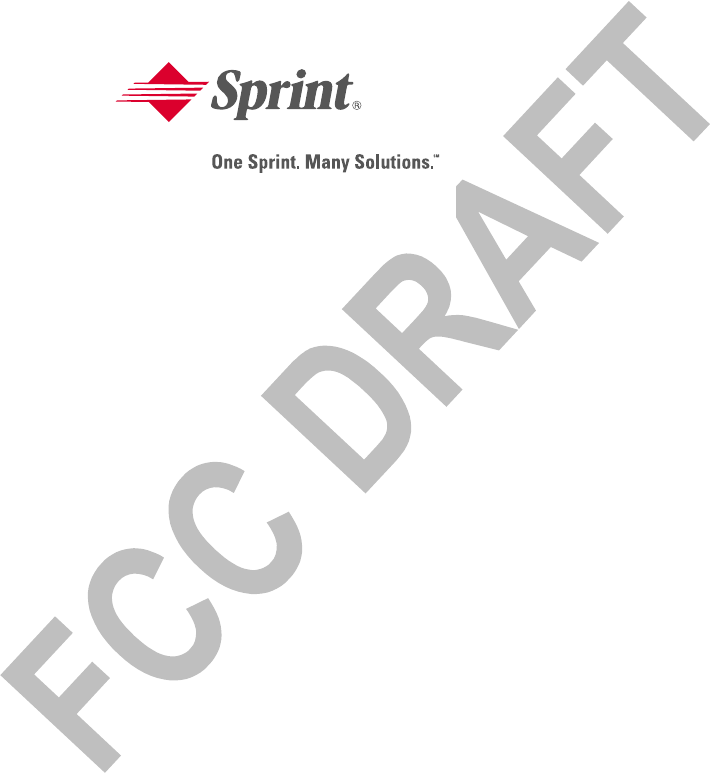
www.sprintpcs.com
Copyright © 2003 Sprint Spectrum L.P. All rights reserved. No reproduction in whole or in part
allowed without prior written approval. Sprint, the diamond logo, and all other trademarks listed
herein are registered trade marks of Sprint Communications Company, L.P., used under license. Nokia,
Nokia 2285, and Pop-Port are trademarks or registered trademarks of Nokia Corporation. All other
product and company names metntioned herein may be trademarks, service marks, or trade names of
their respective owners.
Printed in Canada


Table of Contents
How to Use This Guide . . . . . . . . . . . . . . . . . . . . . . . . . . . . . . . . . . . . i
Getting Advanced Phone and Service Information . . . . . . . . . . ii
Getting Started . . . . . . . . . . . . . . . . . . . . . . . . . . . . . . . . . . . . . . . . . . . 1
Basics of Your PCS Phone . . . . . . . . . . . . . . . . . . . . . . . . . . . . . . . . 15
1. Your New PCS Phone . . . . . . . . . . . . . . . . . . . . . . . . . . . . . . . . 16
Your Phone’s Features . . . . . . . . . . . . . . . . . . . . . . . . . . . . . . 17
2. Turning Your Phone On and Off . . . . . . . . . . . . . . . . . . . . . . . . 18
Turning Your Phone On . . . . . . . . . . . . . . . . . . . . . . . . . . . . 18
Turning Your Phone Off . . . . . . . . . . . . . . . . . . . . . . . . . . . . 18
Holding Your Phone Properly . . . . . . . . . . . . . . . . . . . . . . . . 18
3. Using the Battery and Charger . . . . . . . . . . . . . . . . . . . . . . . . 19
Installing and Removing the Battery . . . . . . . . . . . . . . . . . . . 19
Charging the Battery . . . . . . . . . . . . . . . . . . . . . . . . . . . . . . . 20
4. Making and Answering Calls . . . . . . . . . . . . . . . . . . . . . . . . . 22
Making Calls . . . . . . . . . . . . . . . . . . . . . . . . . . . . . . . . . . . . . . 22
Calling Emergency Numbers . . . . . . . . . . . . . . . . . . . . . . . . . 22
Answering Calls . . . . . . . . . . . . . . . . . . . . . . . . . . . . . . . . . . . 22
Signal Strength . . . . . . . . . . . . . . . . . . . . . . . . . . . . . . . . . . . . 22
5. Controlling Your Roaming Experience . . . . . . . . . . . . . . . . . 23
Setting Your Phone’s Roam Mode . . . . . . . . . . . . . . . . . . . . . 23
Setting Call Guard . . . . . . . . . . . . . . . . . . . . . . . . . . . . . . . . . 24
Feature Availability . . . . . . . . . . . . . . . . . . . . . . . . . . . . . . . . . 24
6. Internal Phone Book . . . . . . . . . . . . . . . . . . . . . . . . . . . . . . . . . 25
Saving Phone Numbers . . . . . . . . . . . . . . . . . . . . . . . . . . . . . 25
Finding Phone Numbers . . . . . . . . . . . . . . . . . . . . . . . . . . . . 26
Making a Call From Your Internal Phone Book . . . . . . . . . . . 26
7. Changing Your Phone’s Settings . . . . . . . . . . . . . . . . . . . . . . . 27
Setting Your Phone’s Security . . . . . . . . . . . . . . . . . . . . . . . . 27
Changing Your Welcome Note . . . . . . . . . . . . . . . . . . . . . . . 27
Adjusting Volume During a Conversation . . . . . . . . . . . . . . . 28
Adjusting Tone Settings . . . . . . . . . . . . . . . . . . . . . . . . . . . . . 28
Changing Phone’s Language Settings . . . . . . . . . . . . . . . . . . 29
TTY Use With PCS Service From Sprint . . . . . . . . . . . . . . . . 30

8. Sending and Receiving Messages . . . . . . . . . . . . . . . . . . . . . 31
Setting Up Voicemail . . . . . . . . . . . . . . . . . . . . . . . . . . . . . . . 31
Retrieving Voicemail Messages . . . . . . . . . . . . . . . . . . . . . . . 31
Accessing Voicemail From Another Phone . . . . . . . . . . . . . . 31
Displaying Numeric Pages . . . . . . . . . . . . . . . . . . . . . . . . . . . 31
9. PCS Service Features . . . . . . . . . . . . . . . . . . . . . . . . . . . . . . . . 32
Call Waiting . . . . . . . . . . . . . . . . . . . . . . . . . . . . . . . . . . . . . . 32
Call Forwarding . . . . . . . . . . . . . . . . . . . . . . . . . . . . . . . . . . . 32
Three-Way Calling . . . . . . . . . . . . . . . . . . . . . . . . . . . . . . . . . 32
PCS Voice CommandSM . . . . . . . . . . . . . . . . . . . . . . . . . . . . . . 33
Using Your Phone’s Internal Voice Commands . . . . . . . . . . 34
10. Your Phone’s Special Features . . . . . . . . . . . . . . . . . . . . . . . . 35
Alarm Clock . . . . . . . . . . . . . . . . . . . . . . . . . . . . . . . . . . . . . . 35
Calendar . . . . . . . . . . . . . . . . . . . . . . . . . . . . . . . . . . . . . . . . . 35
To-do List . . . . . . . . . . . . . . . . . . . . . . . . . . . . . . . . . . . . . . . . 36
Voice Recorder . . . . . . . . . . . . . . . . . . . . . . . . . . . . . . . . . . . 37
Calculator . . . . . . . . . . . . . . . . . . . . . . . . . . . . . . . . . . . . . . . . 37
Currency Converter . . . . . . . . . . . . . . . . . . . . . . . . . . . . . . . . 38
Location Info Sharing . . . . . . . . . . . . . . . . . . . . . . . . . . . . . . . 39
11. Accessories for Your Phone . . . . . . . . . . . . . . . . . . . . . . . . . . 40
How to Order . . . . . . . . . . . . . . . . . . . . . . . . . . . . . . . . . . . . . 41
12. Performance and Safety . . . . . . . . . . . . . . . . . . . . . . . . . . . . . . 42
Important Information About Your Phone and Service . . . . 42
Maintaining Safe Use of and Access to Your Phone . . . . . . . 43
Caring for the Battery . . . . . . . . . . . . . . . . . . . . . . . . . . . . . . . 46
Acknowledging Special Precautions and the FCC Notice . . 47
13. Terms and Conditions & Warranty Information . . . . . . . . . . 48
Terms and Conditions of Services . . . . . . . . . . . . . . . . . . . . . 48
Nokia One-Year Limited Warranty . . . . . . . . . . . . . . . . . . . . 66

i
How to Use This Guide
Welcome — you’ve made the right choice
The advantages of Sprint are as clear as each wireless call
you make. With PCS Service, we give you what you really
want from a wireless service provider – clear calls, easy-to-
understand service plans, and self-servicing options for
managing your account. All this is designed to make your
life easier and worry free.
We know you’re eager to start using your phone right away
and this guide is divided into two sections that are
designed to help you do just that.
The first section will guide you through the steps
required to set up your PCS Service. It includes
blanks so you can write down important information that
you’ll want to remember. Things like your new PCS Phone
Number, information about your service plan, and your
first invoice.
The second section will guide you through the
basics of your phone and service with quick,
easy-to-follow instructions. And if you want to learn more
about your phone, just visit us online at www.sprintpcs.com
and log on. Then, click on "Claire’s Directory for Service
Solutions." There you’ll find a complete phone user’s
guide that includes all the advanced features of your phone
and service.
1
2

ii
Getting Advanced Phone and
Service Information
This guide covers the basics, but your Nokia 2285 phone is
capable of performing a variety of advanced services. To
learn how to use all the advanced features of your phone
and service, visit www.sprintpcs.com and log on. Then, click
on "Claire’s Directory for Service Solutions." There you’ll
have access to your complete phone User’s Guide and you
can also take an online phone tutorial.
Your online phone User’s Guide provides information on
basic and advanced features and services, such as:
䊳Learning Advanced Dialing Options
䊳Managing Call History
䊳Using Advanced Messaging
䊳Using Advanced Internal Phone Book Options
䊳Using Your Phone’s Advanced Settings
䊳Setting Your Phone’s Security
䊳Using the Personal Organizer
䊳Understanding Your Phone’s Internal Menu
䊳And more

1
Getting Started
Activating and Using PCS Service

2
Getting Started
1
Have these things ready before you
call to activate
•Your PCS Phone (Make sure it’s fully charged)
•Your Social Security number or your driver’s license
number
•Your Electronic Serial Number (also known as ESN; refer
to step 5 to locate the number)
•The city and state where your phone will be primarily used
•A pen
2
Setting up your service — You
choose the way
The two fastest ways:
•Visit us online at activate.sprintpcs.com.
•From your PCS Phone, press .
You c a n als o :
•Use a phone other than your PCS Phone – dial
1-888-715-4588.

3
Getting Started
3
PCS Service Areas
Interested in where you can use your new phone?
Check out the most up-to-date coverage maps at
www.sprintpcs.com.
4
Your PCS Account Password
My Account Password is: _______________________
You ’ll use this number when managing your account
on www.sprintpcs.com and with PCS Customer Service
Solutions. Your default password is the last four digits of
your Social Security number.
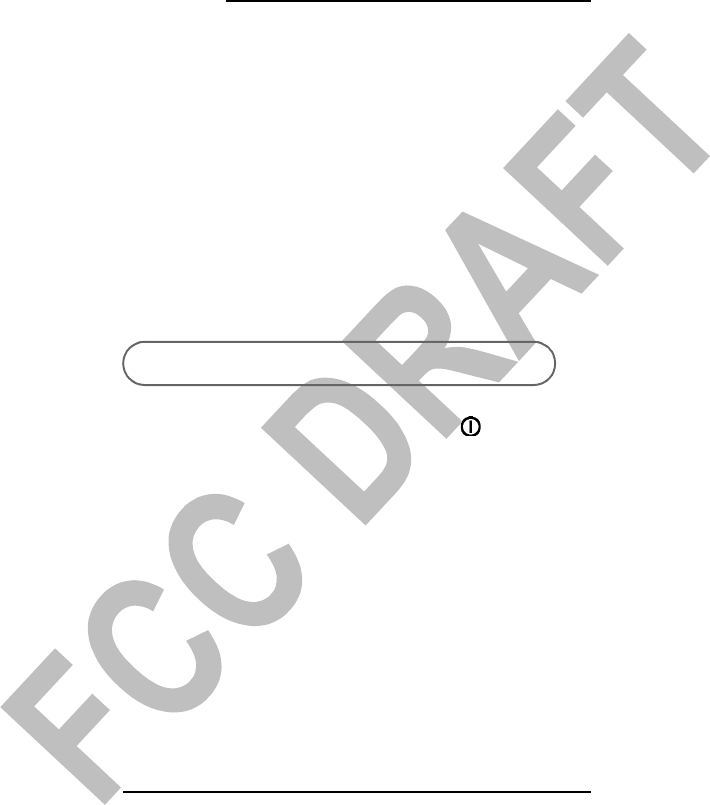
4
Getting Started
5
Finding Your Phone’s ESN
If you set up service using your PCS Phone, the network
automatically communicates the ESN to us. You’ll only
need this number when you’re setting up service online
at activate.sprintpcs.com or calling us from a phone other
than your new PCS Phone. The ESN, or Electronic Serial
Number, is an 11-digit number written on the barcode
sticker attached to the phone. To find it, remove the
phone’s battery.
ESN: _________________________________________
After writing down the ESN, replace the battery and
turn on your phone by holding down the key for a
few seconds.
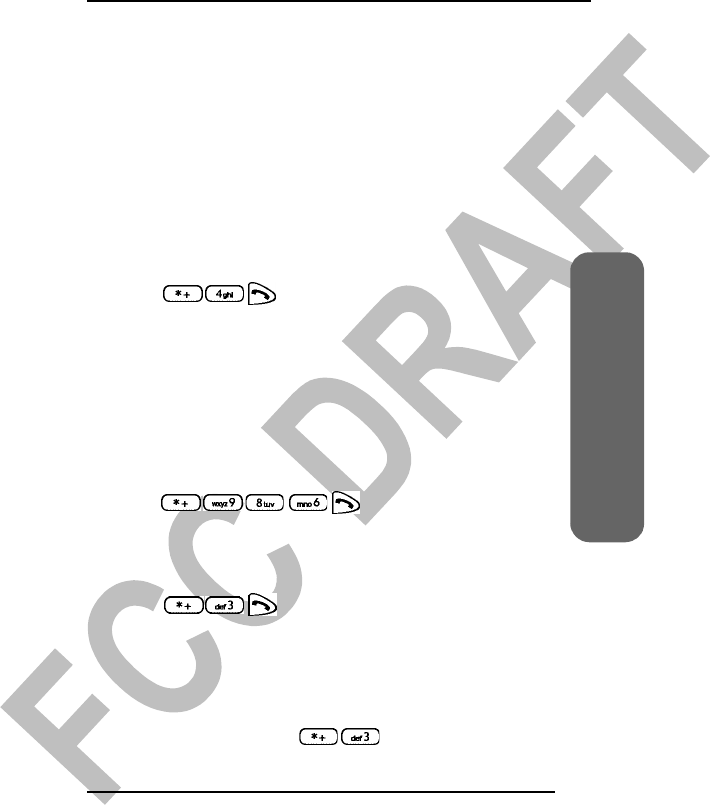
5
Getting Started
6
PCS Clear Pay Program
(This section may not apply to you. If not, skip to section 7.)
䡺You are on the PCS Clear Pay Program.
Easy steps to follow to help keep you enjoying your new
PCS Service
•Dial from your PCS Phone (normal
airtime charges will apply) or log on to www.sprintpcs.com
to find out how many minutes you have currently used
within your service plan. If you have exceeded the
minutes in your plan or you have a past due balance, you
should make a payment to keep your service turned on.
There are two easy payment options:
•Make a payment at any Western Union location
using the Swiftpay form. To find the nearest location,
dial from your PCS Phone.
(Transaction fee applies; payment is credited to your
account within 12 hours.)
– or –
•Dial from your PCS Phone (posting time
is 12 hours).
How we will help you keep your service turned on:
•In the event that your service has been turned off, you
will receive a text message stating: "Your PCS Service has
been turned off. Press to make a payment and
turn service on."

6
Getting Started
•The first time your service has been turned off you will
be connected to a live PCS Clear Pay Program Specialist
who will explain why your service has been turned off.
You will be asked to pay your balance to get your service
turned back on (payment will be credited and service
turned back on within 12 hours).
•For any additional times that your service has been
turned off, you will be connected to our automated
payment process. You will have to pay your balance to
have your service turned back on (payment will be
credited and service turned back on within 12 hours).
7
Understanding Your PCS Service Plan
Voice Usage: PCS Free & Clear Plans
Total Voice Minutes in my PCS Free & Clear Plan: ___
•Anytime Minutes:_____________________________
•Night & Weekend Minutes
(M-Th 9pm-7am, F 9pm-M 7am): ________________
Monthly service charge: $ ______________________
Each additional voice minute (overage): __________¢
Other: _______________________________________
Long distance is included in my plan: 䡺 Yes 䡺 No

7
Getting Started
Voice Usage: PCS Free & Clear Area-Wide Plans
Total Voice Minutes in my PCS Free & Clear
Area-Wide Plan: ________________________________
•Anytime Minutes:_____________________________
•Night & Weekend Minutes
(M-Th 9pm-7am, F 9pm-M 7am): ________________
Monthly service charge: $ ______________________
Each additional voice minute (overage): __________¢
Other:________________________________________
Long distance is included in my plan: 䡺 Yes 䡺 No
Per-minute charge for calls made while traveling
outside my extended calling area: _______________¢
Per-minute charge for roaming calls: _____________¢
Note: Your agreement for wireless service with Sprint is made up of
the Service Plan you choose and the Terms and Conditions of
Service which can be found on page 48 of this guide.

8
Getting Started
PCS Vision Usage
䡺 Your plan includes PCS Vision.
Megabytes included in plan: ______ (sent or received)
Per kilobyte overage: ______ (sent or received)
䡺 Your plan includes PCS Vision and you have opted to
subscribe to additional megabytes at $______ per month.
This includes ______ additional megabytes (sent or
received).
Per kilobyte overage: ______ (sent or received)
䡺 Your plan does not include PCS Vision, but you have
opted to subscribe to megabytes in addition to your
voice plan.
Additional monthly service charge for megabytes:
$______
Megabytes in plan: ______ (sent or received)
Per kilobyte overage: ______ (sent or received)
䡺 If you do not choose one of the plan options listed
above you can access PCS Vision on a casual basis at a
default rate of ______ per kilobyte. In addition, you will
be charged a download fee.

9
Getting Started
PCS Advantage AgreementSM:
䡺 I have agreed to a PCS Advantage Agreement.
___ 1 Year
___ 2 Year
䡺 I have opted not to sign a PCS Advantage Agreement.
$______ Monthly fee
Additional options I choose to subscribe to:
䡺 PCS Voice Command at $______ per month
䡺 PCS Add-a-PhoneSM at $______ per month
䡺 PCS to PCS CallingSM at $______ per month
䡺 PCS Equipment Replacement at $______ per month
䡺 Roadside Rescue at $______ per month
䡺 Sprint® Residential Long Distance
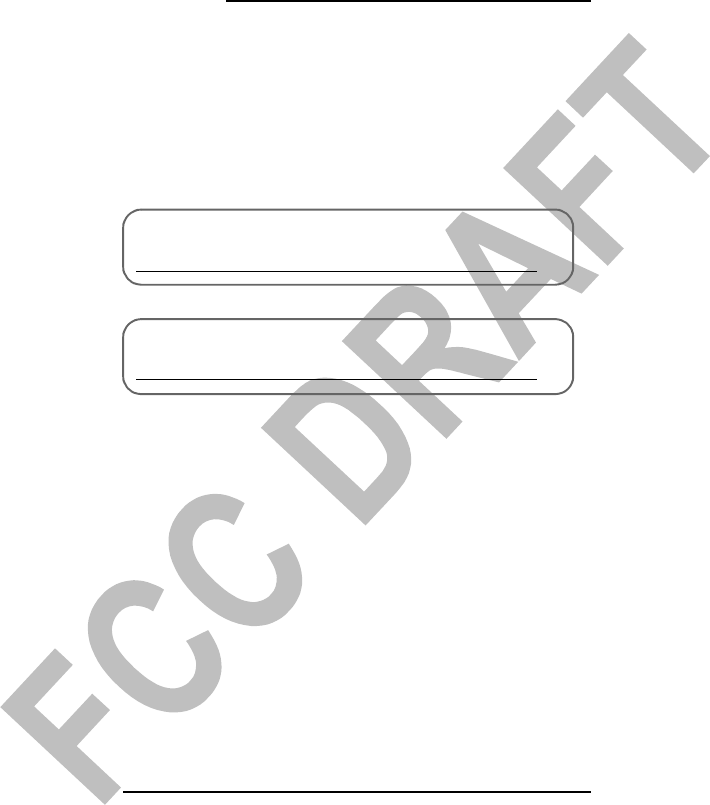
10
Getting Started
8
Your New PCS Phone Number and
User Name
PCS Phone Number
PCS User Name
Your user name is automatically assigned to you. Your
user name, which resembles an e-mail address (for
example, name@sprintpcs.com), is used with PCS E-mail
and two-way messaging services.

11
Getting Started
9
Understanding Your PCS Invoice
•Your first invoice will arrive within a few days.
•Your first invoice will reflect the following charges:
䡺Your first full month of service, which is your
monthly recurring charge of $______
䡺Additional charges such as taxes, roaming,
voice or data overage, or premium data services
䡺Charges for additional options you opt to
subscribe to: $______
䡺Your one-time non-refundable activation
fee of $______
•Approximate total of first invoice $______

12
Getting Started
10
Quick, easy options to manage
your account
With PCS Customer Service Solutions, you can visit
www.sprintpcs.com or use your PCS Phone to access
Claire, your virtual service representative. She’ll guide
you to the information you need.
Visit www.sprintpcs.com
Once you log on, you can:
•View the details of your PCS Service Plan
•Find out how many minutes you have used and how
many minutes are remaining in your plan
•View your current and previous three months invoices,
including the call detail
•Click on "Claire's Directory For Service Solutions" to:
•Make a payment
•Find out about PCS Products and Services
•Learn how to set up your voicemail and more
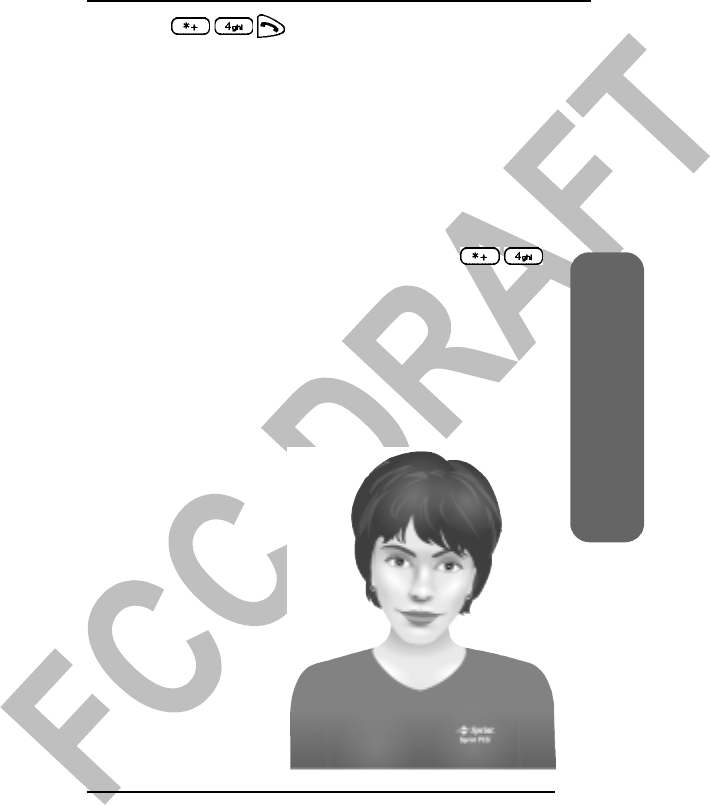
13
Getting Started
Press on your PCS Phone and Claire will
respond with the following:
•A summary of your rate plan
•Minutes and/or megabytes remaining in your plan for the
current invoice cycle
•Information about your most recent invoice
•When your last payment was received
•The option to make a payment
*Normal airtime charges will apply when calling .
Welcome and thank you for choosing Sprint.

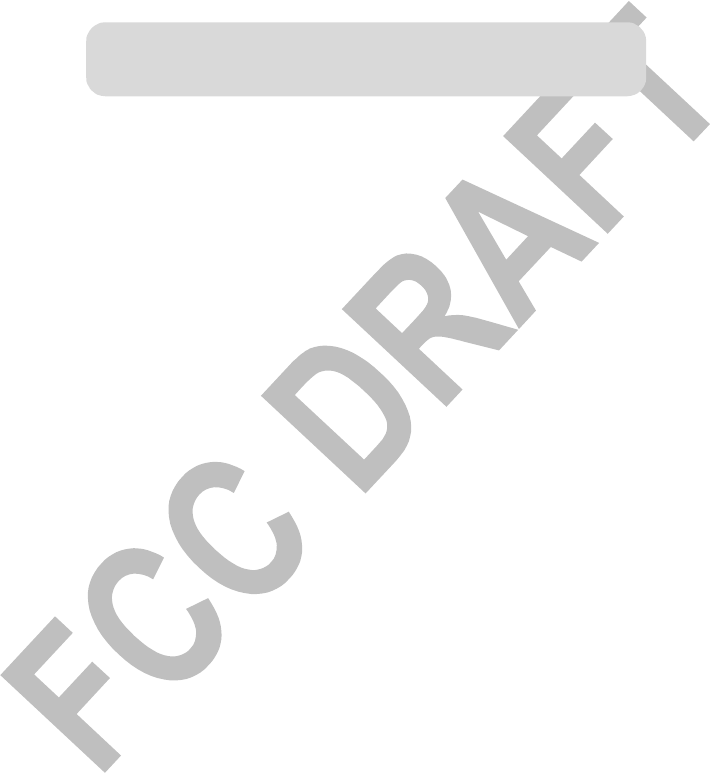
15
Basics of Your PCS Phone
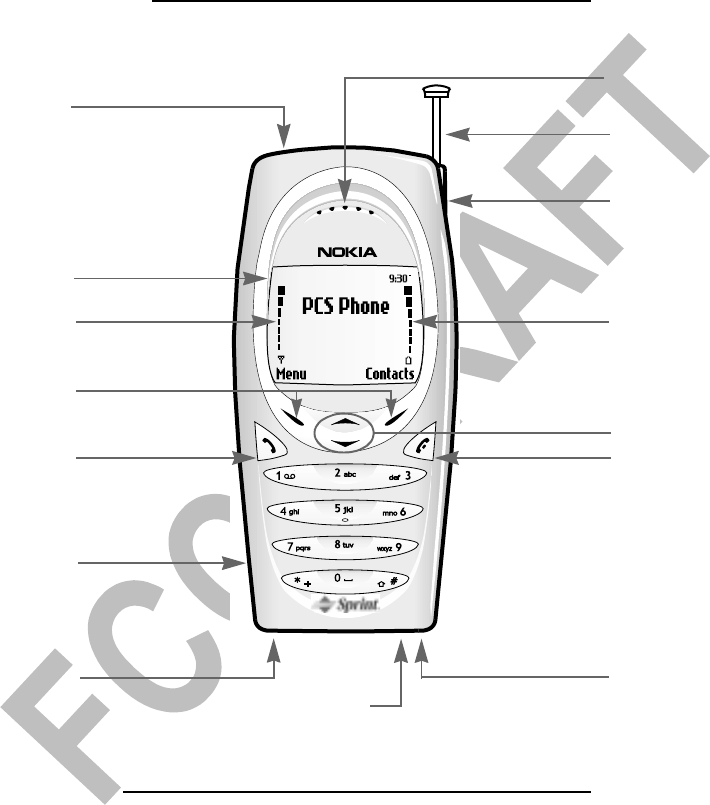
16
Basics
Your New PCS Phone
3. Signal Indicator
5. Talk Key
7. AC Adapter Jack
14. Whip Antenna
10. End Call Key
9. Nokia Pop-PortTM
Accessory
Connector
4. Left/Right
Selection Keys
6. Speaker Port
1. Switch On/Off Button
2. Display Screen
8. Microphone
12. Battery Strength
Indicator
13. Headset Jack
11. Up/Down
Scroll Keys
15. Earpiece

17
Basics
Your Phone’s Features
1. Switch On/Off Button: Switches your phone on or off.
2. Display Screen: Displays phone status icons and menu
items.
3. Signal Indicator: Indicates current signal strength.
4. Left /Right Selection Keys: Allow you to select actions or
items within certain menu screens.
5. Talk Key: Lets you place or answer a call.
6. Speaker Port: Lets you hear phone tones and ringing
tones.
7. AC Adapter Jack: Connects phone to battery recharger.
8. Microphone: Transmits voice.
9. Nokia Pop-PortTM Accessory Connector: Provides connection
to your personal computer or laptop computer and car kit,
as well as to other accessories.
10. E nd C all Key: Ends calls and clears text from display
screen.
11. Up/Down Scroll Keys: Scroll through menu screens,
highlight menu items, or navigate through your
calendar.
12. Battery Strength Indicator: Indicates current battery
strength.
13. Headset Jack: Provides connection for a universal
2.5-mm headset.
14. Whip Antenna: Extendable antenna that increases
reception in weak-signal areas.
15. Earpiece: Allows you to listen to voice and prompts.
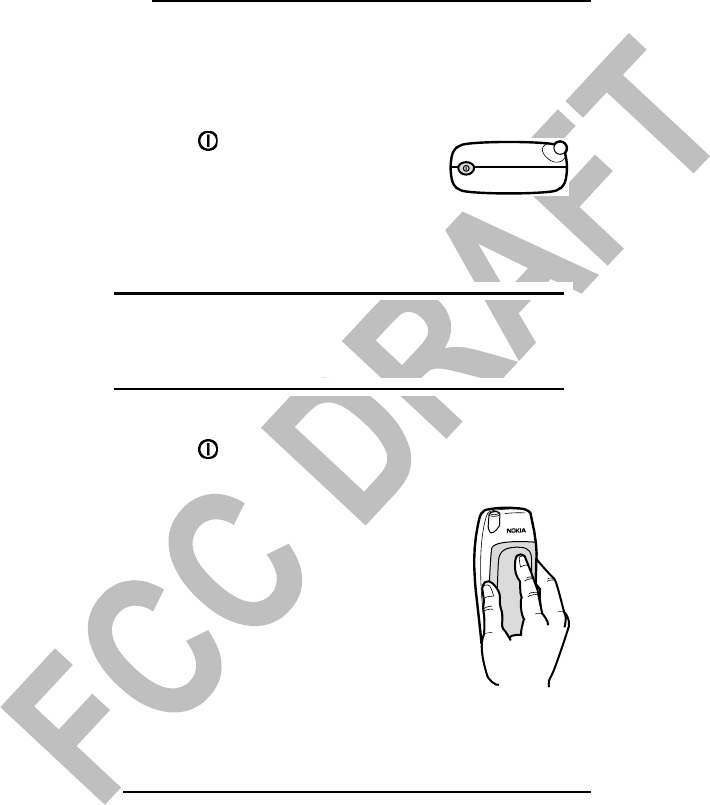
18
Basics
Turning Your Phone On and Off
Turning Your Phone On
1. Fully extend the antenna to receive the best reception.
2. Press for two seconds. The
phone will display the “Searching for
Service” message until it locates a
signal, then it will automatically
enter standby mode – the phone’s idle state. At this
point, you’re ready to begin making and receiving calls.
Note: After switching on your phone, you can bring up the Profiles
menu by pressing the on/off button for 1 second. For more
information on Profiles, refer to “Controlling Your Phone’s Settings”
in the Online User’s Guide.
Turning Your Phone Off
䊳Press for two seconds until the “Powering off”
message is displayed.
Holding Your Phone Properly
Hold your phone by placing your index
finger on the finger grip on the back
cover. This facilitates optimal reception
by preventing your hand from obstructing
the internal antenna.

19
Basics
Using the Battery and Charger
Installing and Removing the Battery
To install or replace the battery, or to access your phone’s
electronic serial number (ESN), you must first remove the
phone’s back cover.
䊳To remove the phone’s back cover, press and hold the
release button while sliding the cover downward
towards the bottom of the phone.
䊳To install the battery, insert the battery (label side up)
into the opening on the back of the phone and gently
press down until the battery snaps into place.
Warning: Do not puncture or burn the battery. Recycle or dispose
of the battery properly.
Important: Switch the phone off before removing the battery.
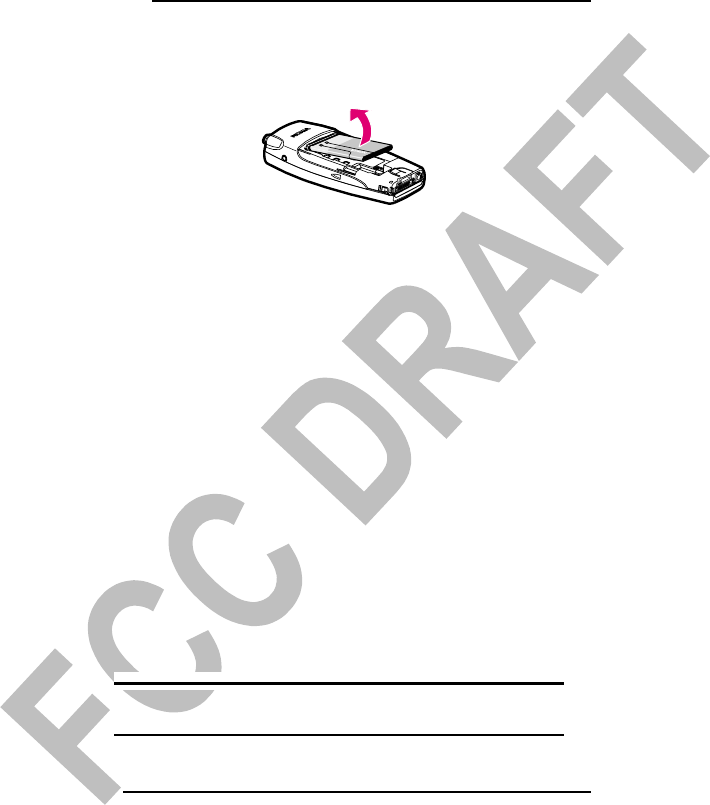
20
Basics
䊳To remove the battery, make sure the power is
switched off. Pull upward on the lower end of the
battery with your finger tip and remove the battery
from the phone at a 45-degree angle.
Charging the Battery
To use the charger:
1. Plug the electrical prongs into the wall outlet first, then
plug the round end of the AC adapter into the desktop
charger (or directly into your phone’s AC Adapter
Jack).
2. If the round end of the AC adapter was plugged into
the desktop charger, place the phone in the desktop
charger. If the phone is on, the screen briefly displays a
“Charging” message followed immediately by a
continuous scrolling battery indicator. If the phone is
off, only the scrolling indicator is displayed.
After approximately 2 hours, when the battery is charged,
the screen displays the “Battery full” message, and the
indicator stops scrolling. To charge the battery to
maximum capacity, charge for an additional 2 hours, then
unplug the phone from the charger.
A completely empty battery takes approximately 4 hours
to fully recharge.
Note: For best performance, charge the battery for 24 hours before
using the phone for the first time.

21
Basics
Warning: Use of unauthorized accessories could damage your
phone and invalidate your warranty.
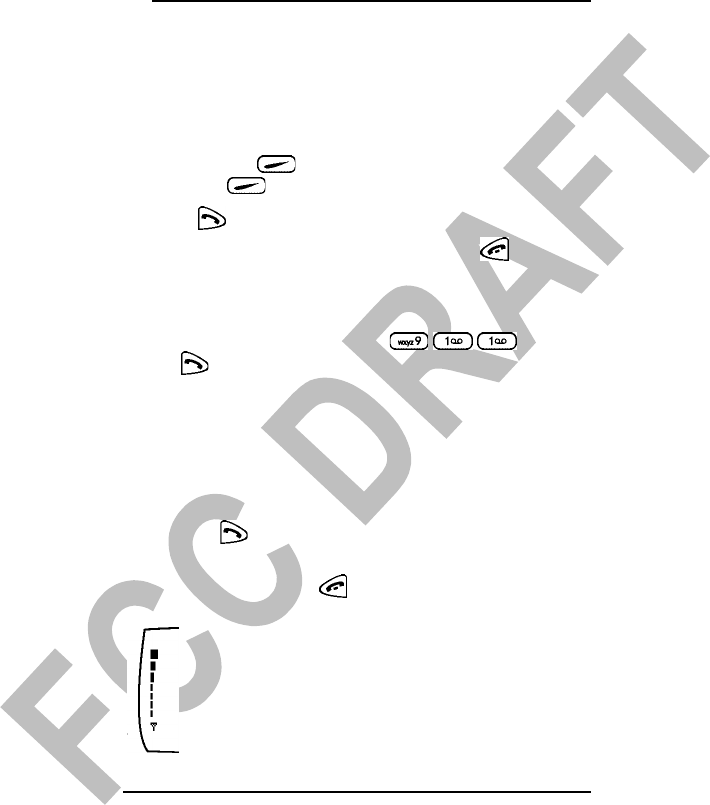
22
Basics
Making and Answering Calls
Making Calls
1. Make sure your phone is on.
2. Enter a phone number. (If you make a mistake while
dialing, press to erase one digit at a time or press
and hold to erase the entire number.)
3. Press .
4. When you are finished with the call, press to end
the call and return to standby mode.
Calling Emergency Numbers
You can place calls to 911: press , then
press (even if your phone is locked or your account
is restricted).
Answering Calls
1. Make sure your phone is on. If your phone is off,
incoming calls go to voicemail.
2. When your phone rings or vibrates, answer the call by
pressing (or pressing any key if the Anykey feature
is activated).
3. To end the call, press or press End Call.
Signal Strength
Call quality is always best when the antenna is
fully raised. If you’re inside a building, being near
a window may give you better reception. You can
see the strength of your signal by the signal
indicator on your phone’s display screen.

23
Basics
Controlling Your Roaming Experience
Your phone is dual-band, which means you can make and
receive calls while on the enhanced Sprint Nationwide
PCS Network and you can also roam on other networks
where we’ve implemented roaming agreements with
other carriers. To learn more about roaming, visit
www.sprintpcs.com.
Your phone has several features that let you control your
roaming experience.
Note: Roaming automatically occurs if your phone is set to
Automatic, and roaming rates apply whenever the signal roams
while making a call. The roaming mode that you have selected stays
intact even after you have switched your phone off.
Setting Your Phone’s Roam Mode
1. From the standby mode, press Menu, scroll to Settings,
and press Select.
2. Scroll to Roaming and press Select.
3. Scroll to Set Mode and press Select.
4. Scroll to your preferred mode and press Select.
䊳Sprint: Lets you make and receive calls only on the
enhanced Sprint Nationwide PCS Network and
prevents roaming.
䊳Automatic: Searches for alternate wireless networks
when PCS Service is not available.

24
Basics
Setting Call Guard
Call Guard reminds you when you are making or
receiving a roaming call and requires you to take
additional steps before placing or answering roaming
calls. These additional steps are not required when you
make or receive calls while on the enhanced Sprint
Nationwide PCS Network.
To Activate or Deactivate Call Guard:
1. From the standby mode, press Menu, scroll to Settings,
and press Select.
2. Scroll to Roaming and press Select.
3. Scroll to Call Guard and press Select.
4. Scroll to On or Off and press Select.
5. Press to return to the standby mode.
Call Guard remains activated until you manually
deactivate it as described above.
To Place Roaming Calls With Call Guard On:
1. From the standby mode, dial 1+area code+seven digit
number and press .
2. Select Roam Call.
To Answer Incoming Calls With Call Guard On:
Highlight Answer and press .
Feature Availability
䊳You can make and receive calls while roaming.
䊳You will have access to voicemail while roaming.
䊳Other features which are standard on the enhanced
Sprint Nationwide PCS Network, such as Call Waiting,
PCS Voice Command and PCS Vision are unavailable
while roaming.

25
Basics
Internal Phone Book
Saving Phone Numbers
1. From the standby mode, enter a phone number.
2. Press Options.
3. Scroll to Save and press Select. The Name: box appears.
4. Enter a name using the alpha keypad, and press OK.
5. Press Options and follow the prompts to modify or
categorize this number:
䊳Add voice tag allows you to create commands for voice
activated dialing.
䊳Edit number lets you modify the number.
䊳Delete number lets you remove the number (not the
entire entry) from your phone book.
䊳View allows you to view the number.
䊳Change type lets you categorize the number.
䊳As primary no. lets you designate this number as the
primary number displayed when you call up this entry.
䊳Add number lets you add another number to this entry.
䊳Add detail lets you add other contact information to this
entry.
䊳Caller groups lets you categorize this entry to a specific
group.
䊳Custom tone lets you assign a specific tone to this
number that sounds whenever this caller calls you.
䊳1-touch dialing lets you assign a specific key to this
number to enable speed calling by pressing this key.
䊳Edit name lets you modify the name of the entry.
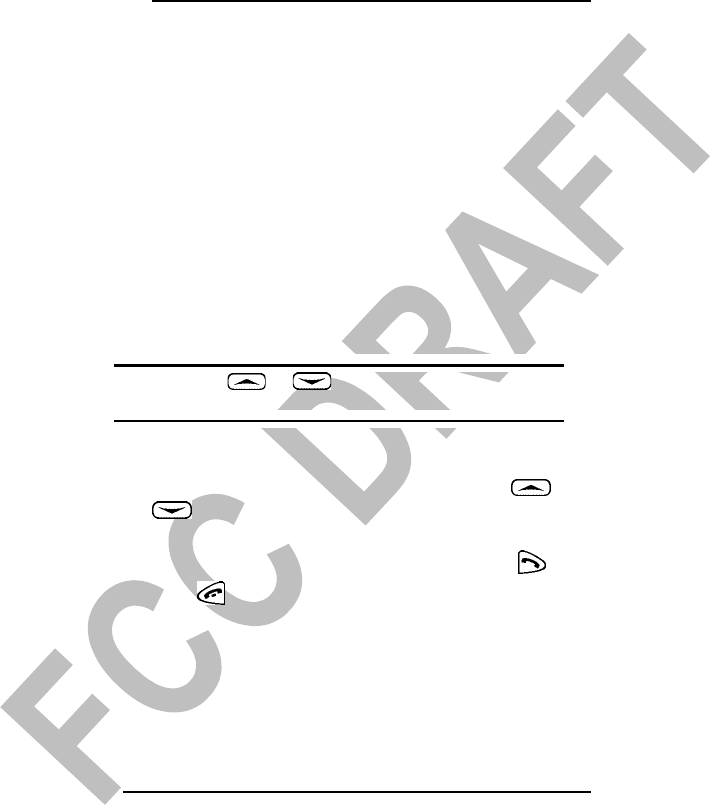
26
Basics
䊳View name lets you view the name associated with the
number.
䊳Delete lets you erase the entire entry from the internal
phone book.
6. Press OK to save your new entry with your selected
options, or press Done if you have not selected any
options.
Finding Phone Numbers
1. From the standby mode, press Contacts.
2. Scroll to Search and press Select.
3. Scroll to the entry you wish to view, and press Details to
view the details associated with this entry.
Shortcut: Press or from the standby mode to list
internal phone book entries.
Making a Call From Your Internal Phone Book
1. From the standby mode, scroll to a number using or
. Your internal phone book numbers automatically
appear.
2. Scroll to the number you wish to call and press .
3. Press or End call to end the call and return to
standby mode.

27
Basics
Changing Your Phone’s Settings
You can customize many aspects of your phone’s
functionality, from display and sounds to messaging and
security, through the Settings menu. Below are just a few
examples of how to navigate and use the Settings menu.
Setting Your Phone’s Security
You can change your lock code, enable security measures
to prevent others from using your phone without you
permission or knowledge, and restrict calls.
To access your security settings:
1. From the standby mode, press Menu, scroll to Settings,
and press Select.
2. Scroll to Security settings and press Select.
3. Enter your lock code and press OK.
4. Scroll to the security function you wish to enable
(Phone lock, Allowed numbers when phone locked, Change
lock code, or Call restrictions) and press Select.
Note: If you do not know your lock code, try the last four digits of
your phone number. If this does not work, contact Sprint Customer
Solutions.
Changing Your Welcome Note
1. From the standby mode, press Menu, scroll to Settings,
and press Select.
2. Scroll to Phone settings and press Select.
3. Scroll to Welcome note and press Select.
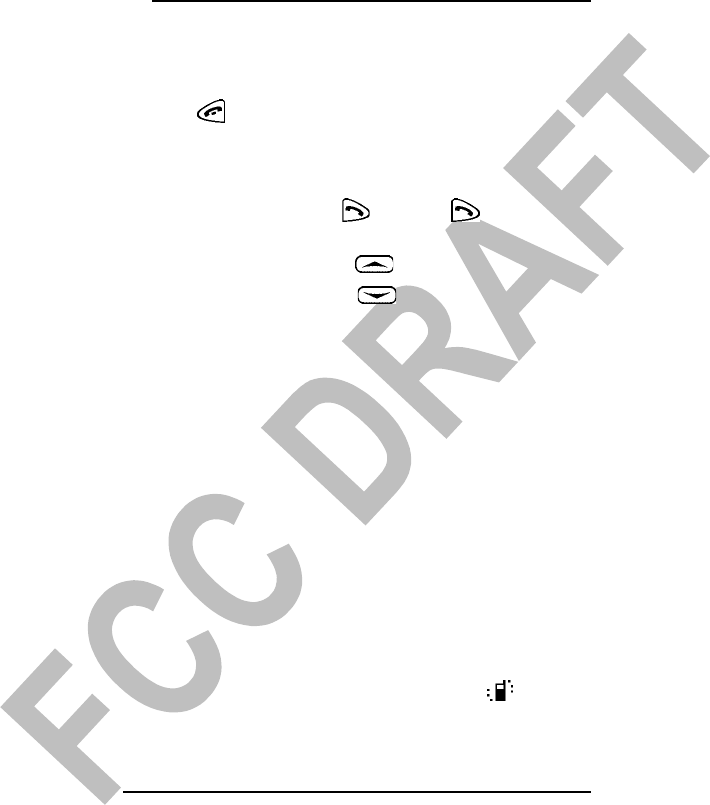
28
Basics
4. Enter the welcome note using the alpha keypad and
press Options.
5. Scroll to Save and press Select.
6. Press to return to the standby mode.
Adjusting Volume During a Conversation
You can adjust your call volume only during a call.
1. Dial a number and press , or press to receive
an incoming call.
2. To increase volume, press .
3. To decrease volume, press .
Adjusting Tone Settings
1. From the standby mode, press Menu, scroll to Profiles,
and press Select.
2. Scroll to the profile you wish to modify and press
Select.
3. Scroll to Customize and press Select.
4. Scroll to Ringing options and press Select.
5. Scroll to your preferred option and press Select.
6. Scroll to Ringing tone and press Select.
7. Scroll to your preferred option and press Select.
8. Scroll to Ringing volume and press Select.
9. Scroll to your preferred level and press Select.
10. Scroll to Vibrating alert and press Select. The icon is
displayed on the display screen in the standby mode.
11. Scroll to On or Off and press Select.

29
Basics
12. Scroll to Message alert tone and press Select.
13. Scroll to a preferred alert tone and press Select.
14. Scroll to Keypad tones and press Select.
15. Scroll to preferred level of volume and press Select.
16. Scroll to Warning tones and press Select.
17. Scroll to On or Off and press Select. Either selection
displays a momentary confirmation followed by the
Warning tones screen displaying On or Off at the bottom
of the screen.
18. Scroll to Alert for and press Select. An option list
appears with the names of available groups. The left
selection key will display Unmark if a group is already
marked, or Mark if a group is not marked. Scroll to your
preferred option and press Select.
19. Press Yes or No to Save changes? If you have not
selected
or saved any groups, the text “No calls” is displayed on
your Alert for screen.
20. Press to return to the standby mode.
Changing Phone’s Language Settings
1. From the standby mode, press Menu, scroll to Settings,
and press Select.
2. Scroll to Phone settings, and press Select.
3. Scroll to Language and press Select.
4. Scroll to English, Español, or Français and press Select.
You r p h one’s language is now in the language you
selected.
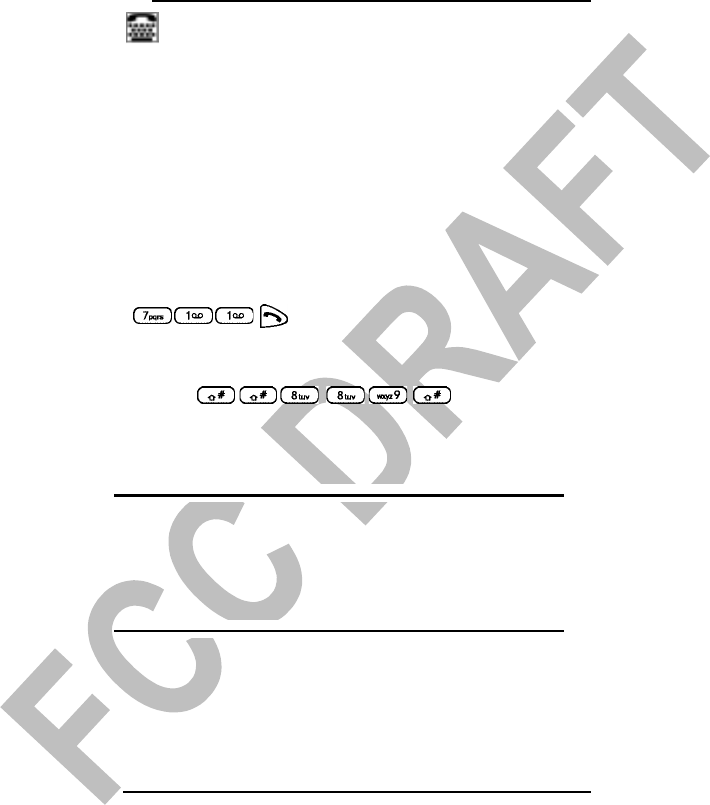
30
Basics
TTY Use With PCS Service From Sprint
A TTY (also known as a TDD or Text Telephone), is a
telecommunications device that allows people who are
deaf or hard of hearing, or who have speech or language
disabilities, to communicate via a telephone.
Your phone is compatible with select TTY devices. Please
check with the manufacturer of your TTY device for
connectivity information and to ensure that the TTY
device supports digital wireless transmission.
When establishing your PCS Service, please call
PCS Customer Service SolutionsSM via the state
Telecommunications Relay Service (TRS) by first dialing
. Then provide the state TRS with
this number: 866-727-4889.
To enable or disable TTY:
1. Press .
2. Follow the system prompt by pressing OK or Exit.
3. Scroll to Yes or No and press Select.
IMPORTANT NOTICE: Sprint recommends that TTY users make
emergency calls by other means including Telecommunications
Relay Services (TRS), analog cellular, and landline communications.
Wireless TTY calls to 911 may be corrupted when received by public
safety answering points (PSAPs) rendering some communications
unintelligible.
For additional information and instructions regarding
TTY use, please see the Online User’s Guide at
www.sprintpcs.com.
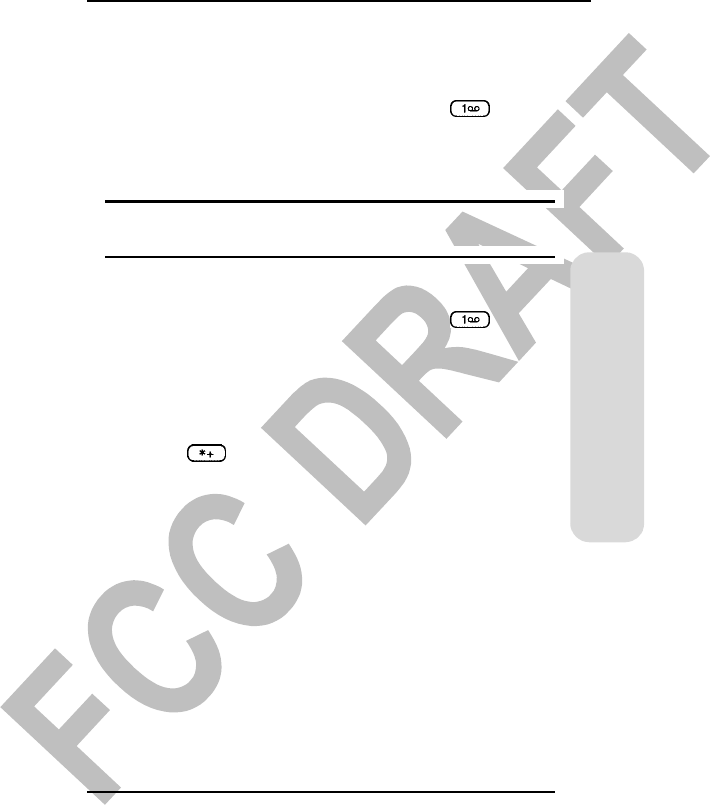
31
Basics
Sending and Receiving Messages
Setting Up Voicemail
1. From the standby mode, press and hold .
2. Follow the system prompts to create your pass code
and record your greeting.
Note: If your account has not been activated, you will be prompted
to contact your PCS Service Provider.
Retrieving Voicemail Messages
1. From the standby mode, press and hold .
2. Follow the system prompts.
Accessing Voicemail From Another Phone
1. Dial your PCS Phone Number.
2. Press when voicemail answers.
3. Enter your pass code and follow the system prompts.
Displaying Numeric Pages
1. From the standby mode, press Menu, scroll to
Messaging, and press Select.
2. Scroll to Notifications and press Select.
3. Scroll to the new message and press Select to display
the message.
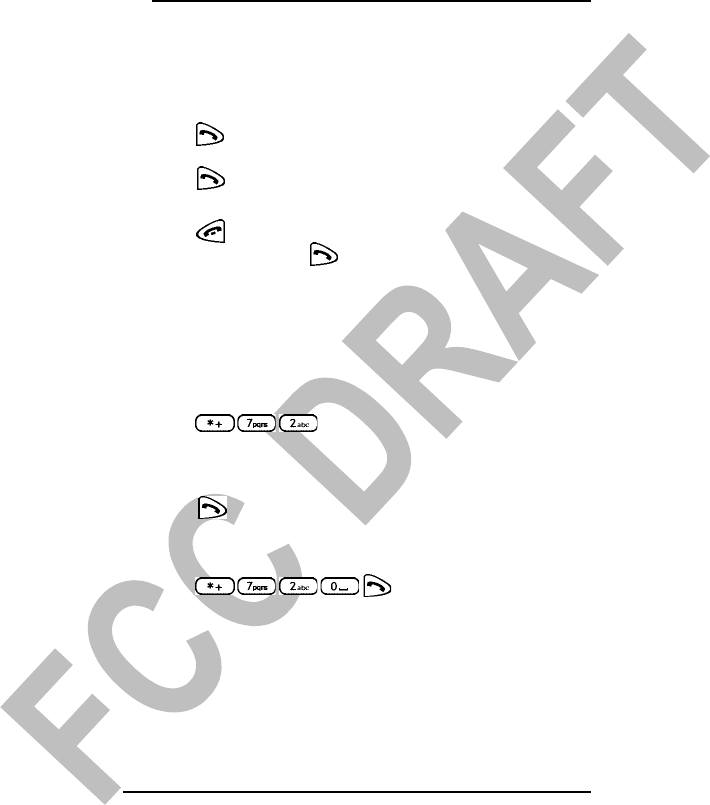
32
Basics
PCS Service Features
Call Waiting
To respond to an incoming call while you’re on a call:
䊳Press or Answer. This puts the first call on hold and
answers the second call. To switch between calls,
press again.
– or –
䊳Press to end your first call. To answer the
incoming call, press .
Call Forwarding
Call Forwarding lets you forward your calls to another
number. You can still make calls from your phone while
this is activated. There is a per call charge for this service.
To activate:
1. Press .
2. Enter the area code and phone number to which your
calls should be forwarded.
3. Press . You will see a message and hear a tone
confirming the activation of Call Forwarding.
To deactivate:
䊳Press . You will see a
message and hear a tone confirming that Call
Forwarding is deactivated.
Three-Way Calling
Talk to two different people at the same time. When using
this feature, the normal airtime rates will be charged for
each of the two calls.
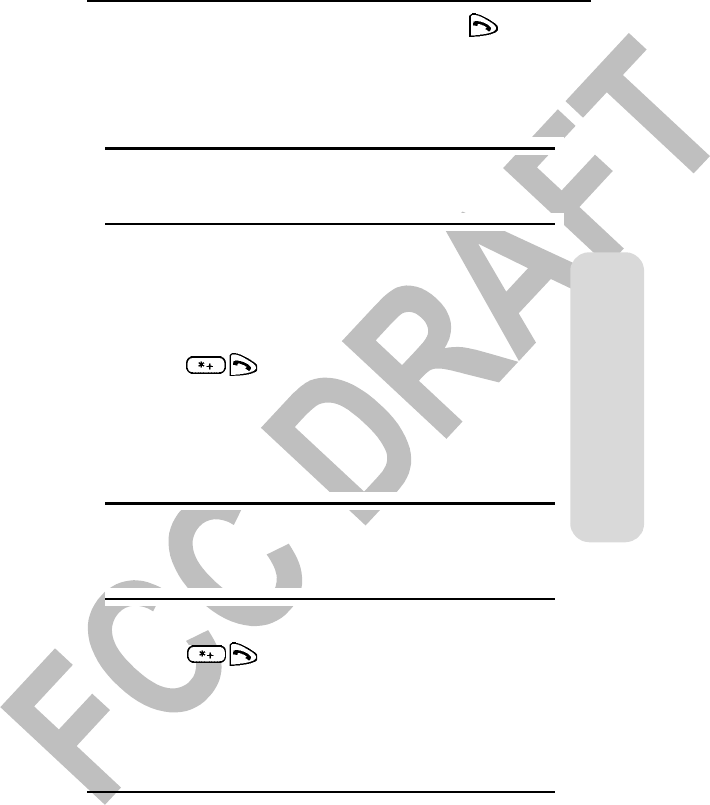
33
Basics
1. Enter a number you wish to call and press .
2. Once you have established the connection, press
Options, scroll to Three-way call, and press Select.
3. Dial the second number and press Flash.
Note: If one of the people that you called hangs up, you and the
remaining caller stay connected. If you initiated the call and are the
first to hang up, all three callers are disconnected.
PCS Voice CommandSM
With PCS Voice Command, you can call a number just by
saying a name.
Get started by setting up your Personal Address Book
1. Press . The first time you use it, you will hear
a tutorial before moving on to the next step.
2. You ’ll hear a tone followed by the prompt “Ready.”
Say “Add Name” to begin setting up your Personal
Address Book.
Note: If you do not wish to use PCS Voice Command, you can still
use the internal voice command system that comes with this phone.
Refer to the Online User’s Guide at www.sprintpcs.com for more
information.
Making a call with PCS Voice Command
1. Press .
2. You ’ll hear a tone followed by the prompt “Ready.”
3. After the prompt, say “Call” and the name of the
person or the number you want called.

34
Basics
4. Your request will be repeated and you will be asked to
verify. Say “Yes” to call the number or person. Say “No”
to cancel.
Using Your Phone’s Internal Voice Commands
In addition to the PCS Voice Command feature, which
saves your voice commands on the Sprint network
database, your phone also has the ability to store and use
voice commands within its own memory system.
Before you can make a call using your phone’s internal
voice command, you must store voice commands
associated with phone numbers in your phone book.
1. From the standby mode, press or and scroll
to the number you wish to assign a voice command.
2. Press Details, then press Options.
3. Scroll to Add voice tag and press Select. The message
“Press Start” appears.
4. Press Start to record your voice command. Speak clearly
and in a normal tone of voice. Your recording
automatically ends.
5. Press Back, then Exit to return to the standby mode. Do
not press Quit unless you wish to erase your message.
To make a call with your phone’s internal voice
command:
1. From the standby mode, press and hold Contacts until
the message “Please speak now” appears on your
screen.
2. Speak the designated command into the microphone.
The number associated with this command is
automatically dialed.

35
Basics
Your Phone’s Special Features
In addition to the standard features in your phone, some
special features in your phone include an alarm clock,
calendar, to-do list, voice recorder, calculator, currency
converter, and location info sharing feature.
Note: For step-by-step instructions on using the special features in
your phone, refer to the Online User’s Guide at www.sprintpcs.com.
Alarm Clock
You can set the alarm clock to sound an alarm at the time
you specify.
1. From the standby mode, press Menu, scroll to Organizer,
and press Select.
2. Scroll to Alarm clock and press Select.
3. Enter the alarm time and press OK.
4. Scroll to am or pm and press OK.
At the time of the alarm, the phone lights up, sounds an
alert tone, and displays an animated message.
5. Press Stop (to turn off the alarm) or Snooze (the alarm
will sound again in 10 minutes).
Calendar
You can use the calendar to remind you of appointments
such as meetings, phone calls, birthdays, or general
reminders. You can also set an alarm to remind you of the
appointment.
1. From the standby mode, press Menu, scroll to Organizer,
and press Select.
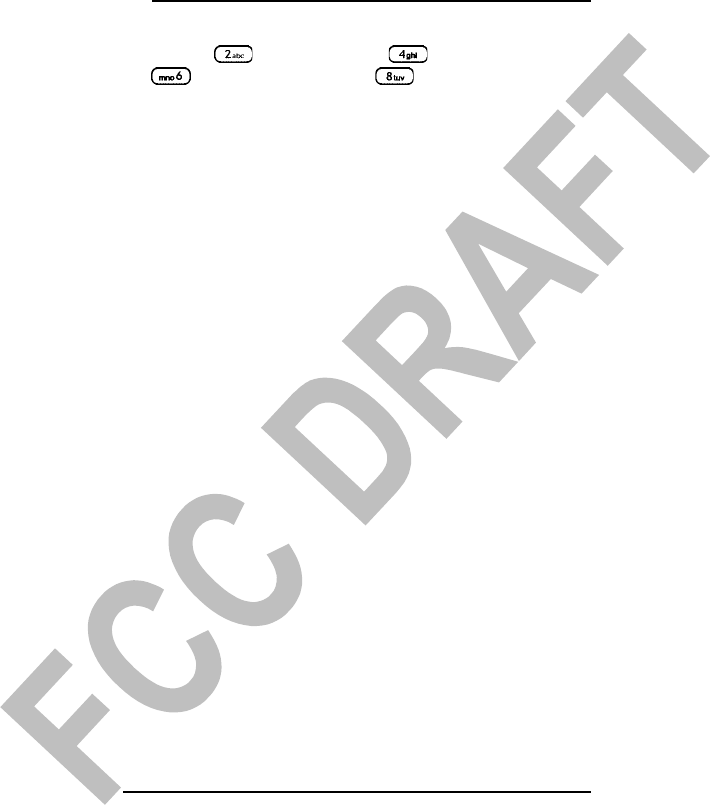
36
Basics
2. Scroll to Calendar and press Select.
Use the key to scroll up, key to scroll left,
key to scroll right, and key to scroll down
in the monthly calendar view.
3. Scroll to the date of your appointment and press
Options.
4. Scroll to Make a note and press Select.
5. Scroll to Meeting, Call, Birthday, Memo, or Reminder and
press Select.
6. Follow the prompts to enter the information and time
of your appointment and press Options.
7. Scroll to Save and press Select.
8. Follow the steps to add an alarm, if desired, and press
Select.
To-do List
You can use the to-do list to save a list of tasks in your
phone to recall for later use.
1. From the standby mode, press Menu, scroll to Organizer,
and press Select.
2. Scroll to To-do list and press Select.
3. Press Options, scroll to Add, and press Select.
4. Enter a subject for your task, press Options, scroll to
Save, and press Select.
5. Select High (1), Medium (2), or Low (3) as the priority level
and press Select.

37
Basics
Voice Recorder
You can use the voice recorder to record audio memos
and store them in your phone.
Record a Memo
1. From the standby mode, press Menu, scroll to Organizer,
and press Select.
2. Scroll to Voice recorder and press Select.
3. Scroll to Record and press Select.
4. After the tone, the phone begins recording.
5. When you are finished recording, press Stop.
6. Enter a title for the voice recording and press OK.
Work with Recorded Memos
1. From the standby mode, press Menu, scroll to Organizer,
and press Select.
2. Scroll to Voice recorder and press Select.
3. Scroll to Recordings list and press Select.
4. Scroll to the desired memo, then press Options.
5. Scroll to the desired option and press Select:
䊳Playback plays the selected memo through the earpiece.
䊳Delete erases the selected voice memo.
䊳Edit title edits the title of the voice memo or renames the
voice memo.
䊳Add alarm/Alarm adds, edits, or removes a reminder
alarm for the voice memo.
Calculator
You can use the calculator to add, subtract, multiply,
divide, square, find the square root, and convert currency.

38
Basics
1. From the standby mode, press Menu, scroll to Organizer,
and press Select.
2. Scroll to Calculator and press Select.
3. Enter the first number in the calculation (press
for a decimal point).
4. Press Options, scroll to Add, Subtract, Multiply, Divide,
Square, Square root, or Change sign (to a negative or
positive) and press Select.
5. Enter the second number in the calculation.
6. Press Options, scroll to Equals, and press Select. The total
is displayed.
7. To start a new calculation, press and hold Clear for two
seconds or press to return to standby mode.
Currency Converter
To convert currency using the calculator in your phone:
1. From the standby mode, press Menu, scroll to Organizer,
and press Select.
2. Scroll to Calculator and press Select.
3. Press Options, scroll to Exchange rate, and press Select.
4. Scroll to Foreign units converted to home units or Home units
converted to foreign units and press Select.
5. Enter the exchange rate for the selected set of units and
press OK.
6. Enter the number (currency) you wish to convert
(press for a decimal point) and press Options.

39
Basics
7. Scroll to To home or To foreign and press Select. The
currency is converted according to the saved exchange
rate.
Location Info Sharing
The location info sharing feature allows the network to
detect the position of your phone.
Note: Your phone is equipped with a location info sharing feature
for use in connection with location base services that may be
available in the future.
To enable your phone’s location info sharing feature:
1. Press Menu, scroll to Settings, and press Select.
2. Scroll to Call Settings and press Select.
3. Scroll to Location info sharing and press Select.
A message explaining the options of the location info
sharing feature is displayed on your screen. Press More, or
scroll through the message using the up and down scroll
keys, then press OK.
4. Select 911 only or On and press OK.
䊳If you select 911 only your phone’s location information
is shared with the network only during emergency
calls. (911 only is the default profile.)
䊳If you select On, your phone’s location information is
shared with the network whenever the phone is
powered on and activated.
5. When the confirmation message appears, press OK.
If you selected 911 only, the icon is displayed on the
screen when in the standby mode. If you selected On, the
icon is displayed on the screen when in the standby
mode.

40
Basics
Accessories for Your Phone
Belt Clip
Attaches to the back of your phone and provides a safe
and convenient way to carry your phone.
Standard Battery (BL-5C)
Provides up to 3.5 hours of continuous talk time or up to
150 hours of continuous standby time.
Vehicle Power Adapter (LCH-9)
Charges your phone in your vehicle using the cigarette
lighter adapter.
Desktop Charger (DCV-15)
Charges your phone when placed in the charger’s
phone slot.
Mobile Holder (MBC-17)
Holds your phone in place while driving or during
charging. Can be used with the LCH-9 and BHF-1.
Travel Charger (ACP-12U)
Compact and lightweight, it’s a convenient way to charge
your phone while traveling.
Car Kit (CARK-142)
Charges your phone and allows you to operate your
phone hands-free so you can drive safely.
Basic Car Kit (BHF-1)
A car kit you can install yourself that lets you operate your
phone hands-free in your car so you can drive safely.
Data Cable (DKU-5)
Easy and convenient connection to your PC or laptop
computer for wireless modem functionality.

41
Basics
Mobile Inductive Loopset (LPS-4)
With the loopset, people who use a T-coil equipped
hearing aid have the freedom to talk on a digital mobile
phone.
Headset (HDB-4)
Small and lightweight, an over-the-ear headset allows
convenient, hands-free calls.
Earbud Headset (HS-5)
Small and discreet, the earbud headset allows convenient,
hands-free calls.
How to Order
These and other accessories are available for purchase at
your local Sprint Store. You can also call the PCS Accessory
Hotline (1-800-974-2221) or visit www.sprintpcs.com.
Next day delivery is offered in select areas.

42
Basics
Performance and Safety
Important Information About Your Phone and Service
Keeping Tabs on Signal Strength
The quality of each call you make or receive depends on the signal
strength in your area. Your phone informs you of the current signal
strength by displaying a number of bars next to the signal strength
icon. The more bars displayed, the stronger the signal. If you’re
inside a building, being near a window may give you better
reception.
Understanding the Power Save Feature
If your phone is unable to find a signal after 15 minutes of searching,
a Power Save feature is automatically activated. If your phone is
active, it periodically rechecks service availability or you can check it
yourself by pressing any key. Anytime the Power Save feature is
activated, a message displays on the screen. When a signal is found,
your phone returns to standby mode.
Understanding How Your Phone Operates
Your phone is basically a radio transmitter and receiver. When it's
turned on, it receives and transmits radio frequency (RF) signals.
When you use your phone, the system handling your call controls the
power level. This power can range from 0.00001 watts to 0.347
watts, depending on which band your phone operates.
Knowing Radio Frequency Safety
The design of your phone complies with updated NCRP standards
described below. To further limit RF exposure, you can limit the
duration of your calls and operate your phone in the most power-
efficient manner. In 1991-92, the Institute of Electrical and
Electronics Engineers (IEEE) and the American National Standards
Institute (ANSI) joined in updating ANSI's 1982 standard for safety
levels with respect to human exposure to RF signals. More than 120
scientists, engineers and physicians from universities, government
health agencies and industries developed this updated standard after
reviewing the available body of research. In 1993, the Federal
Communications Commission (FCC) adopted this updated standard

43
Basics
in a regulation. In August 1996, the FCC adopted hybrid standard
consisting of the existing ANSI/IEEE standard and the guidelines
published by the National Council of Radiation Protections and
Measurements (NCRP).
Maintaining Your Phone’s Peak Performance
There are several simple guidelines to operating your phone properly
and maintaining safe, satisfactory service.
䊳Hold the phone with the antenna raised, fully-extended and over
your shoulder.
䊳Try not to hold, bend or twist the phone’s antenna.
䊳Don’t use the phone if the antenna is damaged.
䊳Speak directly into the mouthpiece.
䊳For optimal performance, use your phone between a temperature
range of 59ºF to 77ºF (15ºC to 25ºC).
䊳Avoid exposing your phone and accessories to rain or liquid spills.
If your phone does get wet, immediately turn the power off and
remove the battery. If it’s inoperable, return it to a Sprint Store or
call PCS Customer Service Solutions for service.
Note: For the best care of your phone, only Sprint Authorized Personnel should
service your phone and accessories. Faulty service may void the warranty.
Maintaining Safe Use of and Access to Your Phone
FAILURE TO FOLLOW THE INSTRUCTIONS OUTLINED MAY LEAD
TO SERIOUS PERSONAL INJURY AND POSSIBLE PROPERTY
DAMAGE
Using Your Phone While Driving
Talking on your phone while driving (or operating the phone
without a hands-free device) is prohibited in some jurisdictions.
Laws vary as to specific restrictions. Remember that safety always
comes first.
When using your phone in the car:
䊳Get to know your phone and its features, such as speed dial and
redial.
䊳When available, use a hands-free device.
䊳Position your phone within easy reach.

44
Basics
䊳Let the person you are speaking to know you are driving;
if necessary, suspend the call in heavy traffic or hazardous
weather conditions.
䊳Do not take notes or look up phone numbers while driving.
䊳Dial sensibly and assess the traffic; if possible, place calls when
stationary or before pulling into traffic.
䊳Do not engage in stressful or emotional conversations that may
divert your attention from the road.
䊳Dial 911 to report serious emergencies. It’s free from your wireless
phone.
䊳Use your phone to help others in emergencies.
䊳Call roadside assistance or a special non-emergency wireless
number when necessary.
Tip: Purchase an optional Hands-Free Car Kit.
Following Safety Guidelines
To operate your phone safely and efficiently, always follow any
special regulations in a given area. Turn your phone off in areas
where use is forbidden or when it may cause interference or danger.
Using Your Phone Near Other Electronic Devices
Most modern electronic equipment is shielded from radio frequency
(RF) signals. However, RF signals from wireless phones may affect
inadequately shielded electronic equipment.
RF signals may affect improperly installed or inadequately shielded
electronic operating systems and/or entertainment systems in motor
vehicles. Check with the manufacturer or their representative to
determine if these systems are adequately shielded from external RF
signals. Also check with the manufacturer regarding any equipment
that has been added to your vehicle.
Consult the manufacturer of any personal medical devices, such as
pacemakers and hearing aids, to determine if they are adequately
shielded from external RF signals.
Note: Always turn off the phone in health care facilities and request permission
before using the phone near medical equipment.

45
Basics
Turning Off Your Phone Before Flying
Turn off your phone before boarding any aircraft. To prevent possible
interference with aircraft systems, the U.S. Federal Aviation
Administration (FAA) regulations require you to have permission
from a crew member to use your phone while the plane is on the
ground. To prevent any risk of interference, FCC regulations prohibit
using your phone while the plane is in the air.
Turning Off Your Phone in Dangerous Areas
To avoid interfering with blasting operations, turn your phone off
when in a blasting area or in other areas with signs indicating two-
way radios should be turned off. Construction crews often use
remote-control RF devices to set off explosives.
Turn your phone off when you’re in any area that has a potentially
explosive atmosphere. Although it’s rare, your phone and accessories
could generate sparks. Sparks can cause an explosion or fire,
resulting in bodily injury or even death. These areas are often, but not
always, clearly marked. They include:
䊳Fueling areas such as gas stations.
䊳Below deck on boats.
䊳Fuel or chemical transfer or storage facilities.
䊳Areas where the air contains chemicals or particles such as grain,
dust or metal powders.
䊳Any other area where you would normally be advised to turn off
your vehicle’s engine.
Note: Never transport or store flammable gas, liquid or explosives in the
compartment of your vehicle that contains your phone or accessories.
Restricting Children’s Access to Your Phone
Your phone is not a toy. Do not allow children to play with it as they
could hurt themselves and others, damage the phone or make calls
that increase your phone bill.

46
Basics
Caring for the Battery
Protecting Your Battery
The guidelines listed below help you get the most out of your
battery’s performance.
䊳Use only Sprint-approved batteries and desktop chargers. These
chargers are designed to maximize battery life. Using other
batteries or chargers voids your warranty and may cause damage.
䊳In order to avoid damage, charge the battery only in temperatures
that range from -22ºF to 140ºF (-30ºC to 60ºC).
䊳Don’t use the battery charger in direct sunlight or in high humidity
areas, such as the bathroom.
䊳Never dispose of the battery by incineration.
䊳Keep the metal contacts on top of the battery clean.
䊳Don’t attempt to disassemble or short-circuit the battery.
䊳The battery may need recharging if it has not been used for a long
period of time.
䊳It’s best to replace the battery when it no longer provides
acceptable performance. It can be recharged hundreds of times
before it needs replacing.
䊳Don’t store the battery in high temperature areas for long periods
of time. It’s best to store the battery in temperatures that range
from 32ºF to 77ºF (0ºC to 25ºC).
Disposal of Lithium Ion (LiIon) Batteries
For safe disposal options of your LiIon batteries, contact your nearest
Sprint authorized service center.
Special Note: Be sure to dispose of your battery properly. In some
areas, the disposal of batteries in household or business trash may
be prohibited.
Note: For safety, do not handle a damaged or leaking LiIon battery.

47
Basics
Acknowledging Special Precautions and
the FCC Notice
FCC Notice
This phone may cause TV or radio interference if used in close
proximity to receiving equipment. The FCC can require you to stop
using the phone if such interference cannot be eliminated. Vehicles
using liquefied petroleum gas (propane or butane) must comply with
the National Fire Protection Standard (NFPA-58).
For a copy of this standard, contact the National Fire Protections
Association, One Batterymarch Park, Quincy, MA 02269,
Attn: Publication Sales Division.
Cautions
Any changes or modifications to your phone not expressly approved
in this document could void your warranty for this equipment and
void your authority to operate this equipment. Only use approved
batteries, antennas and chargers. Although your phone is quite
sturdy, it is a complex piece of equipment and can be broken. Avoid
dropping, hitting, bending or sitting on it.
Body-Worn Operation
To maintain compliance with FCC RF exposure guidelines, if you
wear a handset on your body, use the Sprint approved carrying case,
holster or belt clip that contains no metal and positions the handset a
minimum of 7/8 inch (2.2 centimeters) from the body. If you do not
use a body-worn accessory, ensure the antenna is at least 7/8 inch
(2.2 centimeters) from your body when transmitting. Use of non-
Sprint approved accessories may violate FCC RF exposure guidelines.
For more information about RF exposure, visit the FCC Web site at
www.fcc.gov.

48
Basics
Terms and Conditions
& Warranty Information
Terms and Conditions of Services
(Effective as of August 1, 2002 until replaced)
Thanks for choosing Sprint. These terms and conditions are part of
your agreement with Sprint for PCS Services.
For the most current version of the terms and conditions, please visit
our Web site at www.sprintpcs.com or call PCS Customer Service
SolutionsSM at 1-888-211-4PCS, because the terms and conditions
included with your PCS Phone may not the most current version. If
you activated PCS Services before the effective date of these terms
and conditions, these terms and conditions replace and supersede
any previous terms and conditions.
If you have questions about your PCS Services, call PCS Customer
Service SolutionsSM at 1-888-211-4PCS (4727) or visit our Web site at
www.sprintpcs.com.
Para solicitar esta literatura en español, por favor contactar a
1-888-211-4PCS (4727).
Agreement. Your agreement ("Agreement") with Sprint Spectrum L.P.
and any of its Affiliates doing business as Sprint providing
PCS Services ("Services") to you is made up of these Terms and
Conditions of Service ("Terms") and the Service Plan that we agree
to provide you. Your "Service Plan" is described in our marketing
materials, and includes the rates and features we set for that Service
Plan. We use the words "we," "us," "our" or "Sprint " to refer to
Sprint Spectrum L.P. and its Affiliates doing business as Sprint in
these Terms. When you activate PCS Services or attempt to use our
PCS Services (including, without limitation, attempting to place a call
on the Sprint Nationwide PCS Network, or off the Sprint Nationwide
PCS Network when roaming, including "911" or similar calls), you
accept the Agreement.
Provision of Service. Your purchase of PCS Phones or other
equipment does not mean that we must provide Services to you. We
may decide not to provide Services to you for any lawful reason. We

49
Basics
may request that you provide us with any information we reasonably
require to determine whether you qualify for Services. Services in
some areas are managed and provided under contract with Sprint
by independent Affiliates with access to the Sprint Nationwide
PCS Network. Some Services may not be available or may operate
differently in certain Affiliate markets.
Credit Verification. You must have and keep satisfactory credit to
receive and continue to receive Services. We will verify your credit
before agreeing to provide Services to you and we may verify your
credit at any time while we provide Services to you. Credit
verification may include a review of credit reports that we receive
from commercially available credit bureaus. We may require a
guarantee of payment by an individual or entity approved by us. If at
any time we determine, in our sole discretion, that payment for
Services may not be made when due, we may suspend Services to
your phone and require that you provide payment on account or a
guarantee of payment before we resume Services to your phone.
Changes to Agreement. We may change this Agreement at any time
(but see PCS Service Plan). Any changes to the Terms are effective
when we publish the revised Terms. If you use our Services or make
any payment to us on or after the effective date of the changes, you
accept the changes. If you do not accept the changes, you may
terminate Services (but see Termination and Changing Service Plans).
For purposes of the Agreement, "use" includes keeping the right to
access the Sprint Nationwide PCS Network by not terminating
Services. You may not modify the Agreement except for your
PCS Service Plan (see Termination and Changing Service Plans).
Service Plan. You may be eligible for a fixed length PCS Service Plan
("Term Service Plan") or for a month-to-month Service Plan ("Non-
Term Service Plan"). We determine the Service Plan for which you
qualify. We may offer non-identical Service Plans to different
individuals or entities. Services and coverage under some Service
Plans may be more limited than available under other Service Plans.
Your Service Plan sets out the charges for Services and is your Service
Plan until that Service Plan is changed, you switch to a different
Service Plan, or your Services terminate. Your Service Plan may
require that you make a deposit, prepayment, or a series of deposits

50
Basics
or prepayments, or be subject to an account spending limit, before
Services are activated or maintained.
Changing Service Plans. If you are on a Non-Term Service Plan, you
may change to a different Service Plan for which you qualify. Any
change is effective at the start of your next full invoicing cycle unless
otherwise specified by us at the time that you place your change
order. If you change or add a different Service Plan or service feature
and the change is effective prior to the start of your next full
invoicing cycle, you will be invoiced a prorated amount. We may
require a service charge for implementing any change directed by
you as well as the Service Plan or optional service features you select.
If you are on a Term Service Plan, your ability to change to another
Service Plan may be limited and we may require you to pay a
termination fee as set out in your Service Plan.
Use of Services and Equipment; Availability. You must be at least 18
years old to subscribe to our Services. We may require you to provide
proof of your age and identity. If you are under 18 years old you may
be eligible for certain Services that have Account Spending Limits if a
person 18 years or older is also named as a subscriber on the
Account. Services and equipment may not be used for any unlawful,
fraudulent or abusive purpose. By requesting Services, you agree that
you will not use Services and equipment in any unlawful, fraudulent
or abusive manner. You may not resell or lease Services or equipment
to anyone. Services are available within the operating range of the
Sprint Nationwide PCS Network. Coverage and quality of Services
may be affected by conditions within or beyond our control,
including atmospheric, geographic, or topographic conditions. We
do not guarantee that there will be no interruptions or delays in
Services. Your PCS Phone will not accept the services of any wireless
provider other than Sprint (but see Roaming).
Number. We assign a phone number ("Number") to the phone
or other equipment used by you on the Sprint Nationwide
PCS Network. We may change the Number without compensation by
giving you prior notice. You do not own the Number. You may not
modify the Number we program into any phone or other equipment,
transfer or duplicate the Number to any phone or other equipment

51
Basics
other than that authorized by us, or transfer the Number to any other
individual or entity.
Phone Activation Fee. You may be required to pay a non-refundable
phone activation fee when you activate a new Number, have us
switch a Number to a different phone, have your current Number
changed, we activate a different phone on your existing account or
your Service Plan says so. Details on any applicable phone activation
fee are set out in your Service Plan or can be obtained by calling
PCS Customer Service Solutions.
Charges. For most forms of wireless Service, your usage will be
charged from the time you first initiate contact between your phone
or other wireless device and the network until the network
connection is broken, whether or not you are successful in
connecting with the service with which you seek to connect, even if
the connection is later broken or dropped. An exception is that you
are not charged for voice calls that are not completed. You are
charged for completed calls to your Number from the time shortly
before the phone starts ringing until the call is terminated by either
party. You will be charged peak rates for the entire duration of calls
initiated during the peak time periods applicable to your Service. You
will be charged off-peak rates for the entire duration of calls initiated
during the off-peak time periods applicable to your Service. In
addition to these usage charges, you may be charged for recurring
monthly service charges, applicable local and long-distance toll
charges, other usage charges, connection fees, roaming charges,
directory assistance, call completion charges, account review and
management charges optional features you select at an extra cost,
and taxes and other regulatory-related charges. Charges for most
Services are incurred in one-minute increments, with partial minutes
of use rounded up to the next highest minute. You must pay, by each
invoice due date, all charges for Services provided to the Number for
each phone or other equipment that our records show you activated,
no matter who actually uses or has possession of the phone or other
equipment at the time Services are provided.
PCS Vision (Third Generation) Wireless Charges. For PCS Vision
wireless services, you will be charged, on a per kilobyte basis, for
Web access, whether sent or received by your PCS Phone or other

52
Basics
wireless device, rather than for airtime used, even for certain PCS
Vision voice services. As long as your PCS Phone or other wireless
device is connected to the enhanced (Third Generation) Sprint
Nationwide PCS Network, you will be incurring data usage charges.
You cannot receive incoming calls while using third generation
services. Data packet usage will be measured in kilobytes and will be
rounded up to the next whole kilobyte. Kilobyte usage will be
rounded up to the next full cent. Rounding up will occur at the end
of each separate session or each clock hour (at the top of each hour),
if the session spans more than 1 clock hour. When traveling on the
Vision network, a session may be ended and new session initiated,
although no interruption to the actual data session will occur. Each
individual session will be rounded up. The number of data packets
used and charged to you will vary widely, depending upon the
specific PCS Vision wireless application or other service you use and
the amount of data used in the specific application or service. You
will be charged for data exchanges initiated by other Internet users as
well as those you initiate. Estimates of data usage, for example, the
size of downloadable files, will vary from what you actually use. You
will be charged for additional data used in transporting and routing
on the network. If you use a Premium Service (including services
provided by third parties but for which you are billed on your
PCS Invoice), you will be charged for data used in transport and
routing in addition to the charge for the Premium Service. You will be
charged for partial and interrupted data downloads or other use,
including re-sent data, and for unsuccessful attempts to reach Web
sites and use other applications and services, including those
resulting from dropped network connections. Your invoice will not
separately identify the number of kilobytes attributable to your use of
specific sites, sessions or services used. Specific additional
information about PCS Vision wireless services, including pricing,
included kilobytes and combining with other PCS Service Plans, is
available in our standard sales collateral for PCS Vision wireless
Service Plans or at www.sprintpcs.com.
PCS Voice CommandSM. PCS Voice CommandSM is an optional service
that allows you to place calls by using speech recognition
technology. Calls to 911 or similar emergency numbers cannot be

53
Basics
placed through the PCS Voice Command feature. Airtime and
applicable long distance charges for a call completed from your
Number using the PCS Voice Command feature begin when you
press or activate the TALK or similar key(s) and end when your call is
terminated by hitting the END key or by returning to the PCS Voice
Command platform. If you initiate and complete another call without
leaving the PCS Voice Command platform, a separate charge for that
call will begin from the time the previous call was terminated.
Airtime and applicable long distance charges will be applied to the
entire length of a completed call initiated from PCS Voice Command.
Using Directory Assistance to input names into your PCS Voice
Command address book will incur additional charges. Details on
charges for the PCS Voice Command feature can be found in the
marketing materials for this feature, by visiting www.sprintpcs.com
or by calling PCS Customer Service Solutions.
Invoicing. Invoicing cycles are approximately 30 days in length.
Invoicing cycles and dates may change from time to time. Except as
otherwise provided in your Service Plan, monthly recurring charges
(MRCs) are invoiced one invoicing cycle in advance. Charges for
Services are usually invoiced as soon as possible after the charges
accrue. We may, however, invoice you for usage and charges
occurring before the invoicing cycle being invoiced, if they were not
previously invoiced. If you are invoiced for usage incurred during a
prior invoicing cycle, those minutes will be applied to your Service
Plan minutes for the current invoicing cycle. However, if you change
your PCS Service Plan between the time the usage was incurred and
the beginning of the current invoicing cycle, those minutes from the
prior invoicing cycle will be charged at the rate per minute for usage
over included minutes provided in the Service Plan in effect at the
time the usage was incurred.
Additional Terms for Premium Services. Access to and downloading
of premium content is not included with PCS Vision services. Certain
PCS Vision services (e.g., games, ringers and screen savers) contain
mostly premium services content. Your invoice will not separately
identify the number of kilobytes attributable to your use of specific
sites, sessions or services used. You will be charged for Premium
Services at the rates and charges specified at the time of access or

54
Basics
download, in addition to data usage charges you will incur while
connected to the Sprint Nationwide PCS Network. You will be
charged for partial and interrupted data downloads or other use,
including data that is resent, and for unsuccessful attempts to reach
Web sites and use other applications and services, including those
resulting from dropped network connections. We provide no
warranties and make no representations or claims with regard to the
third party Premium Services. In certain instances, subject to the
terms of the content purchased, we may delete premium and non-
premium items downloaded to available storage areas (e.g., your
vault) including any pictures, games and other content. We may
impose a dollar or other limit on use of Premium Services including a
limit the amount of Premium Service charges that you will be allowed
to incur in a specific timeframe (month, week, day, or other time
period). We may suspend your use of Premium Services without
prior consent or notice if we have reason to suspect fraudulent or
unauthorized use of your Premium Services account, but we make no
assurances that we will suspend your account.
Payment. If you have authorized payment for Services or equipment
by credit card or by debiting a bank account, no additional notice or
consent is required before we invoice the credit card or debit the
bank account for all amounts due to us or billed by us on behalf of a
third party. You must promptly notify us of any change in your
invoicing address or of the credit card or bank account used for
payment. We reserve the right to require payment by money order,
cashier’s check or other secured form of payment. If we take action
to receive payment beyond invoicing you for charges for Services or
equipment, you must pay our costs and expenses of collection,
including attorneys’ fees and expenses, the fees of any collection
agency and court costs. If we act as an invoicing agent for a third-
party service provider, payments received are first applied to
amounts due and owing to us and any remaining amounts are applied
to sums due and owing to the third-party service provider. We may
charge an additional fee for any check or other negotiable instrument
endorsed by you and returned unpaid by a financial institution for
any reason. You may be charged fees for certain methods of payment.

55
Basics
Late Payment Charges. Payment is past due if we do not receive it by
the due date shown on your invoice. Any payment for Services and
equipment not made when due accrues late charges until paid at the
rate of 5% per month or at the highest rate allowed by law.
Acceptance of late or partial payments (even if marked "paid in full")
does not waive our right to collect all amounts that you owe us. If
your Service has been suspended due to non-payment, you may be
charged a reactivation fee.
Disputed Charges. You must raise any dispute that you have about
any charges invoiced to you within 15 days of the date of the invoice
or you have accepted the invoice. You may notify us of any dispute
by notifying PCS Customer Service Solutions. Calls to our sales or
general business offices are not notice of a dispute. If disputed
invoice procedures are described on the invoice, you must follow
them.
Termination. Non-Term Service Plan. If you are on a Non-Term
Service Plan you may terminate Services at any time by giving us
notice. Subject to the terms of this Agreement, we may terminate
Services at any time, with or without notice. If your Service has been
suspended due to non-payment, you may be charged a reactivation
fee. We may deactivate any Number before you receive notice of
termination without liability to you. Termination by either of us may
be with or without cause.
Termination. Term Service Plan. If you are on a Term Service Plan (1)
your ability to terminate Services before the end of the term is
limited, (2) your ability to change to another Service Plan before the
end of the term may be limited, and may result in a termination or
activation fee, (3) you may be required to pay a termination fee, (4)
we may not terminate Services without cause before the end of the
term and (5) if we terminate Services for cause before the end of the
term, you may be required to pay a termination fee. No termination
fee is charged if you terminate a Term Service Plan within 14 days of
activation of your PCS Phone. During the term we must give each
other notice to terminate Services. At and after the expiration of the
term, you may terminate Services at any time by giving us notice and
we may subject, to this Agreement, terminate Services at any time,
with or without notice.

56
Basics
Termination. General. Regardless of whether you have a Non-Term or
a Term Service Plan, we may terminate or suspend Services to you
without liability (1) if you breach any provision of this Agreement
(including if you fail to pay any charges for Services), or (2) if you fail
to pay any charges due us for equipment or otherwise. If you
promptly cure the breach, we may, but are not obligated to,
reactivate Services to you. You must pay all charges for (a) Services
provided before termination of a Number, (b) equipment, regardless
of who terminates Services and (c) a reactivation fee, if we agree to
reactivate Services to you. If Services are terminated before the end
of your current invoicing cycle (i) the monthly recurring charge is
not prorated to the date of termination, and (ii) you will not receive a
credit or refund for any unused minutes in your Service Plan.
Account Spending Limit. If we agree to provide Services to you on
an Account Spending Limit basis, we will tell you your Account
Spending Limit before we start Services to your Number, or as
reasonably practicable after the limit is imposed. If we require a
deposit for you to establish or keep Services on an Account Spending
Limit basis, we will hold the deposit as partial guarantee of payment
for Services (see Deposits). Charges for Services accrue against your
Account Spending Limit as they are incurred. We may charge an
initial ASL start up fee. We may charge a monthly ASL service fee, in
addition to your recurring monthly service charge. We may suspend
Services to your Number without prior notice to you when your
account balance reaches your Account Spending Limit. Services are
restored when you have paid any past due balance and pay a
specified minimum amount to reduce your account balance below
your Account Spending Limit. We may change this minimum amount
at any time upon notice to you. You may pay any past due balance
and the minimum amount by any method authorized by Sprint.
Contact PCS Customer Service Solutions for information about
authorized methods of making these payments. We may charge you a
fee for calls that involve our live customer care services. If we
provide Services to you on an Account Spending Limit basis, Services
and coverage may be limited in certain ways. You must pay all
charges for Services even if they exceed the amount of your Account
Spending Limit.

57
Basics
PCS Clear Pay Program. If we agree to provide Services to you as a
PCS Clear Pay Program customer, we may suspend Services to your
Number without prior notice to you immediately when your bill
becomes past due. Even if your bill is not past due, we may suspend
services if your unpaid usage exceeds $125 or another amount to be
determined by your past credit or usage history. If we require a
deposit for you to establish or keep Services as a PCS Clear Pay
Program customer, we will hold the deposit as partial guarantee of
payment for Services (see Deposits, below). Contact PCS Customer
Service Solutions for information about authorized methods of
making these payments. We may charge you a fee for calls that
involve our live customer care services. If we provide Services to you
on as a PCS Clear Pay Program basis, Services and coverage may be
limited in certain ways. You must pay all charges for Services
whether or not your Services are suspended or terminated.
Deposits. If we require a deposit for you to establish or keep
Services, we will hold the deposit as partial guarantee of payment for
Services. We may change the deposit amount at any time to reflect
revised estimated monthly charges based upon your usage. A deposit
may not be used to pay any invoice (unless it is used to pay a final
invoice) or delay payment. The deposit amount, the length of time
we hold the deposit and changes to the deposit amount are
determined based on your credit and payment history. The rate of
interest, if any, on the deposit is subject to change. We may mix
deposits with our other funds. If Services are terminated for any
reason, we may, without notice to you, apply your deposit toward
payment of outstanding charges and return any excess to you at your
last known address within 75 days after termination of Services. If the
U.S. Postal Service cannot deliver the money to you and returns it to
us, we will hold it for you for one year from the date of return and,
during that period, we may charge a servicing fee against the deposit
balance. Any money held during this one-year period will not accrue
interest for your benefit. You forfeit any portion of the money left
after the one-year period.
PCS Wireless Web and Voice Portal Services. PCS Wireless Web
Services are part of the Services that can be obtained through Sprint.
PCS Wireless Web Services may not be immediately available in some

58
Basics
PCS Affiliate markets. Use of PCS Wireless Web Services requires a
wireless Internet-ready PCS Phone or certain other equipment (or
both) and is subject to any memory, storage or other limitation in the
phone or other equipment. The Caller ID blocking feature is not
available when using PCS Wireless Web Services. For data calls
(including PCS Wireless Web and Voice Portal calls) that are
attempted, but not completed, you are charged for the time during
which the network attempts to connect the call. You are charged for
time spent connected to the PCS Wireless Web or Voice Portal,
including time spent browsing on the Internet or Voice Portal and
reviewing or scrolling through Internet information on-line while still
connected to the Sprint Nationwide PCS Network. Not all Internet
sites can be accessed and you may receive an error message if you
attempt to access a site that cannot be accessed through PCS
Wireless Web Services. You are also charged for PCS Wireless Web
connections to review your PCS account information. PCS Wireless
Web Services and Voice Portal calls may not be available when you
are roaming off the Sprint Nationwide PCS Network. PCS Wireless
Web Services are not available to you if you are on a PCS Prepaid
Service Plan. If you receive Services on an Account Spending Limit
basis, you may be limited in the PCS Wireless Web and Voice Portal
Services available to you. Call PCS Customer Service Solutions or visit
our Web site at www.sprintpcs.com for availability and equipment
compatibility information. Specific additional information about PCS
Wireless Web Services and Voice Portal Services, including pricing,
included minutes and combining with other Service Plans, is
available in our standard sales collateral for PCS Wireless Web
Services and Voice Portal Services or at www.sprintpcs.com. Sprint is
not a publisher of third party content that can be accessed through
PCS Wireless Web Services or Voice Portal Services. Sprint is not
responsible for any opinions, advice, statements, services or other
information provided by third parties and accessible through PCS
Wireless Web Services or Voice Portal Services. Neither Sprint nor its
vendors or licensors guarantees the accuracy, completeness or
usefulness of information that is obtained through the PCS Wireless
Web Services or Voice Portal Services. You are responsible for
evaluating such content.

59
Basics
Other Terms Applicable to PCS Vision Usage. Use of PCS Vision
Services requires the purchase of separate third generation wireless
compatible phone or other device and is subject to any software,
memory, storage or other limitation in the phone or other
equipment. Not all applications and services work, or work the same,
on all third generation wireless phones and devices. Check the
materials accompanying your phone or device to determine which
applications and services it will support. PCS Vision Services are not
available when roaming off the Sprint Nationwide PCS Network.
PCS Vision Services may not be currently available in some
Affiliate areas.
Sprint is not responsible for any opinions, advice, statements,
services applications or other information provided by third parties
and accessible through PCS Vision Services. Neither Sprint nor its
vendors or licensors guarantees the accuracy, completeness or
usefulness of information that is obtained through the PCS Vision
Services. You are responsible for evaluating such content. Use of
certain PCS Vision Services, including some messaging services,
may result in the disclosure to others of your email address and
other information about you in connection with your Internet usage.
Your accessing of, or use of, third party sites or services accessible
PCS Vision Services may require the disclosure of information about
you, subject to the policies of those sites and services.
You consent to receiving advertising, warnings, alerts and other
messages, including broadcast messages.
Your access to PCS Vision Services is controlled by a password.
Taxes and Other Regulatory-Related Charges. We invoice yo u for
taxes, fees and other charges levied by federal, state or local
authorities, or foreign government on Services. We also assess
charges associated with regulatory mandates and obligations, such as
Universal Service and Enhanced 911 service. If you claim any tax
exemption, you must provide us with a valid tax-exempt document.
Any tax exemption applies only from the date we receive a valid
tax-exempt document.
Roaming. Calls made outside of your Home Service Area and off of
the Sprint Nationwide PCS Network are "roaming" calls. Your
PCS Phone is specifically designed and engineered to work only on

60
Basics
the Sprint Nationwide PCS Network. It works on another CDMA PCS
provider’s system only when a roaming agreement is in place
between Sprint and the other providers. If your PCS Phone is a dual-
mode phone, it works on both a CDMA PCS provider’s system (in
addition to the Sprint Nationwide PCS Network) and a wireless
analog telecommunications provider’s system only when roaming
agreements are in place between Sprint and the other providers. If
we do not have a roaming agreement in place, you may be able to
place roaming calls "manually" by using a valid credit card. If there is
a gap or other interruption of coverage within a PCS coverage area
that prevents connection with the Sprint Nationwide PCS Network
and your dual-band phone is set to roam automatically when outside
PCS coverage, you may incur roaming fees within a PCS coverage
area. Certain features are not available when roaming. Roaming rates
may be different from and higher than the rates you pay for calls
within your Sprint PCS Local Service Area and on the Sprint
Nationwide PCS Network. When roaming, you are subject to the
limitation of liability provisions and other applicable rules imposed
by the roaming service provider.
Interruption of Service. We may give credit for a continuous
interruption of Services for more than 24 hours on a case-by-case
basis. Interruptions caused by your negligent or willful actions, or by
failure of equipment or service not provided by us, or by causes
beyond our reasonable control, do not qualify for credit. We may
provide you with an airtime credit of one minute for a call that is
disconnected because of transmission limitations caused by
atmospheric, geographic or topographic conditions and that you
redial within one minute of disconnection. You must notify us within
24 hours of the disconnection to request credit.
Phones and Other Equipment. Phones and other equipment may be
purchased and returned as provided in the purchase documents.
We are not the manufacturer of the phones or other equipment.
The only warranties on the phones or other equipment are any
limited warranties extended by the manufacturers. We have no
liability in connection with the phones and other equipment or
for the manufacturers’ acts or omissions.

61
Basics
Lost or Stolen Equipment. If your phone or other equipment is lost or
stolen, you must notify us by calling PCS Customer Service Solutions.
You are responsible for all charges for Services provided to the
Number for the lost or stolen equipment before you notify us of the
loss or theft. We will deactivate Services to the Number upon
notification to us of any loss or theft. You may be required to provide
evidence of the loss or theft (for example, a police report or sworn
statement). If the equipment is later found, we may require that you
exchange it for another phone or other equipment before we
reactivate Services (if we do reactivate Services), as well as require
you to pay a reactivation fee. We will deactivate Services to any
Number without prior notice to you if we suspect any unlawful or
fraudulent use of the Number. You agree to cooperate reasonably
with us in investigating suspected unlawful or fraudulent use.
Caller ID. If you do not want people you call to receive the Number
assigned to your phone, you must call PCS Customer Service
Solutions for information about automatic Caller ID blocking.
The Number assigned to your phone can be blocked on a per-call
basis by dialing *67 + Destination Number + TALK (or similar key),
but Caller ID delivery resumes on the next call you make. Caller ID
display on incoming calls to your Number depends on receiving the
information from the calling party.
TTY Access. A TTY (also known as TDD or Text Telephone) is a
telecommunications device that allows people who are deaf or hard
of hearing, or who have speech or language disabilities, to
communicate by telephone. TTY doesn’t work with all PCS Phones.
If you have a PCS TTY-capable phone, it may not function effectively,
or at all, when attempting 911 calls due to the equipment or software
of the answering agency. Therefore, a TTY device should not be
relied on for 911 calls.
Pay-Per-Call Service. We will not complete calls from your Number
to 900, 976 and similar numbers for pay-per-call services.
International Calling. You may be limited in the international
destinations that you can call with Services. You should contact
PCS Customer Service Solutions for information about international
destinations that you cannot call.

62
Basics
Limitation of Liability. Except as otherwise provided in this section,
our sole liability to you for any loss or damage arising out of providing
or failing to provide Services (including mistakes, omissions,
interruptions, delays, errors, or defects) does not exceed (1) in cases
related to a specific piece of equipment, the prorated MRC for
Services to the piece of equipment during the affected period, or (2)
in cases not related to a specific piece of equipment, the prorated
MRCs for Services to you during the affected period. Neither we nor
our vendors, suppliers or licensors are liable for any damage arising
out of or in connection with:
a) any act or omission of any telecommunications service or other
service provider other than us;
b) any directory listing;
c) any dropped calls or inability to place or receive calls;
d) any interruption of Services, including interruptions caused by
equipment or facilities failure or shortages, transmission limitations
or system capacity limitations;
e) traffic or other accidents, or any health-related claims allegedly
arising from the use of Services, phones, equipment or accessories
used in connection with the Services;
f) the use of PCS Wireless Web Services and PCS Vision applications
and services, including the accuracy or reliability of any information
obtained from the Internet using PCS Wireless Web Services or from
Voice Portal Services, PCS Vision Services or Internet services,
content or applications not supported by Sprint Nationwide PCS
Network;
g) any late or failed message delivery;
h) any interruption or failure of 911 or E911 emergency services or
identification of the Number, address or name associated with any
person accessing or attempting to access emergency services from
your phone;
i) the installation or repair of any products or equipment by parties
who are not our authorized employees or agents;
j) events due to factors beyond our control, including acts of God
(including, without limitation, weather-related phenomena, fire or
earthquake), war, riot, strike, or orders of governmental authority;

63
Basics
k) any act or omission of any third party or independent contractor
that offers products or services in conjunction with or through the
Services; or
l) your negligent or intentional act or omission.
NO CONSEQUENTIAL OR OTHER DAMAGES. UNDER NO
CIRCUMSTANCES ARE WE LIABLE FOR ANY INCIDENTAL,
CONSEQUENTIAL, PUNITIVE OR SPECIAL DAMAGES OF ANY
NATURE WHATSOEVER ARISING OUT OF OR IN CONNECTION
WITH PROVIDING OR FAILING TO PROVIDE SERVICES, PHONES
OR OTHER EQUIPMENT USED IN CONNECTION WITH THE
SERVICES, INCLUDING, WITHOUT LIMITATION, LOST PROFITS,
LOSS OF BUSINESS, OR COST OF REPLACEMENT PRODUCTS AND
SERVICES. THIS SECTION SURVIVES TERMINATION OF THIS
AGREEMENT.
Indemnification. You indemnify and defend us, our partners,
directors, officers, employees and agents from and against any claim,
action, damage, liability and expense arising out of or in connection
with: (1) your acts or omissions that occur in connection with your
use of the Services or equipment used in connection with the
Services, and (2) any communications you make or receive using the
Services. This indemnification extends to and includes any attorney’s
fees and costs incurred by us arising from any actions or claims to
which this indemnification applies, or from the contesting of the
applicability of this provision. This section survives termination of
this Agreement.
MANDATORY\ ARBITRATION OF DISPUTES. ANY CLAIM,
CONTROVERSY OR DISPUTE OF ANY KIND BETWEEN THE
CUSTOMER AND THE COMPANY AND/OR ANY OF ITS’
EMPLOYEES, AGENTS, AFFILIATES OR OTHER REPRESENTATIVES,
WHETHER SOUNDING IN CONTRACT, STATUTE, OR TORT,
INCLUDING FRAUD, MISREPRESENTATION, FRAUDULENT
INDUCEMENT, OR ANY OTHER LEGAL OR EQUITABLE THEORY
AND REGARDLESS OF THE DATE OF ACCRUAL OF SUCH CLAIM,
CONTROVERSY OR DISPUTE SHALL BE RESOLVED BY FINAL AND
BINDING ARBITRATION AS PRESCRIBED IN THIS SECTION. THE
FEDERAL ARBITRATION ACT, NOT STATE LAW, GOVERNS THE
QUESTION OF WHETHER A CLAIM IS SUBJECT TO ARBITRATION.

64
Basics
HOWEVER, NOTHING CONTAINED IN THIS ARBITRATION
PROVISION SHALL PRECLUDE THE CUSTOMER FROM RESOLVING
ANY CLAIM, CONTROVERSY OR DISPUTE IN SMALL CLAIMS
COURT HE OR SHE OTHERWISE WOULD HAVE THE RIGHT
TO PURSUE.
A single arbitrator engaged in the practice of law will conduct the
arbitration. The arbitrator will be selected according to the rules of
the American Arbitration Association or JAMS or, alternatively, may be
selected by agreement of the parties, who shall cooperate in good
faith to select the arbitrator. The arbitration will be conducted by, and
under the then-applicable rules of American Arbitration Association
or JAMS, as applicable. All expedited procedures prescribed by the
applicable rules will apply. Any required hearing fees and costs shall
be paid by the parties as required by the applicable rules or as
required by applicable law, but the arbitrator shall have the power to
apportion such costs as the arbitrator deems appropriate.
The arbitrator’s decision and award will be final and binding, and
judgment on the award rendered by the arbitrator may be entered in
any court with jurisdiction.
If any party files a judicial or administrative action asserting a claim
that is subject to arbitration and another party successfully stays such
action or compels arbitration, the party filing that action must pay
the other party’s costs and expenses incurred in seeking such stay or
compelling arbitration, including attorney’s fees.
Notices. You may get our current address for written notice by
calling PCS Customer Service Solutions. Written notice to you is sent
to your last known address in our invoicing records. Written notice is
deemed delivered 3 days after deposit in the U.S. mail, postage
prepaid, and properly addressed. Unless required by this Agreement
or Applicable Laws, (1) you may notify us by calling PCS Customer
Service Solutions, and (2) we may notify you by leaving a message for
you on your PCS Phone, answering machine or with your answering
service. Notice addresses may be changed by giving notice as
provided in this section.
Choice of Law; Jurisdiction. This Agreement is governed by and
must be construed under federal law and the laws of the State of
Kansas, without regard to choice of law principles. You agree to

65
Basics
submit yourself to the personal jurisdiction of the courts in the
State of Kansas.
General. If either of us does not enforce any right or remedy available
under this Agreement, that failure is not a waiver of the right or
remedy for any other breach or failure by the other party. Our waiver
of any requirement in any one instance is not a general waiver of that
requirement and does not amend this Agreement. If any part of this
Agreement is held invalid or unenforceable, that part is interpreted
consistent with Applicable Laws as nearly as possible to reflect the
original intentions of the parties and the rest of this Agreement
remains in full force and effect. Section headings are for descriptive
purposes only and are not used to interpret this Agreement. You may
not assign this Agreement to any other person or entity without our
prior written approval. This Agreement (including any referenced
documents and attachments) makes up the entire agreement
between you and us and replaces all prior written or spoken
agreements, representations, promises or understandings between
you and us. The provisions of this Agreement that are contemplated
to be enforceable after the termination of this Agreement survive
termination of this Agreement. This Agreement is subject to any
applicable federal and state law (collectively, "Applicable Laws"). If
there is a conflict, the Service Plan (including any Term Service Plan)
controls over the Terms.
The following provisions are not generally applicable and apply
only to customers whose Service Plans include these terms:
Traveling. If you are making or receiving calls outside your Home
Service Area but on the Sprint Nationwide PCS Network, you may be
charged for Services at a "travel" rate for both outgoing and incoming
traveling calls. Long distance charges may not be included in the
travel rate. Traveling charges do not apply if you subscribe to a Home
Rate USA plan or to both Toll-Free USA and Home Rate USA. (See
Home Rate USA and Toll-Free USA for more information.) You do not
have to register your Number when traveling outside your Home
Service Area.
Home Rate USA. This service lets you make or receive calls from
anywhere on the Sprint Nationwide PCS Network at your Home
Service Area airtime rates.

66
Basics
Toll-Free USA. This service lets you call from anywhere on the
Sprint Nationwide PCS Network to anywhere in the United States,
Puerto Rico and the U.S. Virgin Islands and be charged at your Home
Service Area airtime rates, with no additional long distance charges.
If you have Home Rate USA but do not have Toll-Free USA, and if you
make a long distance call outside of your defined local calling area,
you are invoiced for the long distance charges.
Nokia One-Year Limited Warranty
Nokia Inc. (“Nokia”) warrants that this cellular phone (“Product”) is
free from defects in material and workmanship that result in Product
failure during normal usage, according to the following terms and
conditions:
1 The limited warranty for the Product extends for ONE (1) year
beginning on the date of the purchase of the Product. This 1-year
period is extended by each whole day that the Product is out of
your possession for repair under this warranty.
2 The limited warranty extends only to the original purchaser
(“Consumer”) of the Product and is not assignable or transferable to
any subsequent purchaser/end-user.
3 The limited warranty extends only to Consumers who purchase the
Product in the United States of America and in Puerto Rico.
4 During the limited warranty period, Nokia will repair, or replace, at
Nokia’s sole option, any defective parts, or any parts that will not
properly operate for their intended use with new or refurbished
replacement items if such repair or replacement is needed because
of product malfunction or failure during normal usage. No charge
will be made to the Consumer for any such parts. Nokia will also
pay for the labor charges incurred by Nokia in repairing or
replacing the defective parts. The limited warranty does not cover
defects in appearance, cosmetic, decorative or structural items,
including framing, and any non-operative parts. Nokia’s limit of
liability under the limited warranty shall be the actual cash value of
the Product at the time the Consumer returns the Product for
repair, determined by the price paid by the Consumer for the
Product less a reasonable amount for usage. Nokia shall not be
liable for any other losses or damages. These remedies are the

67
Basics
Consumer’s exclusive remedies for breach of warranty.
5 Upon request from Nokia, the Consumer must prove the date of the
original purchase of the Product by a dated bill of sale or dated
itemized receipt.
6 The Consumer shall bear the cost of shipping the Product to Nokia
in Melbourne, Florida. Nokia shall bear the cost of shipping the
Product back to the Consumer after the completion of service
under this
limited warranty.
7 The Consumer shall have no coverage or benefits under this limited
warranty if any of the following conditions are applicable:
a) The Product has been subjected to abnormal use, abnormal
conditions, improper storage, exposure to moisture or
dampness, unauthorized modifications, unauthorized
connections, unauthorized repair, misuse, neglect, abuse,
accident, alteration, improper installation, or other acts
which are not the fault of Nokia, including damage caused
by shipping.
b) The Product has been damaged from external causes such
as collision with an object, or from fire, flooding, sand, dirt,
windstorm, lightning, earthquake or damage from
exposure to weather conditions, an Act of God, or battery
leakage, theft, blown fuse, or improper use of any electrical
source, damage caused by computer or internet viruses,
bugs, worms, Trojan Horses, cancelbots or damage caused
by the connection to other products not recommended for
interconnection by Nokia.
c) Nokia was not advised in writing by the Consumer of the
alleged defect or malfunction of the Product within
fourteen (14) days after the expiration of the applicable
limited warranty period.
d) The Product serial number plate or the accessory data code
has been removed, defaced or altered.
e) The defect or damage was caused by the defective function
of the cellular system or by inadequate signal reception by
the external antenna, or viruses or other software problems
introduced into the Product.

68
Basics
8 Nokia does not warrant uninterrupted or error-free operation of
the Product. If a problem develops during the limited warranty
period, the Consumer shall take the following step-by-step
procedure:
a) The Consumer shall return the Product to the place of
purchase for repair or replacement processing.
b) If “a” is not convenient because of distance (more than 50
miles) or for other good cause, the Consumer shall ship the
Product prepaid and insured to:
Nokia Inc., Attn: Repair Department
795 West Nasa Blvd.
Melbourne, FL 32901
c) The Consumer shall include a return address, daytime
phone number and/or fax number, complete description of
the problem, proof of purchase and service agreement (if
applicable). Expenses related to removing the Product
from an installation are not covered under this limited
warranty.
d) The Consumer will be billed for any parts or labor charges
not covered by this limited warranty. The Consumer will be
responsible for any expenses related to reinstallation of the
Product.
e) Nokia will repair the Product under the limited warranty
within 30 days after receipt of the Product. If Nokia cannot
perform repairs covered under this limited warranty within
30 days, or after a reasonable number of attempts to repair
the same defect, Nokia at its option, will provide a
replacement Product or refund the purchase price of the
Product less a reasonable amount for usage. In some states
the Consumer may have the right to a loaner if the repair of
the Product takes more than ten (10) days. Please contact
the Customer Service Center at Nokia at the telephone
number listed at the end of this warranty if you need a
loaner and the repair of the Product has taken or is
estimated to take more than ten (10) days.
f) If the Product is returned during the limited warranty
period, but the problem with the Product is not covered
under the terms and conditions of this limited warranty, the

69
Basics
Consumer will be notified and given an estimate of the
charges the Consumer must pay to have the Product
repaired, with all shipping charges billed to the Consumer.
If the estimate is refused, the Product will be returned
freight collect. If the Product is returned after the
expiration of the limited warranty period, Nokia’s normal
service policies shall apply and the Consumer will be
responsible for all shipping charges.
9 You (the Consumer) understand that the product may consist of
refurbished equipment that contains used components, some of
which have been reprocessed. The used components comply with
Product performance and reliability specifications.
10 ANY IMPLIED WARRANTY OF MERCHANTABILITY, OR FITNESS
FOR A PARTICULAR PURPOSE OR USE, SHALL BE LIMITED TO
THE DURATION OF THE FOREGOING LIMITED WRITTEN
WARRANTY. OTHERWISE, THE FOREGOING LIMITED
WARRANTY IS THE CONSUMER’S SOLE AND EXCLUSIVE REMEDY
AND IS IN LIEU OF ALL OTHER WARRANTIES, EXPRESS OR
IMPLIED. NOKIA SHALL NOT BE LIABLE FOR SPECIAL,
INCIDENTAL, PUNITIVE OR CONSEQUENTIAL DAMAGES,
INCLUDING BUT NOT LIMITED TO LOSS OF ANTICIPATED
BENEFITS OR PROFITS, LOSS OF SAVINGS OR REVENUE, LOSS OF
DATA, PUNITIVE DAMAGES, LOSS OF USE OF THE PRODUCT OR
ANY ASSOCIATED EQUIPMENT, COST OF CAPITAL, COST OF ANY
SUBSTITUTE EQUIPMENT OR FACILITIES, DOWNTIME, THE
CLAIMS OF ANY THIRD PARTIES, INCLUDING CUSTOMERS, AND
INJURY TO PROPERTY, RESULTING FROM THE PURCHASE OR
USE OF THE PRODUCT OR ARISING FROM BREACH OF THE
WARRANTY, BREACH OF CONTRACT, NEGLIGENCE, STRICT
TORT, OR ANY OTHER LEGAL OR EQUITABLE THEORY, EVEN IF
NOKIA KNEW OF THE LIKELIHOOD OF SUCH DAMAGES. NOKIA
SHALL NOT BE LIABLE FOR DELAY IN RENDERING SERVICE
UNDER THE LIMITED WARRANTY, OR LOSS OF USE DURING THE
PERIOD THAT THE PRODUCT IS BEING REPAIRED.
11 Some states do not allow limitation of how long an implied
warranty lasts, so the 1-year warranty limitation may not apply to
you (the Consumer). Some states do not allow the exclusion or
limitation of incidental and consequential damages, so certain of
the above limitations or exclusions may not apply to you (the

70
Basics
Consumer). This limited warranty gives the Consumer specific
legal rights and the Consumer may also have other rights which
vary from state to state.
12 Nokia neither assumes nor authorizes any authorized service
center or any other person or entity to assume for it any other
obligation or liability beyond that which is expressly provided for
in this limited warranty including the provider or seller of any
extended warranty or service agreement.
13 This is the entire warranty between Nokia and the Consumer, and
supersedes all prior and contemporaneous agreements or
understandings, oral or written, relating to the Product, and no
representation, promise or condition not contained herein shall
modify these terms.
14 This limited warranty allocates the risk of failure of the Product
between the Consumer and Nokia. The allocation is recognized by
the Consumer and is reflected in the purchase price.
15 Any action or lawsuit for breach of warranty must be commenced
within eighteen (18) months following purchase of the Product.
16 Questions concerning this limited warranty may be directed to:
Nokia Inc.
Attn: Customer Service
7725 Woodland Center Blvd., Ste. 150
Tampa, FL 33614
Telephone: 1-888-NOKIA-2U (1-888-665-4228)
Facsimile: (813) 287-6612
TTY/TDD Users Only: 1-800-24-NOKIA (1-800-246-6542)
17 The limited warranty period for Nokia supplied attachments and
accessories is specifically defined within their own warranty cards
and packaging.
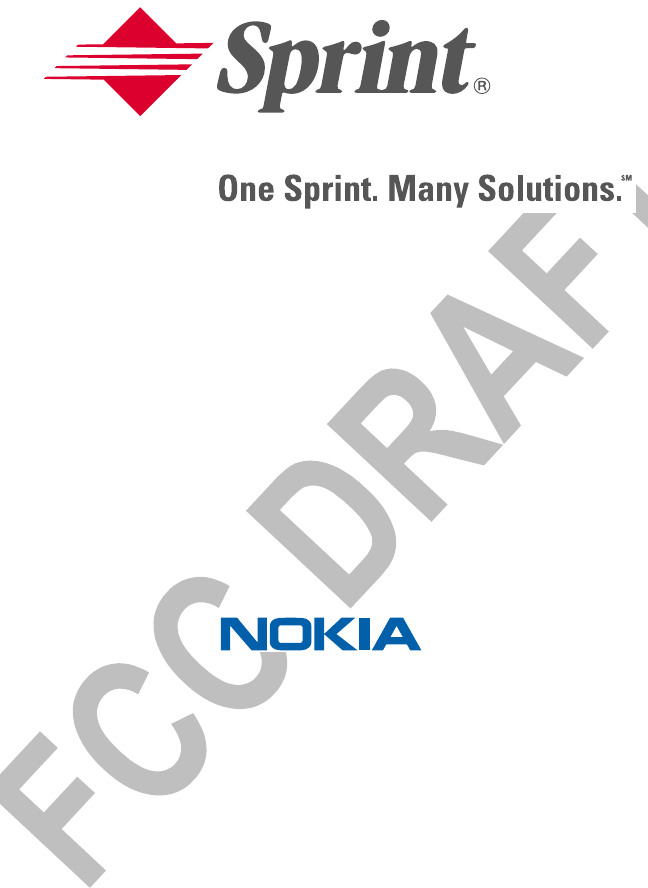
User’s Guide
PCS Phone
2285


Table of Contents
Welcome to Sprint . . . . . . . . . . . . . . . . . . . . . . . . . . . . . . . . . . . i
Introduction to this User’s Guide. . . . . . . . . . . . . . . . . . . . . . iii
Section 1: Getting Started. . . . . . . . . . . . . . . . . . . . . . . . . . . . . 1
1A.Setting Up Service . . . . . . . . . . . . . . . . . . . . . . . . . . . . . . . . . . . . . . . . . . . 3
Getting Started With PCS Service. . . . . . . . . . . . . . . . . . . . . . . . . . . . . . . . .4
Setting Up Your Voicemail . . . . . . . . . . . . . . . . . . . . . . . . . . . . . . . . . . . . . .5
Getting Help . . . . . . . . . . . . . . . . . . . . . . . . . . . . . . . . . . . . . . . . . . . . . . . . .5
Section 2: Understanding Your PCS Phone. . . . . . . . . . . . . . 7
2A.Your PCS Phone: The Basics . . . . . . . . . . . . . . . . . . . . . . . . . . . . . . . . . . 9
Front View of Phone. . . . . . . . . . . . . . . . . . . . . . . . . . . . . . . . . . . . . . . . . .10
Key Functions. . . . . . . . . . . . . . . . . . . . . . . . . . . . . . . . . . . . . . . . . . . . . . .11
Viewing the Display Screen . . . . . . . . . . . . . . . . . . . . . . . . . . . . . . . . . . . .12
Features of Your PCS Phone by Nokia (2285) . . . . . . . . . . . . . . . . . . . . . .13
Turning Your Phone On and Off . . . . . . . . . . . . . . . . . . . . . . . . . . . . . . . .14
Using the Battery. . . . . . . . . . . . . . . . . . . . . . . . . . . . . . . . . . . . . . . . . . . . .15
Displaying Your Phone Number. . . . . . . . . . . . . . . . . . . . . . . . . . . . . . . . .17
Making and Answering Calls. . . . . . . . . . . . . . . . . . . . . . . . . . . . . . . . . . . .18
Making Calls. . . . . . . . . . . . . . . . . . . . . . . . . . . . . . . . . . . . . . . . . . . . . . .18
Answering Calls . . . . . . . . . . . . . . . . . . . . . . . . . . . . . . . . . . . . . . . . . . . .19
Missed Call Notification. . . . . . . . . . . . . . . . . . . . . . . . . . . . . . . . . . . . . .20
Calling Emergency Numbers. . . . . . . . . . . . . . . . . . . . . . . . . . . . . . . . . .20
Dialing Options . . . . . . . . . . . . . . . . . . . . . . . . . . . . . . . . . . . . . . . . . . . .20
In-Call Options. . . . . . . . . . . . . . . . . . . . . . . . . . . . . . . . . . . . . . . . . . . . .21
End-of-Call Options . . . . . . . . . . . . . . . . . . . . . . . . . . . . . . . . . . . . . . . . .21
Saving a Phone Number . . . . . . . . . . . . . . . . . . . . . . . . . . . . . . . . . . . . .21
Dialing and Saving Phone Numbers With Pauses . . . . . . . . . . . . . . . . . .22
Dialing From the Internal Phone Book . . . . . . . . . . . . . . . . . . . . . . . . . .23
Using One-Touch Dialing. . . . . . . . . . . . . . . . . . . . . . . . . . . . . . . . . . . . .23
2B.Controlling Your Phone’s Settings . . . . . . . . . . . . . . . . . . . . . . . . . . . . 25
Customizing Profiles. . . . . . . . . . . . . . . . . . . . . . . . . . . . . . . . . . . . . . . . . .26
Selecting a Profile . . . . . . . . . . . . . . . . . . . . . . . . . . . . . . . . . . . . . . . . . . . .26
Selecting Silent Mode . . . . . . . . . . . . . . . . . . . . . . . . . . . . . . . . . . . . . . . . .26
Adjusting Volume Settings . . . . . . . . . . . . . . . . . . . . . . . . . . . . . . . . . . . . .27
Ringing Tones . . . . . . . . . . . . . . . . . . . . . . . . . . . . . . . . . . . . . . . . . . . . . . .27
Customizing Ringing Tones. . . . . . . . . . . . . . . . . . . . . . . . . . . . . . . . . . .27
Selecting Ringing Tones for Messages. . . . . . . . . . . . . . . . . . . . . . . . . . .28
Customizing Alert Notifications . . . . . . . . . . . . . . . . . . . . . . . . . . . . . . . . .28
Location Settings. . . . . . . . . . . . . . . . . . . . . . . . . . . . . . . . . . . . . . . . . . . . .29
Customizing the Welcome Note . . . . . . . . . . . . . . . . . . . . . . . . . . . . . . . .30

Customizing the Display Banner . . . . . . . . . . . . . . . . . . . . . . . . . . . . . . . .30
Adjusting the Screen Brightness. . . . . . . . . . . . . . . . . . . . . . . . . . . . . . . . .30
TTY Use With PCS Service From Sprint. . . . . . . . . . . . . . . . . . . . . . . . . . .31
2C.Setting Your Phone’s Security . . . . . . . . . . . . . . . . . . . . . . . . . . . . . . . . 33
Accessing the Security Menu . . . . . . . . . . . . . . . . . . . . . . . . . . . . . . . . . . .34
Locking Your Phone. . . . . . . . . . . . . . . . . . . . . . . . . . . . . . . . . . . . . . . . . .34
Unlocking Your Phone. . . . . . . . . . . . . . . . . . . . . . . . . . . . . . . . . . . . . . . .34
Changing the Lock Code . . . . . . . . . . . . . . . . . . . . . . . . . . . . . . . . . . . . . .35
Calling in Lock Mode . . . . . . . . . . . . . . . . . . . . . . . . . . . . . . . . . . . . . . . . .35
Locking and Unlocking Your Keypad . . . . . . . . . . . . . . . . . . . . . . . . . . . .35
Restricting Calls . . . . . . . . . . . . . . . . . . . . . . . . . . . . . . . . . . . . . . . . . . . . .36
Removing Call Restrictions. . . . . . . . . . . . . . . . . . . . . . . . . . . . . . . . . . . . .36
Using Allowed Numbers When Phone is Locked . . . . . . . . . . . . . . . . . . .37
Erasing the Internal Phone Book . . . . . . . . . . . . . . . . . . . . . . . . . . . . . . . .37
Resetting Your Phone. . . . . . . . . . . . . . . . . . . . . . . . . . . . . . . . . . . . . . . . .37
2D.Controlling Your Roaming Experience . . . . . . . . . . . . . . . . . . . . . . . . . 41
Understanding Roaming . . . . . . . . . . . . . . . . . . . . . . . . . . . . . . . . . . . . . . .42
Setting Your Phone’s Roam Mode . . . . . . . . . . . . . . . . . . . . . . . . . . . . . . .43
Controlling Roaming Charges Using Call Guard . . . . . . . . . . . . . . . . . . . .43
2E.Navigating Through Menus . . . . . . . . . . . . . . . . . . . . . . . . . . . . . . . . . . 45
Menu Navigation. . . . . . . . . . . . . . . . . . . . . . . . . . . . . . . . . . . . . . . . . . . . .46
Menu Structure . . . . . . . . . . . . . . . . . . . . . . . . . . . . . . . . . . . . . . . . . . . . . .46
Reviewing the Main Menu . . . . . . . . . . . . . . . . . . . . . . . . . . . . . . . . . . . . .46
Viewing the Menus. . . . . . . . . . . . . . . . . . . . . . . . . . . . . . . . . . . . . . . . . . .48
Reviewing the Contacts Menu . . . . . . . . . . . . . . . . . . . . . . . . . . . . . . . . . .50
2F. Managing Call Logs . . . . . . . . . . . . . . . . . . . . . . . . . . . . . . . . . . . . . . . . . 51
Viewing Call Logs . . . . . . . . . . . . . . . . . . . . . . . . . . . . . . . . . . . . . . . . . . . .52
Call Logs Options . . . . . . . . . . . . . . . . . . . . . . . . . . . . . . . . . . . . . . . . . . . .52
Making a Call. . . . . . . . . . . . . . . . . . . . . . . . . . . . . . . . . . . . . . . . . . . . . . . .53
Viewing the Duration of a Call . . . . . . . . . . . . . . . . . . . . . . . . . . . . . . . . . .53
Viewing a Phone Number. . . . . . . . . . . . . . . . . . . . . . . . . . . . . . . . . . . . . .53
Using a Phone Number. . . . . . . . . . . . . . . . . . . . . . . . . . . . . . . . . . . . . . . .53
Saving a Phone Number . . . . . . . . . . . . . . . . . . . . . . . . . . . . . . . . . . . . . . .54
Adding a Phone Number to a Contact Entry . . . . . . . . . . . . . . . . . . . . . . .54
Deleting a Phone Number . . . . . . . . . . . . . . . . . . . . . . . . . . . . . . . . . . . . .55
2G.Using the Internal Phone Book . . . . . . . . . . . . . . . . . . . . . . . . . . . . . . . 57
Internal Phone Book Entry Options . . . . . . . . . . . . . . . . . . . . . . . . . . . . . .58
Selecting a Character Input Mode . . . . . . . . . . . . . . . . . . . . . . . . . . . . . . .58
Adding a New Contact . . . . . . . . . . . . . . . . . . . . . . . . . . . . . . . . . . . . . . . .60
Finding Contacts. . . . . . . . . . . . . . . . . . . . . . . . . . . . . . . . . . . . . . . . . . . . .60
Adding a Phone Number to a Contact . . . . . . . . . . . . . . . . . . . . . . . . . . . .61
Editing the Phone Number of an Existing Contact . . . . . . . . . . . . . . . . . .62
Editing the Name of an Existing Contact . . . . . . . . . . . . . . . . . . . . . . . . . .62
Selecting a Ringing Tone for a Contact . . . . . . . . . . . . . . . . . . . . . . . . . . .62

Dialing PCS Services . . . . . . . . . . . . . . . . . . . . . . . . . . . . . . . . . . . . . . . . . .63
Deleting Contacts . . . . . . . . . . . . . . . . . . . . . . . . . . . . . . . . . . . . . . . . . . . .63
2H.Personal Organizer and Tools . . . . . . . . . . . . . . . . . . . . . . . . . . . . . . . . 65
Adding an Event to Your Calendar. . . . . . . . . . . . . . . . . . . . . . . . . . . . . . .66
Receiving Event Alerts . . . . . . . . . . . . . . . . . . . . . . . . . . . . . . . . . . . . . . . .66
Event Alert Options. . . . . . . . . . . . . . . . . . . . . . . . . . . . . . . . . . . . . . . . . . .67
Viewing Events and Event Options . . . . . . . . . . . . . . . . . . . . . . . . . . . . . .67
Deleting an Event . . . . . . . . . . . . . . . . . . . . . . . . . . . . . . . . . . . . . . . . . . . .67
Deleting Events Automatically . . . . . . . . . . . . . . . . . . . . . . . . . . . . . . . . . .67
Viewing Today’s Calendar Menu . . . . . . . . . . . . . . . . . . . . . . . . . . . . . . . .68
Using Your Phone’s Tools . . . . . . . . . . . . . . . . . . . . . . . . . . . . . . . . . . . . .68
Playing Games . . . . . . . . . . . . . . . . . . . . . . . . . . . . . . . . . . . . . . . . . . . . .68
Using the Alarm Clock. . . . . . . . . . . . . . . . . . . . . . . . . . . . . . . . . . . . . . .68
Using the Calculator . . . . . . . . . . . . . . . . . . . . . . . . . . . . . . . . . . . . . . . .69
Using the Currency Converter . . . . . . . . . . . . . . . . . . . . . . . . . . . . . . . .69
Using the To-do List. . . . . . . . . . . . . . . . . . . . . . . . . . . . . . . . . . . . . . . . .70
Using the Stopwatch . . . . . . . . . . . . . . . . . . . . . . . . . . . . . . . . . . . . . . . .70
2I. Using Your Phone’s Voice Services . . . . . . . . . . . . . . . . . . . . . . . . . . . 73
Using Voice-Activated Dialing. . . . . . . . . . . . . . . . . . . . . . . . . . . . . . . . . . .74
Changing a Voice Tag. . . . . . . . . . . . . . . . . . . . . . . . . . . . . . . . . . . . . . . . .75
Deleting a Voice Tag. . . . . . . . . . . . . . . . . . . . . . . . . . . . . . . . . . . . . . . . . .75
Recording Voice Memos. . . . . . . . . . . . . . . . . . . . . . . . . . . . . . . . . . . . . . .75
Voice Memo Options . . . . . . . . . . . . . . . . . . . . . . . . . . . . . . . . . . . . . . . . .76
Deleting a Voice Memo. . . . . . . . . . . . . . . . . . . . . . . . . . . . . . . . . . . . . . . .76
Section 3: Using PCS Service Features . . . . . . . . . . . . . . . . 77
3A.PCS Service Features: The Basics . . . . . . . . . . . . . . . . . . . . . . . . . . . . 79
Using Voicemail . . . . . . . . . . . . . . . . . . . . . . . . . . . . . . . . . . . . . . . . . . . . .80
Setting Up Your Voicemail . . . . . . . . . . . . . . . . . . . . . . . . . . . . . . . . . . .80
Voicemail Notification. . . . . . . . . . . . . . . . . . . . . . . . . . . . . . . . . . . . . . .80
New Voicemail Message Alerts . . . . . . . . . . . . . . . . . . . . . . . . . . . . . . . .80
Retrieving Your Voicemail Messages . . . . . . . . . . . . . . . . . . . . . . . . . . .81
Voicemail Options. . . . . . . . . . . . . . . . . . . . . . . . . . . . . . . . . . . . . . . . . .82
Voicemail Menu Key . . . . . . . . . . . . . . . . . . . . . . . . . . . . . . . . . . . . . . . .85
Using Caller ID . . . . . . . . . . . . . . . . . . . . . . . . . . . . . . . . . . . . . . . . . . . . . .86
Responding to Call Waiting . . . . . . . . . . . . . . . . . . . . . . . . . . . . . . . . . . . .86
Making a Three-Way Call . . . . . . . . . . . . . . . . . . . . . . . . . . . . . . . . . . . . . .86
Using Call Forwarding . . . . . . . . . . . . . . . . . . . . . . . . . . . . . . . . . . . . . . . .87
3B.Extras . . . . . . . . . . . . . . . . . . . . . . . . . . . . . . . . . . . . . . . . . . . . . . . . . . . . . 89
Games . . . . . . . . . . . . . . . . . . . . . . . . . . . . . . . . . . . . . . . . . . . . . . . . . . . . .90
Ringers . . . . . . . . . . . . . . . . . . . . . . . . . . . . . . . . . . . . . . . . . . . . . . . . . . . .91
3C.PCS Voice CommandSM . . . . . . . . . . . . . . . . . . . . . . . . . . . . . . . . . . . . . . 93
Getting Started With PCS Voice Command . . . . . . . . . . . . . . . . . . . . . . . .94
Creating Your Own Address Book. . . . . . . . . . . . . . . . . . . . . . . . . . . . . . .94

Making a Call With PCS Voice Command . . . . . . . . . . . . . . . . . . . . . . . . .95
Accessing Information Using PCS Voice Command . . . . . . . . . . . . . . . . .95
Section 4: Safety Guidelines and Warranty Information . 97
4A.Safety . . . . . . . . . . . . . . . . . . . . . . . . . . . . . . . . . . . . . . . . . . . . . . . . . . . . . 99
Getting the Most Out of Your Reception. . . . . . . . . . . . . . . . . . . . . . . . .100
Maintaining Safe Use of and Access to Your Phone. . . . . . . . . . . . . . . . .101
Caring for the Battery . . . . . . . . . . . . . . . . . . . . . . . . . . . . . . . . . . . . . . . .104
Acknowledging Special Precautions and the FCC Notice . . . . . . . . . . . .105
Consumer Information on Wireless Phones . . . . . . . . . . . . . . . . . . . . . .107
Owner’s Record . . . . . . . . . . . . . . . . . . . . . . . . . . . . . . . . . . . . . . . . . . . .126
User Guide Proprietary Notice. . . . . . . . . . . . . . . . . . . . . . . . . . . . . . . . .126
Accessibility information . . . . . . . . . . . . . . . . . . . . . . . . . . . . . . . . . . . . .127
4B.Manufacturer’s Warranty . . . . . . . . . . . . . . . . . . . . . . . . . . . . . . . . . . . 129
Manufacturer’s Warranty . . . . . . . . . . . . . . . . . . . . . . . . . . . . . . . . . . . . .130

i
Welcome to Sprint
print built the largest all-digital, all-PCS nationwide network
with advanced multimedia services, reaching more than
230 million people for clarity you can see and hear. We built
our network to give you what we believe you really want from a
wireless phone, clear sound, private conversations, and
time-saving features.
But with Sprint, you can do something even more far-reaching –
simplify your life. Our advanced technology is designed to grow
with your communications needs so that one day you'll be able to
rely entirely on your PCS Phone to stay connected.
This guide will familiarize you with our technology and your new
Vision-enabled PCS Phone through simple, easy-to-follow
instructions. If you have already reviewed the Start Here Guide,
which was packaged with your new phone, then you're ready to
explore the advanced features outlined in this guide.
If you have not read your Start Here Guide, go to Section One -
Getting Started. This section provides all the information you need
to quickly activate your phone, set up your voicemail, and much
more. It also contains information on how to contact Sprint should
you have questions about service, wish to check your account
balance, or want to purchase additional products or services.
Thank you for choosing Sprint.
S

ii

iii
Introduction to this User’s Guide
his User’s Guide introduces you to PCS Service and all the
features of your new phone. It’s divided into four sections:
䊳Section 1: Getting Started
䊳Section 2: Understanding Your Phone
䊳Section 3: Using PCS Service Features
䊳Section 4: Safety and Warranty Information
Throughout the guide, you’ll find tips that highlight special
shortcuts and timely reminders to help you make the most of your
new phone and service. The Table of Contents and Index will help
you locate specific information quickly.
You’ll get the most out of your phone if you read each section.
However, if you’d like to get right to a specific feature, simply turn
to that page. Follow the instructions in that section and you’ll be
ready to use your phone in no time.
Tip: You can print this guide to keep on hand or view it online. If you’re
viewing it online, simply click on a topic in the Table of Contents or Index
on any page reference within a section. The PDF will automatically display
the appropriate page.
T


Section 1
Getting Started


Section 1: Getting Started
1A: Setting Up Service 3
Section 1A
Setting Up Service
In This Section
䊳Getting Started With PCS Service
䊳Setting Up Voicemail
䊳Getting Help
his section walks you through setting up service for your
PCS Phone, unlocking your phone, setting up your voicemail,
and how to contact Sprint for assistance with your PCS Service.
T

Section 1: Getting Started
4 1A: Setting Up Service
Getting Started With PCS Service
Determine If Your Phone Is Already Activated
If you received your phone in the mail or purchased it at a
Sprint Store, it probably has been activated. All you need to do
is unlock your phone.
If your phone is not activated, please refer to the Start Here
Guide included with your phone.
Unlocking Your Phone
Follow these steps to unlock your phone:
1. Press and hold to turn the phone on.
2. Press Menu, then enter your four-digit lock code. For
security purposes, the code is not visible as you type.
Note: The left and right softkey buttons ( and ) correspond
with the softkey actions shown on the bottom line of your phone’s display
screen. Softkey actions change according to the screen you’re viewing
and will not appear if there is no corresponding action available.
Tip: If you can’t recall your lock code, try using the last four digits of either
your Social Security number or PCS Phone Number or try 0000. If none of
these work, call PCS Customer Service SolutionsSM at 1-888-211-4PCS (4727).
Activating Your Phone
To activate your phone, follow the directions in the Start Here
Guide included with your phone. You can also visit
http://activate.sprintpcs.com and activate your phone online.

Section 1: Getting Started
1A: Setting Up Service 5
Setting Up Your Voicemail
All unanswered calls to your PCS Phone are automatically
transferred to voicemail, even if your phone is in use or turned
off. Therefore, you will want to set up your voicemail and
personal greeting as soon as your PCS Phone is activated.
To set up voicemail:
1. Press and hold .
2. Follow the system prompts to create your pass code, record
your greeting, record your name announcement, and choose
whether to activate One-Touch Message Access (a feature that
lets you access messages simply by pressing and holding ,
bypassing the need for you to enter your pass code).
Note: The voicemail setup process may vary in certain Affilitate areas.
For more information about using your voicemail, see "Using
Your Phone’s Voice Services" on page 73.
Getting Help
Visit Our Web Site
Stop by www.sprintpcs.com and log on to get up-to-date
information on PCS Services, options and more.
You can also:
䊳Review coverage maps
䊳Learn how to use voicemail
䊳Access your account information
䊳Purchase accessories
䊳Add additional options to your service plan
䊳Check out frequently asked questions
䊳And more
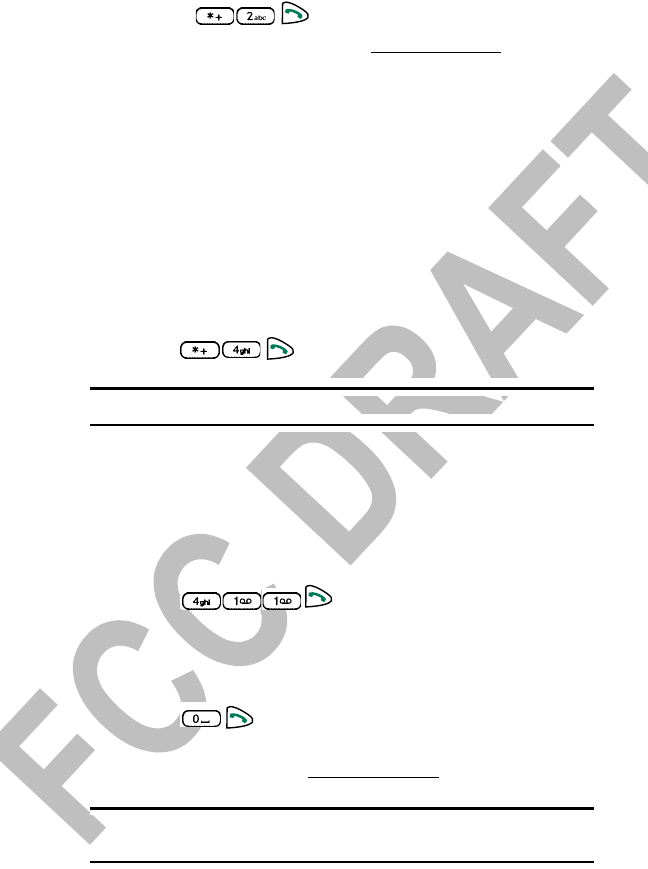
Section 1: Getting Started
6 1A: Setting Up Service
Reaching PCS Customer Service SolutionsSM
You can reach PCS Customer Service Solutions by:
䊳Dialing on your PCS Phone
䊳Logging on to your account at www.sprintpcs.com
䊳Calling us toll-free at 1-888-211-4727 (Consumer customers),
1-877-CLEARPY (253-2779) (Clear Pay customers), or
1-888-788-4727 (Business customers)
䊳Writing to us at PCS Customer Solutions, P.O. Box 8077,
London, KY 40742
Receiving Automated Invoicing Information
For your convenience, your phone gives you access to invoicing
information on your PCS Account. This information includes
balance due, payment received, invoicing cycle, and the amount
of minutes and/or data used since your last invoicing cycle.
(Airtime charges will apply.)
䊳Press .
Note: This service may not be available in all Affiliate markets.
PCS Directory Assistance
PCS Directory Assistance provides a variety of services,
including residential, business, and government listings;
assistance with local or long-distance calls; movie listings; hotel,
restaurant, shopping, and major local event information. There
is a per-call charge and you will be billed for airtime.
䊳Press .
PCS Operator Services
PCS Operator Services can provide assistance in placing collect
calls or calls billed to a local telephone calling card or third party.
䊳Press .
For more information or to see the latest in products and
services, visit us online at www.sprintpcs.com.
Note: PCS Operator Services may not be available in all
Affiliate markets.

Section 2
Understanding Your
PCS Phone


Section 2: Understanding Your PCS Phone
2A: Your PCS Phone - The Basics 9
Section 2A
Your PCS Phone: The Basics
In This Section
䊳Front View of Phone
䊳Viewing the Display Screen
䊳Features of Your Nokia 2285 Phone
䊳Turning Your Phone On and Off
䊳Using the Battery and Charger
䊳Displaying Your Phone Number
䊳Making and Answering Calls
our PCS Phone is packed with features that simplify your life
and expand your ability to stay connected to the people and
information that are important to you. This section will guide you
through the basic functions and calling features of your phone.
Y
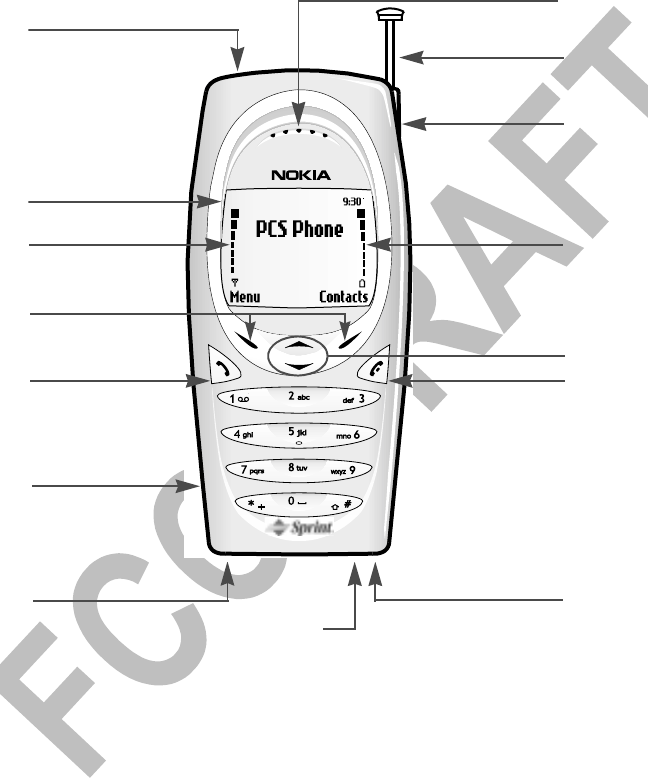
Section 2: Understanding Your PCS Phone
10 2A: Your PCS Phone - The Basics
Front View of Phone
3. Signal Indicator
5. Talk Key
7. AC Adapter Jack
14. Whip Antenna
10. End Call Key
9. Nokia Pop-PortTM
Accessory
Connector
4. Left/Right
Selection Keys
6. Speaker Port
1
. Switch On/Off Button
2
. Display Screen
8. Microphone
12. Battery Strength
Indicator
13. Headset Jack
11. Up/Down
Scroll Keys
15. Earpiece

Section 2: Understanding Your PCS Phone
2A: Your PCS Phone - The Basics 11
Key Functions
1. Switch On/Off Button: Switches your phone on or off.
2. Display Screen: Displays phone status icons and menu items.
3. Signal Indicator: Indicates current signal strength.
4. Left /Right Selection Keys: Allow you to select actions or items
within certain menu screens.
5. Talk Key: Lets you place or answer a call.
6. Speaker Port: Lets you hear phone tones and ringing tones.
7. AC Adapter Jack: Connects phone to battery recharger.
8. Microphone: Transmits voice.
9. Nokia Pop-PortTM Accessory Connector: Provides connection
to your personal computer or laptop computer and car kit,
as well as to other accessories.
10. End Call Key: Ends calls and clears text from display screen.
11. Up/Down Scroll Keys: Scroll through menu screens, highlight
menu items, or navigate through your calendar.
12. Battery Strength Indicator: Indicates current battery strength.
13. Headset Jack: Provides connection for a universal 2.5-mm
headset.
14. Whip Antenna: Extendable antenna that increases reception
in weak-signal areas.
15. Earpiece: Allows you to listen to voice and prompts.
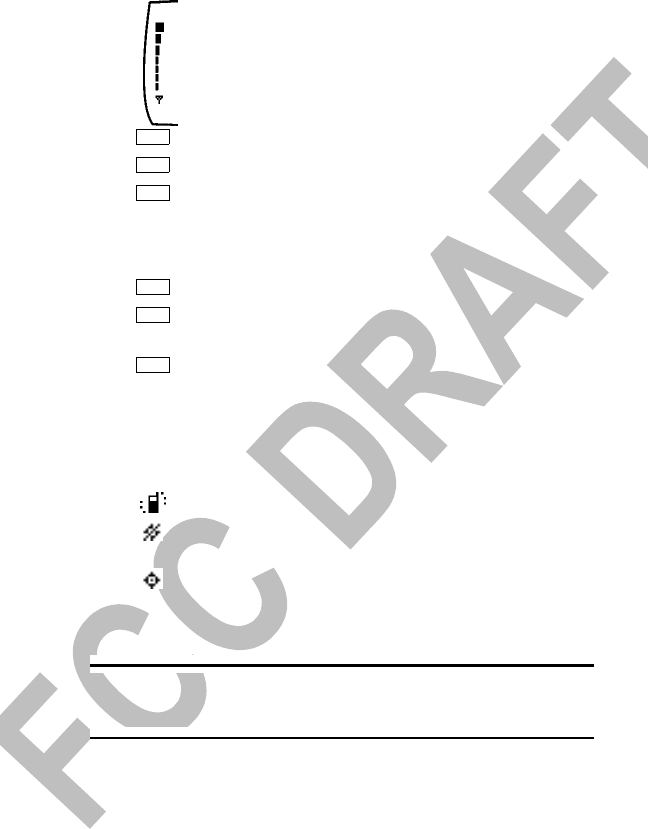
Section 2: Understanding Your PCS Phone
12 2A: Your PCS Phone - The Basics
Viewing the Display Screen
This list identifies the symbols you’ll see on your display screen.
䊳 shows your current signal strength. The more lines
you have, the stronger your signal.
䊳 means your phone cannot find a signal.
䊳 tells you a call is in progress.
䊳 indicates you are “roaming” off the enhanced
Sprint Nationwide PCS Network. (If you are roaming on an
analog system, your phone’s display will show the roaming
icon and an “Analog Roam” text alert.)
䊳 indicates you have new text messages.
䊳 indicates you have voicemail messages. Press and
hold to call your voicemail box.
䊳 indicates you have new text and voice messages.
䊳
䊳
䊳
䊳
䊳 indicates that your Vibrating alert is activated.
䊳 indicates that Location Info Sharing is set to share your
location with the network only during emergency calls.
䊳 indicates that Location Info Sharing is set to share your
location with the network any time that the phone is
switched on and activated.
Tip: Display indicators let you know when you’re off the enhanced
Sprint Nationwide PCS Network and whether you’re operating in digital
or analog mode.

Section 2: Understanding Your PCS Phone
2A: Your PCS Phone - The Basics 13
Features of Your PCS Phone by Nokia (2285)
Congratulations on the purchase of your PCS Phone by Nokia
(2285). This phone is lightweight, easy-to-use, and reliable. It
also offers many significant features and service options:
䊳Dual-band capability provides access to other PCS Digital
Networks where Sprint has implemented roaming
agreements (page xx).
䊳PCS Voice CommandSM lets you dial phone numbers by
speaking someone’s name or the digits in their phone
number (page xx).
䊳The built-in organizer lets you schedule alerts to remind you
of important events (page xx).
䊳Five hundred internal phone book entries store up to five
phone numbers each (page xx).
䊳
䊳
䊳
䊳

Section 2: Understanding Your PCS Phone
14 2A: Your PCS Phone - The Basics
Turning Your Phone On and Off
Turning Your Phone On
To turn your phone on, press for approximately
two seconds.
Once your phone is on, it displays “Searching for Service”
which indicates that your phone is searching for a signal. When
your phone finds a signal, it automatically enters standby mode –
the phone’s idle state. At this point, you are ready to begin
making and receiving calls.
If your phone is unable to find a signal after 15 minutes of
searching, a Power Save feature is automatically activated.
When a signal is found, your phone automatically returns to
standby mode.
In Power Save mode, your phone searches for a signal
periodically without your intervention. You can also initiate a
search for PCS Service by pressing any key (when your phone is
turned ON).
Tip: The Power Save feature helps to conserve your battery power when
you are in an area where there is no signal.
Turning Your Phone OFF
Press for two seconds until you see the powering down
animation on the display screen.
Your screen remains blank while your phone is off (unless the
battery is charging).
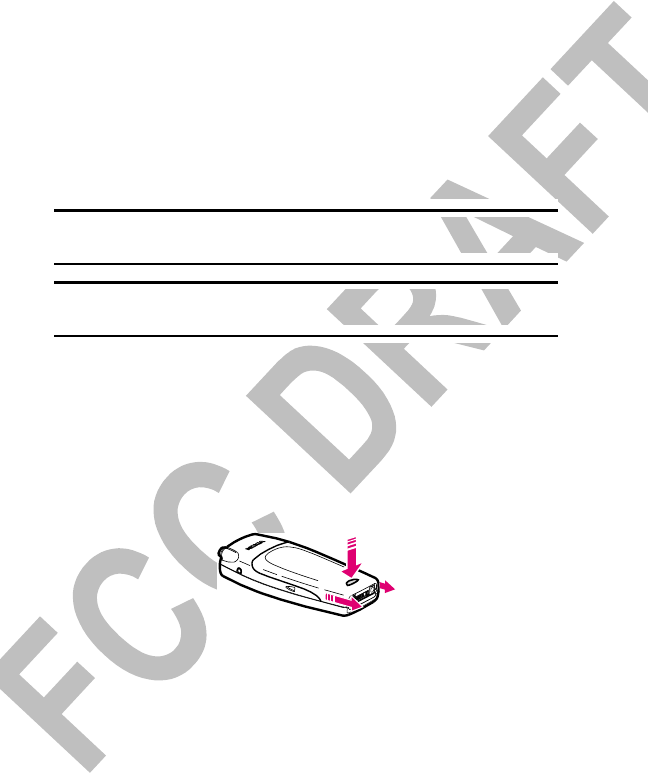
Section 2: Understanding Your PCS Phone
2A: Your PCS Phone - The Basics 15
Using the Battery
Battery Capacity
Your PCS Phone is equipped with a Lithium Ion (LiIon) battery.
It allows you to recharge your battery before it is fully drained.
The battery provides approximately 3.5 hours of continuous
digital talk time or approximately 360 hours (almost 15 days) of
continuous digital standby time.
When the battery charge is getting low, the “Battery low. Please
recharge.” message is displayed on your screen, and the phone
sounds a warning tone. When the battery is too weak to further
operate the phone, the message “Switching off. Please
recharge.” is displayed on your screen.
Note: Long backlight settings, searching for service, vibrate mode and
browser use affect the battery’s talk and standby times.
Tip: Be sure to watch your phone’s battery level indicator and charge the
battery before it runs out of power.
Installing the Battery
Your PCS Phone comes with a LiIon battery. To install or
replace the battery, or to access your phone’s ESN (electronic
serial number), you must first remove the phone’s back cover.
To remove the back cover:
䊳Press and hold the release button while sliding the cover
downward towards the bottom of the phone.
To install the battery:

16
䊳Insert the battery, label side up, into the opening on the
back of the phone and gently press down until the battery
snaps into place.
Removing the Battery
To remove your battery, follow these easy steps:
1. Make sure the power is off so that you don’t lose any stored
numbers or messages.
2. Remove the back cover pressing and holding the release
button while sliding the cover downward towards the
bottom of the phone.
3. Pull upward on the lower end of the battery with your
finger tip and remove the battery from the phone at a 45-
degree angle.
Charging the Battery
Your PCS Phone comes with a rechargeable battery. You should
charge the battery as soon as possible so you can begin using
your phone.
Keeping track of your battery’s charge is
important. If your battery level becomes
too low, your phone automatically turns off
and you will lose all the information you
were just working on. For a quick check of
your phone’s battery level, glance at the
battery charge indicator located in the
upper-right corner of your phone’s display screen.
Always use a Sprint- or Nokia-approved desktop charger, travel
charger, or vehicle power adapter to charge your battery.
Battery
Strength
Indicator

Section 2: Understanding Your PCS Phone
2A: Your PCS Phone - The Basics 17
Warning! Using the wrong battery charger could cause damage to your
phone and void the warranty.
To use the charger:
1. Plug the electrical prongs into the wall outlet first, then
plug the round end of the AC adapter into the desktop
charger (or directly into your phone’s AC Adapter Jack).
2. If the round end of the AC adapter was plugged into the
desktop charger, place the phone in the desktop charger. If
the phone is on, the screen briefly displays a “Charging”
message followed immediately by a continuous scrolling
battery indicator. If the phone is off, only the scrolling
indicator is displayed.
3. When the battery is fully charged, the screen displays a
“Battery full” notification, and the indicator stops scrolling.
Unplug the phone from the charger.
It takes approximately 4 hours to fully recharge a completely
rundown battery. With the Sprint-approved LiIon battery, you
can recharge the battery before it becomes completely run
down.
Displaying Your Phone Number
Just in case you forget your phone number, your PCS Phone can
remind you.
To display your phone number:
1. Press Menu, scroll to Phone details, and press Select.
2. Scroll to My phone no. and press Select. Your phone number
is displayed.
3. Press to return to the standby mode.
Note: To access the phone’s main menu, press Menu from the standby
mode. Menu items may be selected by scrolling to them with the and
scroll keys and pressing Select, or you can press the number
corresponding to the menu item on your keypad.
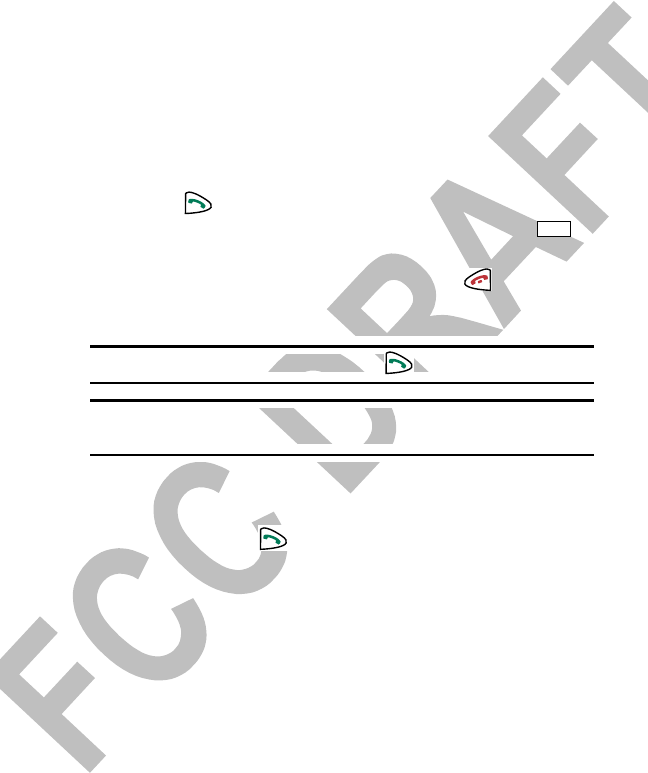
Section 2: Understanding Your PCS Phone
18 2A: Your PCS Phone - The Basics
Making and Answering Calls
Making Calls
Your PCS Phone offers many different ways to make calls,
including direct dialing, PCS Voice CommandSM (page xx), One-
touch Dialing from your internal phone book (page xx) and
using Call Logs (page xx).
To make a call using your keypad:
1. Make sure your phone is on.
2. Enter a phone number. (If you make a mistake while dialing,
press Clear to erase one digit at a time, or press and hold
Clear to erase the entire number.)
3. Press . (To make calls when you are roaming and
Call Guard is enabled, highlight Roam Call and press .
See “Call Guard” on page xx.)
4. When you are finished with the call, press or End call
to end the call and return to standby mode.
Tip: To redial your last outgoing call, press twice.
Tip: When making calls off the enhanced Sprint Nationwide PCS Network,
always dial using 11 digits (1 + area code + phone number).
1-Touch Dialing
1-touch dialing allows you to speed dial by simply pressing one
designated key and . To use 1-touch dialing, you must first
assign a number to a particular key:
1. Press Contacts, scroll to 1-touch dialing, and press Select. Key
numbers 2–9 are displayed.
2. Scroll to the key number you wish to assign and press
Assign.
3. Enter the number you wish to assign to this key, and press
OK. Enter the name you wish to assign to this key, and press
OK. If 1-touch dialing is not activated, your phone will ask
you if you wish to activate it now. Press Yes or No.
– or –

Section 2: Understanding Your PCS Phone
2A: Your PCS Phone - The Basics 19
4. If the number already exists in your Internal Phone Book,
press Search to find it, and press Select.
To activate 1-touch dialing:
1. Press Menu, scroll to Settings, and press Select.
2. Scroll to Call settings and press Select.
3. Scroll to 1-touch dialing and press Select.
4. Scroll to On and press Select.
To make a call using 1-touch dialing:
▲Press the key assigned to the number you wish to dial, and
press , or press and hold the assigned key for 2 seconds.
Voice Dialing
You can also make calls by voice-activated commands. (See .)
Answering Calls
1. Make sure your phone is on. If your phone is off, incoming
calls go to voicemail.
2. When a call comes in, answer the call by pressing .
Depending on your settings, your PCS Phone notifies you of
incoming calls in the following ways:
䊳The phone rings or vibrates.
䊳The backlight illuminates.
䊳The screen displays an incoming call message.
䊳If available, the phone number of the caller is displayed.
䊳If the phone number is in your contacts list, the Phone Book
entry’s name is displayed.
The following options are available.
䊳Press Answer to answer the call.
䊳Press Silence or to mute the ringing tone. If you do not
answer the call, it will be forwarded to your voicemail.
Depending on your settings, you may also answer incoming calls
simply by pressing any digit. See Anykey answer on page.... (To
answer a call when you are roaming and Call Guard is enabled,
you must press OK to answer the call. See “Call Guard” on page
xx.)
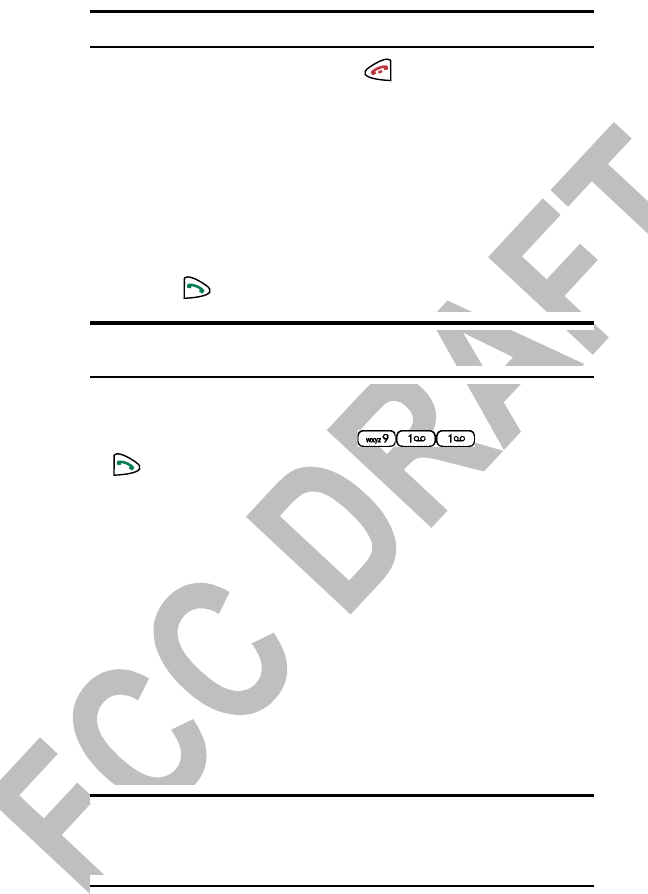
Section 2: Understanding Your PCS Phone
20 2A: Your PCS Phone - The Basics
Note: If your phone is off, incoming calls go to voicemail.
3. To disconnect the call, press or End call.
Missed Call Notification
When an incoming call is not answered, the “1 Missed call”
message is displayed on your screen.
To display the missed call:
䊳Press List.
To dial the phone number after viewing it:
䊳Press .
Note: The “Missed call” message may not display when roaming out of
network.
Calling Emergency Numbers
Your can place calls to 911 (dial , then press
), even if your phone is locked or your account is
restricted.
Dialing Options
Dialing options are displayed when you enter numbers in the
phone’s standby mode.
To select an option, press Options, then press:
䊳Save to save the number in your contacts list. (See ...)
䊳Add to contact to add the number to an existing contact in
your contacts list.
䊳Call to dial the phone number. If you are roaming and have
the Call Guard feature activated, select OK. (See “To turn
the....)
Tip: To speed dial a phone number from standby mode, press and hold the
speed dial number. If the speed dial number is two digits, enter the first
digit, then press and hold the second digit. (This feature will not work when
you are roaming and Call Guard is enabled.)

Section 2: Understanding Your PCS Phone
2A: Your PCS Phone - The Basics 21
In-Call Options
During a call, your phone displays menu options in addition to
the main menu.
To select an option, press Options, then scroll to your desired
option and press Select.
䊳My phone no. to display your number. This option is only
available during emergency (911) calls.
䊳Mute to mute your phone’s microphone.
䊳Unmute to reactivate the microphone if you had earlier
muted your phone.
䊳Three-way call to call a third party.
䊳End all calls to end all calls.
䊳Touch tones to send a touch-tone string during a call.
䊳Contacts to open your Internal Phone Book menu options.
䊳Menu to view options from your main menu.
End-of-Call Options
After making or receiving a call, the phone number you called
or received is temporarily saved in your Call logs menu. To view
your number and options:
1. Press Menu, scroll to Call logs, and press Select.
2. Scroll to Outgoing calls, Incoming calls, or Missed calls and
press Select. The most recent number appears at the top of
the list.
3. Press Options, scroll to your preferred option, and press
Select.
After receiving a call from or making a call to a phone number
that is in your Internal Phone Book, the contact’s name, phone
number, and the duration of the call are displayed.
Note: The End-of-Call options are not displayed for calls identified as
No ID or Restricted.
Saving a Phone Number
Your PCS Phone can store up to five phone numbers in
each of 99 Internal Phone Book entries. Each entry’s name

22
can contain 16 characters. Your phone automatically sorts the
Internal Phone Book entries alphabetically.
To save a number from standby mode:
1. Enter a phone number.
2. Press Options, scroll to Save, and press Select.
3. Enter the name for the entry and press OK.
4. With the entry selected, press Options, scroll to Change type,
and press Select.
5. Scroll to General, Mobile, Home, Work, or Fax and press
Select.
Note: A phone number labeled Fax can only be dialed through a
personal computer.
Dialing and Saving Phone Numbers With Pauses
You can dial or save phone numbers with pauses for use with
automated systems, such as voicemail or credit card billing
numbers. If you select a hard pause, the next set of numbers are
sent when you press . If you select a 2-second pause, your
phone automatically sends the next set of numbers after two
seconds.
Note: You can have multiple pauses in a phone number and combine
2-second and hard pauses.
To dial or save phone numbers with pauses:
1. Enter the phone number.
2. Press the right softkey button (Actions) and select either
Hard pause () or 2-sec pause ( ). Hard pauses are
displayed as a “P” and 2-second pauses as a “T”.
3. Enter additional numbers.
4. Press to dial the number or press the left softkey button
(Save) to save the number in your Internal Phone Book.
When dialing a number with a hard pause, press the left softkey
button (Release) to send the next set of numbers.
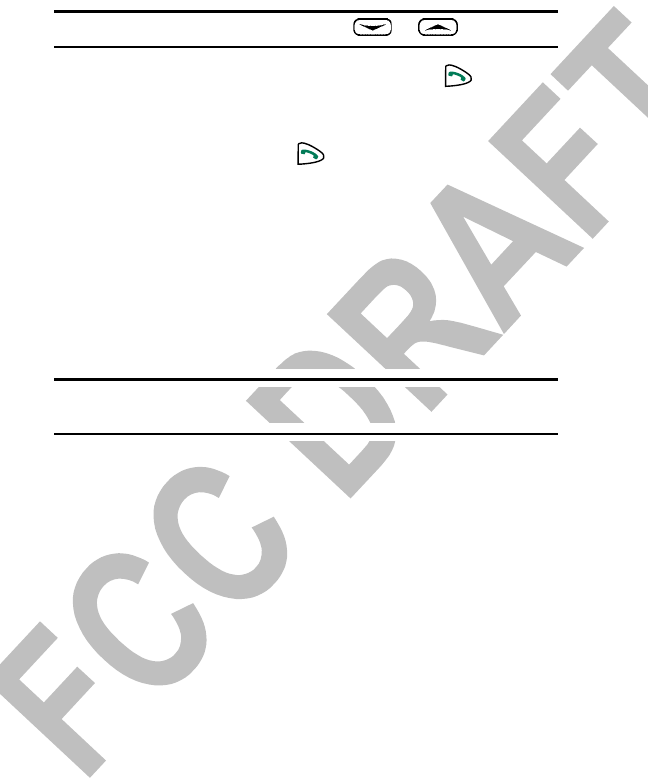
Section 2: Understanding Your PCS Phone
2A: Your PCS Phone - The Basics 23
Dialing From the Internal Phone Book
To dial directly from an Internal Phone Book entry:
1. From the standby mode, press Contacts, scroll to Find, and
press Select.
Shortcut: Press the up or down scroll keys ( or ) to list entries.
2. Scroll to the entry you want to call and press to dial the
entry’s default phone number.
3. To dial another number from the entry, press Details, scroll
to the number and press .
Using One-Touch Dialing
With this feature, you can dial entries using one key press for
locations 1-9.
To use One-Touch Dialing for Speed Dial locations 1-9:
䊳Press and hold the appropriate key for approximately two
seconds. The display confirms that the number has been
dialed when it shows “Calling...”.
Note: One-touch dialing is not available when you are roaming with
Call Guard enabled.

Section 2: Understanding Your PCS Phone
24 2A: Your PCS Phone - The Basics

Section 2: Understanding Your PCS Phone
2B: Controlling Your Phone’s Settings 25
Section 2B
Controlling Your Phone’s Settings
In This Section
䊳Customizing Profiles
䊳Selecting a Profile
䊳Selecting Silent Mode
䊳Adjusting Volume Settings
䊳Adjusting Ringing Tones
䊳Customizing Alert Notifications
䊳Customizing Location Settings
䊳Customizing the Welcome Note
䊳Customizing the Display Banner
䊳Adjusting the Screen Brightness
䊳Using TTY Service
his section describes how you can change your phone’s
settings to best suit your needs. Take a few moments to
review these options and add or adjust the settings that are right
for you.
Your phone has five adjustable profiles, including Normal, Silent,
Meeting, Outdoor, and Pager. Which profile you select and how
you have adjusted each profile will determine the characteristics of
your phone when you are in that particular profile. Note, as well,
that the menu structure and associated options are identical for all
five profiles, with the only exception being that you cannot
rename the Normal profile.
T

Section 2: Understanding Your PCS Phone
2B: Controlling Your Phone’s Settings 26
Customizing Profiles
Your phone has five different profiles. Each profile can be
customized to your specifications. For example, you may wish
to customize your Meeting profile to accommodate your needs
for taking calls during meetings.
To customize your Meeting profile:
1. Press Menu, scroll to Profiles, and press Select.
2. Scroll to Meeting and press Select.
3. Scroll to Customize and press Select.
4. Scroll through each option and make adjustments as
desired.
5. Press Back, then press Exit.
Selecting a Profile
At any given time, you can select one of five phone profiles to
suit your immediate situation.
For example, to set your phone to Meeting profile:
1. Press Menu, scroll to Profiles, and press Select.
2. Scroll to Meeting and press Select, then press Select again.
Until you select a different profile, your phone will remain in
Meeting profile, and your phone’s characteristics will reflect
this profile.
Selecting Silent Mode
There may be times when you need to silence your phone
entirely without turning your phone off. The most efficient way
to do this is to select your Silent profile. You may, however,
modify the settings to your specifications.
To modify and select your Silent profile:
1. Press Menu, scroll to Profiles, and press Select.
2. Scroll to Silent and press Select.
3. Scroll to Customize and press Select.
4. Scroll to Ringing options and press Select.

Section 2: Understanding Your PCS Phone
2B: Controlling Your Phone’s Settings 27
5. Scroll to Silent and press Select.
Tip: You can also activate the vibrating alert, and disable warning, alert,
and keypad tones.
Note: Activating the vibrating alert enables your phone to vibrate when an
incoming call is received (not when the vibrating alert is activated).
Adjusting Volume Settings
To adjust the ringing volume setting:
1. Press Menu.
2. Scroll to Profiles and press Select.
3. Scroll to the profile you wish to modify (Normal is the
default) and press Select.
4. Scroll to Customize and press Select.
5. Scroll to Ringing volume and press Select.
6. Scroll to your preferred level (Level 1–Level 5) and press
Select.
Tip: You can adjust the earpiece volume during a call by using the right/left
scroll keys.
Ringing Tones
Ringing tones help you identify incoming calls and messages.
You can assign ringing tones to individual Internal Phone Book
entries, types of calls, and types of messages.
䊳Pre-programmed ringing tones include a variety of standard
ringing tones and familiar music.
䊳Vibrating alert silently alerts you to calls or messages.
Customizing Ringing Tones
To customize your ringing tones for any of your phone’s
profiles:
1. Press Menu, scroll to Profiles, and press Select.

Section 2: Understanding Your PCS Phone
2B: Controlling Your Phone’s Settings 28
2. Scroll to the profile you wish to modify (Normal, Silent, etc.)
and press Select.
3. Scroll to Customize, and press Select.
4. Scroll to Ringing options and press Select.
5. Scroll to your preferred option and press Select.
6. Scroll to Ringing tone and press Select.
7. Scroll to your preferred tone and press Select.
Selecting Ringing Tones for Messages
To select a ringing tone for messages:
1. Press Menu, scroll to Profiles, and press Select.
2. Scroll to the profile you wish to modify (Normal, Silent, etc.)
and press Select.
3. Scroll to Customize and press Select.
4. Scroll to Message alert tone and press Select.
5. Scroll to the preferred tone or option, and press Select.
Customizing Alert Notifications
To select a ringing alert that allows you to identify the type of
call:
1. Press Menu, scroll to Profiles, and press Select.
2. Scroll to the profile you wish to modify (Normal, Silent, etc.)
and press Select.
3. Scroll to Customize and press Select.
4. Scroll to Alert for and press Select.
5. Scroll to the group(s) you wish to select and press Mark,
then press Done.
To disable alert sounds:
1. Press Menu, scroll to Profiles, and press Select.
1. Scroll to the profile you which to modify (Normal, Silent,
etc.) and press Select.
1. Scroll to Customize and press Select.

Section 2: Understanding Your PCS Phone
2B: Controlling Your Phone’s Settings 29
1. Scroll to Alert for and press Select.
2. Scroll to each category that has been marked and press
Unmark, then press Done.
Note: Selecting the Silent profile does not disable game sounds. Game
sounds must be switched off from the Games’ Settings options.
Location Settings
Your PCS Phone is equipped with a Location feature which will
allow the network to detect your position, making some
PCS Applications easier to use. Turning Location off will hide
your location from everyone except 911.
Note: Even if the Location feature is enabled, no service may use your
location without your expressed permission.
To enable your phone’s Location feature:
1. Press Menu, scroll to Settings, and press Select.
2. Scroll to Call Settings and press Select.
3. Scroll to Location info sharing and press Select.
A message explaining the options of the Location Info Sharing
feature displays on your screen. Press More, or scroll through
the message using the up and down scroll keys, then press OK.
4. Select 911 only or On and press OK.
䊳If you select 911 only, your phone’s location information is
shared with the network only during emergency calls. (911
only is the default profile.)
䊳If you select On, your phone’s location information is shared
with the network whenever the phone is powered On and
activated.
5. When the confirmation message appears, press OK.
When the Location feature is on, you phone’s standby screen
will display the icon. When Location is turned off, the
icon will display.

Section 2: Understanding Your PCS Phone
2B: Controlling Your Phone’s Settings 30
Customizing the Welcome Note
Your new PCS phone offers options for what you see on the
display screen while switching the phone On.
To change your welcome note:
1. Press Menu, scroll to Settings, and press Select.
2. Scroll to Phone Settings and press Select.
3. Scroll to Welcome note and press Select.
4. Enter the welcome note using the alpha keypad (up to 45
characters) and press Options.
5. Scroll to Save and press Select.
Now, each time you switch on your phone, you will
momentarily see your personalized welcome note!
Customizing the Display Banner
The screen banner is displayed on your phone’s Standby screen.
To change your display banner:
1. Press Menu, scroll to Settings, and press Select.
2. Scroll to Phone settings and press Select.
3. Scroll to Display options and press Select.
4. Scroll to Banner and press Select.
5. Scroll to Customize and press Select.
6. Key in your banner message (up to 20 characters) and press
Select.
Now, whenever your phone is in Standby mode, you will see
your personalized banner!
Adjusting the Screen Brightness
To adjust the screen brightness:
1. Press Menu, scroll to Settings, and press Select.
2. Scroll to Phone settings and press Select.
3. Scroll to Display options and press Select.
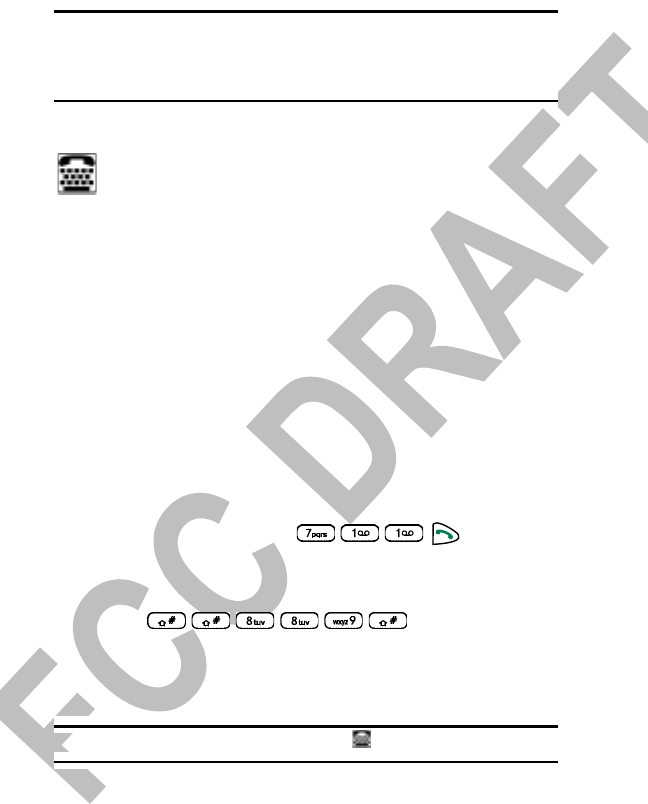
Section 2: Understanding Your PCS Phone
2B: Controlling Your Phone’s Settings 31
4. Scroll to Display brightness and press Select.
5. Adjust the brightness by pressing the left/right scroll keys,
then press OK.
Reminder: To access the phone’s main menu, press the left Contacts from
standby mode. Use the up or down scroll keys to highlight a menu item and
press Select, or you can press the number corresponding to the menu
item on your keypad.
TTY Use With PCS Service From Sprint
A TTY (also known as a TDD or Text Telephone), is a
telecommunications device that allows people who are deaf or
hard of hearing, or who have speech or language disabilities, to
communicate via a telephone.
Your phone is compatible with select TTY devices. Please
check with the manufacturer of your TTY device to ensure that
it supports digital wireless transmission. Your phone and TTY
device will connect via a special cable that plugs into your
phone’s headset jack. If this cable was not provided with your
TTY device, contact your TTY device manufacturer to purchase
the connector cable.
When establishing your PCS Service, please call PCS Customer
Service SolutionsSM via the state Telecommunications Relay
Service (TRS) by first dialing . Then
provide the state TRS with this number: 866-727-4889.
To enable or disable TTY:
1. Press .
2. Follow the system prompt by selecting OK or Exit.
3. Scroll to Yes or No under the TTY menu and press Select.
Note: In TTY Mode, your phone will display .

Section 2: Understanding Your PCS Phone
2B: Controlling Your Phone’s Settings 32
Note: If TTY mode is enabled, the audio quality of non-TTY devices
connected to the headset jack may be impaired.
IMPORTANT NOTICE: 911 Emergency Calling
Sprint recommends that TTY users make emergency calls by other means
including Telecommunications Relay Services (TRS), analog cellular, and
landline communications. Wireless TTY calls to 911 may be corrupted
when received by public safety answering points (PSAPs) rendering some
communications unintelligible. The problem encountered appears related
to TTY equipment or software used by PSAPs. This matter has been
brought to the attention of the FCC, and the wireless industry and PSAP
community are currently working to resolve this.

Section 2: Understanding Your PCS Phone
2C: Setting Your Phone’s Security 33
Section 2C
Setting Your Phone’s Security
In This Section
䊳Accessing the Security Menu
䊳Locking Your Phone
䊳Unlocking Your Phone
䊳Changing the Lock Code
䊳Calling in Locked Mode
䊳Locking and Unlocking Your Keypad
䊳Restricting Calls
䊳Removing Restrictions to Calls
䊳Using Allowed Numbers When Phone is Locked
䊳Restoring Factory Settings
y using the security setting on your PCS Phone, you receive
peace of mind without sacrificing flexibility. With several
options available, you can customize your phone to meet your
personal needs.
B

Section 2: Understanding Your PCS Phone
34 2C: Setting Your Phone’s Security
Accessing the Security Menu
You must enter your lock code to view the Security menu.
To access the Security menu:
1. From the standby mode, press Menu, scroll to Settings, and
press Select.
2. Scroll to Security settings and press Select.
3. Enter your lock code and press OK.
Tip: If you can’t recall your lock code, try using the last four digits of either
your Social Security number or PCS Phone Number or try 0000. If none of
these work, call PCS Customer Service Solutions at 1-888-211-4PCS (4727).
Locking Your Phone
When your phone is locked, you can only receive incoming
calls or make calls to 911, PCS Customer Service Solutions, or
numbers that you have designated.
To lock your phone:
1. From the standby mode, press Menu, scroll to Settings, and
press Select.
2. Scroll to Security settings and press Select.
3. Enter your lock code and press Select.
4. Scroll to Phone lock and press Select.
5. Scroll to your preferred setting (Off, On, On power-up), and
press Select. A brief message confirming your selection is
displayed on the screen.
Unlocking Your Phone
To unlock your phone:
1. From the Security settings menu, scroll to Phone lock and
press Select.
2. Scroll to Off and press Select.

Section 2: Understanding Your PCS Phone
2C: Setting Your Phone’s Security 35
Changing the Lock Code
To change your lock code (which we recommend):
1. From the Security settings menu, scroll to Change lock code
and press Select.
2. Enter your new lock code and press OK. You are asked to
verify your new lock code.
3. Re-enter your new lock code and press OK.
Calling in Lock Mode
You can place calls to 911, PCS Customer Solutions, and to your
special numbers when in lock mode.
To place an outgoing call in lock mode:
䊳To call an emergency number, special number, or
PCS Customer Service Solutions, enter the phone number
and press .
Note: You will not see the number you are dialing until you press the talk
key.
Note: There are no One-touch dialing options associated with special
numbers.
Locking and Unlocking Your Keypad
To prevent pressing keys inadvertently, you can easily lock and
unlock the keypad. This, however, is not a security feature. You
do not need a lock code to lock and unlock your keypad.
To lock and unlock your keypad:
䊳Press .
If the keypad is locked, Unlock appears over the left selection
key.

Section 2: Understanding Your PCS Phone
36 2C: Setting Your Phone’s Security
Restricting Calls
You can restrict which phone numbers you can receive calls
from or dial. (The Restrict Calls setting does not apply to 911 or
PCS Customer Service Solutions.)
To restrict calls:
1. Press Menu, scroll to Settings, and press Select.
2. Scroll to Security settings and press Select.
3. Enter your security code and press OK.
4. Scroll to Call restrictions and press Select.
5. Scroll to Restrict outgoing calls or Restrict incoming calls and
press Select.
6. To restrict all calls, scroll to Select, press Select, press Mark,
press Done, and press Yes to save changes.
7. To restrict particular calls, scroll to Add restriction, press
Select, then either enter the number you wish to restrict or
press Search to scroll through your Internal Phone Book.
8. Press OK.
Note: Restricted incoming calls are forwarded to voicemail.
Removing Call Restrictions
To remove restrictions on all calls:
1. Press Menu, scroll to Settings, and press Select.
2. Scroll to Security settings and press Select.
3. Enter your security code and press OK.
4. Scroll to Call restrictions and press Select.
5. Scroll to Restrict incoming calls and press Select.
6. Scroll to Select, press Select, scroll to All calls, press
Unmark, press Done, and press Yes to save changes.

Section 2: Understanding Your PCS Phone
2C: Setting Your Phone’s Security 37
Using Allowed Numbers When Phone is
Locked
You can assign numbers, either entered manually or from your
Internal Phone Book, that you can call and receive even when
your phone is locked.
To assign a number:
1. Press Menu, scroll to Settings, and press Select.
2. Scroll to Security settings and press Select.
3. Enter your security code and press OK.
4. Scroll to Allowed numbers when phone locked and
press Select.
5. Press Assign, enter the number you wish to allow, and press
OK.
– or –
6. Press Assign, then press Find to access your Internal Phone
Book. Scroll to find the number you wish to allow and press
OK twice.
Erasing the Internal Phone Book
To erase all the names and phone numbers in your Internal
Phone Book:
1. From the standby mode, press Contacts, scroll to Delete, and
press Select.
2. Scroll to Delete all and press Select.
3. Press OK to confirm the deletion of all internal phone book
entries.
4. Enter your lock code and press OK.
Resetting Your Phone
Resetting the phone restores all the factory defaults, including
the ringer types and display settings. The Internal Phone Book
(Contacts), Call Logs, Organizer, and Messaging settings are not
affected.

Section 2: Understanding Your PCS Phone
38 2C: Setting Your Phone’s Security
To restore the factory settings:
1. Press Menu, scroll to Settings, and press Select.
2. Scroll to Restore factory settings and press Select.
3. Enter your security code and press OK.

Section 2: Understanding Your PCS Phone
2C: Setting Your Phone’s Security 39

Section 2: Understanding Your PCS Phone
40 2C: Setting Your Phone’s Security

Section 2: Understanding Your PCS Phone
2D: Controlling Your Roaming Experience 41
Section 2D
Controlling Your Roaming
Experience
In This Section
䊳Understanding Roaming
䊳Setting Your Phone’s Roam Mode
䊳Controlling Roaming Charges Using Call Guard
oaming is the ability to make or receive calls while you’re off
the enhanced Sprint Nationwide PCS Network. Your new
dual-band PCS Phone works anywhere on the enhanced Sprint
Nationwide PCS Network and allows you to roam virtually
anywhere in the U.S. where compatible wireless service is
available.
This section explains how roaming works as well as special
features that let you manage your roaming experience.
R

Section 2: Understanding Your PCS Phone
42 2D: Controlling Your Roaming Experience
Understanding Roaming
Recognizing Icons on the Display Screen
The roaming indicator ( ) on your display screen lets you
know when you’re off the enhanced Sprint Nationwide PCS
Network. You can set your roaming mode to Sprint only or
automatic, which then allows your phone to automatically select
the roaming mode when Sprint service is not available.
Tip: Remember, when you are using your phone off the Sprint Nationwide
PCS Network, always dial numbers using 11 digits (1 + area code + number).
Note: You will pay a higher per-minute rate for roaming calls.
Roaming on Other Digital Networks
When you’re roaming on digital networks, your call quality and
security will be similar to the quality you receive when making
calls on the enhanced Sprint Nationwide PCS Network.
Note: If you’re on a call when you leave the Sprint Nationwide PCS
Network and enter an area where roaming is available, your call is
dropped. If your call is dropped in an area where you think PCS Service is
available, turn your phone off and on again to reconnect to the Sprint
Nationwide PCS Network.

Section 2: Understanding Your PCS Phone
2D: Controlling Your Roaming Experience 43
Setting Your Phone’s Roam Mode
Your PCS Phone allows you to control your ability to roam.
By using the Roaming menu option, you determine which
signals your phone accepts.
Set Mode
Choose from two different settings on your dual-band phone to
control your roaming experience:
1. Press Menu, scroll to Settings, and press Select.
2. Scroll to Roaming and press Select.
3. Scroll to Set Mode and press Select.
4. Scroll to your preferred mode and press Select.
䊳Sprint: This setting allows you to access the enhanced Sprint
Nationwide PCS Network only and prevents roaming on
other networks.
䊳Automatic: This setting seeks PCS Service. When PCS Service
is unavailable, the phone searches for an alternate system.
Controlling Roaming Charges Using
Call Guard
In addition to the roaming icon, Call Guard alerts you when
roaming charges apply. This feature makes it easy to manage
your roaming charges by reminding you when you make or
receive roaming calls. It also requires you to take an additional
step before placing or answering a roaming call. This additional
step is not required when you make or receive calls while on
the enhanced Sprint Nationwide PCS Network.
To Turn Call Guard On or Off:
1. Press Menu, scroll to Settings, and press Select.
2. Scroll to Roaming and press Select.
3. Scroll to Call Guard and press Select.
4. Scroll to On or Off and press Select.

Section 2: Understanding Your PCS Phone
44 2D: Controlling Your Roaming Experience
Note: Voice Dialing and 1-touch Dialing are not available when you are
roaming with Call Guard enabled.
To Place Roaming Calls With Call Guard On:
1. Press Menu, scroll to Settings, and press Select.
2. Scroll to Roaming and press Select.
3. Scroll to Set mode and press Select.
4. Highlight Automatic and press Select. A message asking you
to confirm your choice will appear on the display screen.
5. Press OK to activate the mode you have chosen. Now, if you
make calls outside the Sprint service area, your phone will
automatically roam to a nearest service provider.
To Answer Incoming Roaming Calls With Call Guard On:
䊳Press Menu, scroll to Answer, and press Select.

Section 2: Understanding Your PCS Phone
2E: Navigating Through Menus 45
Section 2E
Navigating Through Menus
In This Section
䊳Menu Navigation
䊳Menu Structure
䊳Viewing Menus
his section is a road map to using your PCS Phone. Every
function and feature can be accessed through a menu. Take a
few moments to learn your way around. You’ll find that it makes
your phone easier to use.
T

Section 2: Understanding Your PCS Phone
46 2E: Navigating Through Menus
Menu Navigation
The navigation keys on your PCS Phone allows you to scroll
through menus quickly and easily. The scroll bar at the right of
the menu keeps track of your position in the menu at all times.
To navigate through a menu, simply press the navigation key up
or down.
Menu Structure
Selecting Menu Items
As you navigate through the menu, menu options are
highlighted. Select an option by scrolling to it and pressing
Select.
For example, if you want to view your last incoming call:
1. From the standby mode, press Menu, scroll to Call logs and
press Select.
2. Scroll to Incoming Calls and press Select. Received calls are
displayed on the screen in the order they were received,
with the most recent being at the top of the list.
Backing Up Within a Menu
To go to previous screens already displayed:
䊳Press Back.
To return to standby mode:
䊳Press Exit or .
Reviewing the Main Menu
Menu Main Diagram
Menus let you view or change your phone settings. The
following outline shows your phone’s complete menu
structure:

Section 2: Understanding Your PCS Phone
2E: Navigating Through Menus 47
Call logs
Messaging
Organizer
Profiles
Settings
Phone details
Games
Keyguard

Section 2: Understanding Your PCS Phone
48 2E: Navigating Through Menus
Viewing the Menus
Menu Diagram
The following list outlines your phone’s main menus and their
associated sub-menus:
1. Call logs
1. Outgoing Calls
2. Incoming Calls
3. Missed Calls
4. Delete call logs
1. All
2. Missed
3. Incoming
4. Outgoing
2. Messaging
1. Notifications
2. Voicemail
3. Speed Dials
4. Groups
5. Voice Dials
6. Services 1. PCS Customer Solutions/2. Directory/
3. Account Info.
3. Messaging
1. Notifications
1. Inbox
1. Delete
2. Save message
3. Use number
4. Save address
5. Forward
6. Rename
2. Voicemail
4. Web
1. Launch
5. Downloads
Games Get New/[downloaded games]
Ringers Get New/[downloaded ringers]
Screen Get New/[downloaded screen savers]
Applications Get New/[downloaded applications]
Other Get New/[downloaded items]
6. Voicemail
7. Fun Tools
1. Photo Album
2. Games 1. Egg Stack/2. Real Fighters
3. EZ Tips

Section 2: Understanding Your PCS Phone
2E: Navigating Through Menus 49
4. Calculator
5. World Clock
8. Settings
1. Sounds
1. Ringers
1. Voice Calls 1. Caller ID/2. No Caller ID/3. Roaming
2, Messages 1. Voicemail/2. Page/Text
2. Key Tones
3. Volume
1. Ringer
2. Earpiece
3. Key Beep
4. Alerts
Service Change On/Off
Minute Beep On/Off
Call Connect On/Off
2. Display
1. Greeting
2. Backlight
3. Screens 1. Wallpaper/2. Power On/3. Power Off
4. Contrast
5. Menu Style
6. Theme Color
7. Clock 1. Normal/2. Analog/3. Digital
8. Text Input Font 1. Size/2. Color
3. Internet
1. Sign In (Out)
2. Password Prompt
3. Net Guard
4. Roaming
1. Set Mode
2. Call Guard
5. Location
6. Messaging
7. SecurityEnter Lock Code
1. Lock Phone
2. Change Lock
3. Special #
4. Erase Phone Book
5. Reset Default
8. Airplane Mode
9. Setup
1. Shortcut
2. Call Answer Open/Any Key/Talk Only
3. Auto-Answer Off / Car Kit
4. Data-In 1. Connection/2. Method/3. Speed
5. Msg Auto EraseOn/Off
6. Language English/Spanish
0. Voice Dial
1. Voice Dial Prompt

Section 2: Understanding Your PCS Phone
50 2E: Navigating Through Menus
2. Screen Calls
3. Train Words 1. Yes/2. No
9. Phone Info
0. Organizer
1. Schedule
2. Alarm Clock 1. Alarm 1/2. Alarm 2/3. Alarm 3/4. Quick Alarm
3. Notepad
4. Voice memo
Reviewing the Contacts Menu
Internal Phone Book Menu Diagram
The Contacts menu contains your Internal Phone Book entries,
and lets you add, delete, and customize entries according to
your personal preferences. The following outline shows your
phone’s complete Internal Phone Book menu structure:
Search
Add new
Edit name
Delete
Add number
Options
1-touch dialing
Voice tags
My phone no.
Caller groups

Section 2: Understanding Your PCS Phone
2F: Managing Call History 51
Section 2F
Managing Call Logs
In This Section
䊳Viewing Call Logs
䊳Call Logs Options
䊳Making a Call
䊳Viewing the Duration of a Call
䊳Viewing a Phone Number
䊳Using a Phone Number
䊳Saving a Phone Number
䊳Adding a Phone Number to a Contact Entry
䊳Deleting a Phone Number
he Call Logs keep track of incoming calls, calls made from
your PCS Phone, and missed calls. This section guides you
through accessing and making the most of your Call Logs.
T

Section 2: Understanding Your PCS Phone
52 2F: Managing Call History
Viewing Call Logs
You’ll find the Call Logs feature very helpful. It is a list of the
last 20 phone numbers (or Internal Phone Book entries) for
calls you placed, accepted, or missed. Call Logs makes redialing
a number fast and easy. It is continually updated as new
numbers are added to the beginning of the list and the oldest
entries are removed from the bottom of the list.
Each entry contains the phone number (if it is available) and
Internal Phone Book entry name (if the phone number is in
your Internal Phone Book). Duplicate calls (same number and
type of call) may only appear once on the list.
To view a Call Logs entry:
1. From standby mode, press Menu, scroll to Call logs and press
Select.
2. Scroll to Outgoing calls, Incoming calls, Missed calls, or
Delete call logs and press Select.
Depending on the calls made and received, numbers will be
listed in chronological order.
Call Logs Options
For additional information and options on a particular call,
scroll to an entry and press Options. Scroll to one of the
following options and press Select:
䊳Call time
䊳View number
䊳Use number
䊳Save
䊳Add to contact
䊳Delete
䊳Call
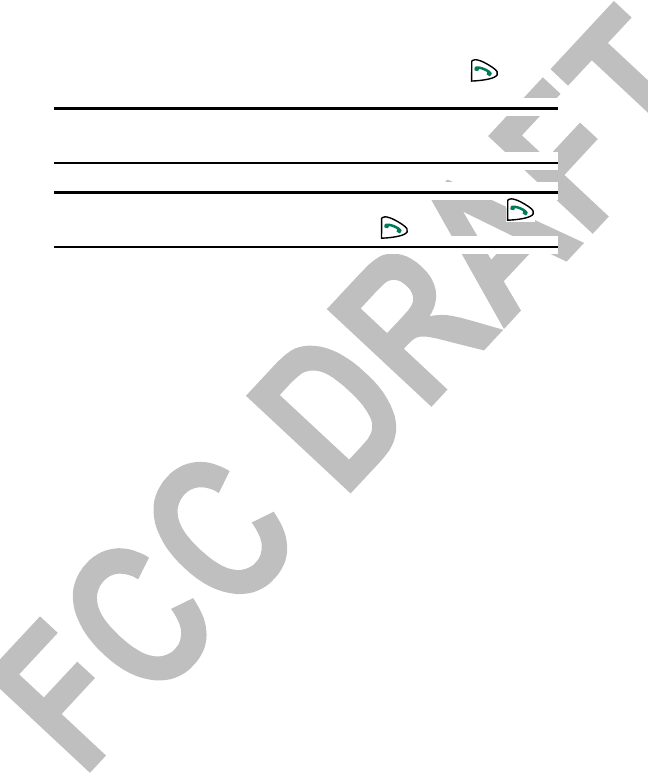
Section 2: Understanding Your PCS Phone
2F: Managing Call History 53
Making a Call
To place a call from Call Logs:
1. From the standby mode, press Menu, scroll to Call logs, and
press Select.
2. Scroll to the category you wish to view (for example,
Missed calls) and press Select.
3. Scroll to the number you wish to call and press .
Note: You cannot make calls from Call History to entries identified as
No ID or Restricted.
Tip: You can view your list of recently dialed numbers by pressing .
Scroll to the number you wish to dial and press again.
Viewing the Duration of a Call
To view the approximate time of a call:
1. Press Menu, scroll to Call logs, and press Select.
2. Scroll to the category you wish to view (for example,
Outgoing calls) and press Select.
3. Scroll to the number you wish to view and press Select.
4. Scroll to Call time and press Select.
Viewing a Phone Number
To view a phone number from the Call logs menu:
1. Press Menu, scroll to Call logs, and press Select.
2. Scroll to the category you wish to view (for example,
Outgoing calls) and press Select.
3. Scroll to the number you wish to view and press Select.
4. Scroll to View number and press Select.
Using a Phone Number
To use a phone number from the Call logs menu:

Section 2: Understanding Your PCS Phone
54 2F: Managing Call History
1. Press Menu, scroll to Call logs, and press Select.
2. Scroll to the category you wish to view (for example,
Outgoing calls) and press Select.
3. Scroll to the number you wish to use and press Options.
4. Scroll to Use number and press Select.
5. Press Options, scroll to the option you prefer (Save, Add to
contact, or Call), then press OK.
Saving a Phone Number
Your PCS Phone can store up to 500 Internal Phone Book
entries. Phone Book entries can store up to a total of 5 phone
numbers and each entry’s name can contain twenty characters.
To save a phone number from Call Logs:
1. Press Menu, scroll to Call logs, and press Select.
2. Scroll to the category you wish to view (for example,
Outgoing calls) and press Select.
3. Scroll to the number you wish to save and press Options.
4. Scroll to Save and press Select.
5. Scroll to the contact you wish to assign to this number to
and press OK.
After you have saved the number, the new Internal Phone Book
entry is displayed. (See “Internal Phone Book Entry Options” on
page xx.)
Note: Record Voice Dial tags in a quiet environment and without the aid of
an accessory (for example, a headset or Hands-Free Car Kit).
Note: You cannot save phone numbers already in your Internal Phone
Book or from calls identified as No ID or Restricted.
Adding a Phone Number to a Contact Entry
To add a phone number to a pre-existing contact:
1. Press Menu, scroll to Call logs, and press Select.

Section 2: Understanding Your PCS Phone
2F: Managing Call History 55
2. Scroll to the category you wish to use (for example, Outgoing
calls) and press Select.
3. Scroll to the number you want to add and press Options.
4. Scroll to Add to contact and press Select.
5. Scroll to the name you wish to append and press Add.
6. Scroll to the category to which you wish to add the number
and press Select.
Deleting a Phone Number
To erase individual Call log entries, see "Call Logs Options" on
page 52.
To delete all phone numbers stored in Call logs:
1. Press Menu, scroll to Call logs, and press Select.
2. Scroll to Delete call logs and press Select.
3. Scroll to the option you prefer (All, Missed, Incoming, or
Outgoing) and press Select.
Note: This action cannot be undone.

Section 2: Understanding Your PCS Phone
56 2F: Managing Call History

Section 2: Understanding Your PCS Phone
2G: Using the Internal Phone Book 57
Section 2G
Using the Internal Phone Book
In This Section
䊳Internal Phone Book Entry Options
䊳Selecting a Character Input Mode
䊳Adding a New Contact
䊳Finding Contacts
䊳Adding a Phone Number to an Existing Contact
䊳Editing a Phone Number of an Existing Contact
䊳Editing the Name of an Existing Contact
䊳Selecting a Ringing Tone for a Contact
䊳Dialing PCS Services
䊳Deleting Contacts
ow you know the basics that make it easier to stay in touch
with people and information. This section helps you make
the most of your contacts and time when you are trying to
connect with the important people in your life.
N

Section 2: Understanding Your PCS Phone
58 2G: Using the Internal Phone Book
Internal Phone Book Entry Options
When you press Contacts from standby mode, the following
options are displayed:
䊳Search lets your search for an existing entry.
䊳Add new lets you add a new entry.
䊳Edit name lets you edit an existing entry.
䊳Delete lets you delete an existing entry.
䊳Add number lets you add a number to an existing entry.
䊳Options lets you adjust how you wish to view your entries,
and lets you see how much memory you have available.
䊳1-touch dialing lets you assign 1-touch speed dialing to an
entry.
䊳Voice tags lets you view which entries have been assigned a
voice tag for voice calling.
䊳My phone no. lets you view your own phone’s number.
䊳Caller groups lets you view the names of groups that you
have assigned to entries.
Selecting a Character Input Mode
Your PCS Phone provides convenient ways to enter words,
letters, punctuation, and numbers whenever you are prompted
to enter text (for example, when adding contacts).
Entering Characters by Tapping the Keypad
To enter characters by tapping the keypad, select the Abc mode
(see “Selecting a Character Input Mode” on page xx). Press the
corresponding key until the desired character appears. By
default, the first letter of a word is capitalized and following
letters are lowercase.
Characters scroll in the following order:
䊳 . , ‘ ? ! - 1
䊳 A B C 2
䊳 D E F 3
䊳 G H I 4
䊳 J K L 5
䊳 MNO 6
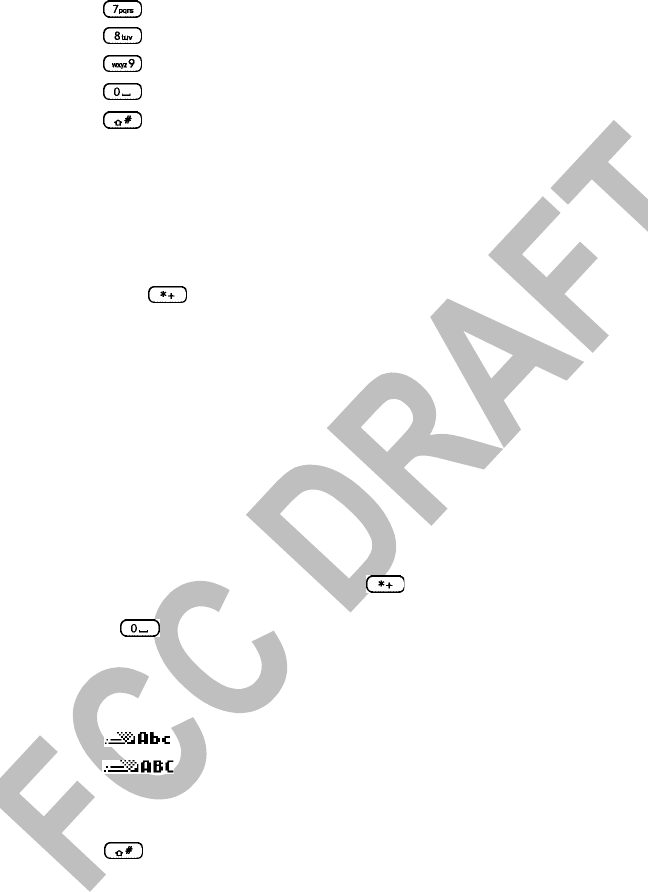
Section 2: Understanding Your PCS Phone
2G: Using the Internal Phone Book 59
䊳 P Q R S 7
䊳 T U V 8
䊳 WXY Z 9
䊳 Space 0
䊳 Shift
After a character is entered, the cursor automatically advances
to the next space after two seconds or when you enter a
character not on the same key.
Entering Symbols and Numbers
To enter symbols:
1. Press .
2. Using the up and down scroll keys, highlight a symbol and
press Insert.
To enter numbers, press and hold the desired number key for 2
seconds to enter the number.
Entering Characters Using T9 Text Input
T9 Text Input lets you enter text in your PCS Phone by pressing
keys just once per letter.
T9 Text Input analyzes the letters you enter using an intuitive
word database and creates a suitable word. (The word may
change as you type.) If the word you want does not display after
you have entered all the letters, press to scroll through
additional word selections. To accept a word and insert a space,
press .
If you make a mistake, press Clear to erase a single character.
Press and hold Clear to delete an entire entry.
䊳Abc to enter characters in title-case mode
䊳 to enter characters in the title-case mode.
䊳 to enter characters in the uppercase mode.
To change the character input mode:
䊳When you display a screen where you can enter text, press
to alternate between title-case and uppercase mode.

Section 2: Understanding Your PCS Phone
60 2G: Using the Internal Phone Book
Adding a Word to the T9 Database
If a word you want to enter does not display as an option when
you are using T9 Text Input, you can add it to the database.
To add a word to the T9 Text Input database:
1. Select the Abc character input mode. ("Selecting a Character
Input Mode" on page 58.)
2. Enter the word using multi-tap text entry. ("Selecting a
Character Input Mode" on page 58.) The word will appear
as an option the next time you scroll through options
during T9 Text Input.
For more information about T9 Text Input, visit the Tegic Web
site at www.T9.com.
Adding a New Contact
Your PCS Phone can store up to 500 contact entries with up to
five phone numbers each.
To add a new contact:
1. Press Contacts, scroll to Add new, and press Select.
2. Enter the name of the new entry and press OK.
3. Enter the number of the new entry, press OK, then, either
press Options to modify this entry, or press Done.
Finding Contacts
There are several ways to display your Internal Phone Book
entries. Follow the steps outlined in the sections below to
display entries from the Contacts menu.
Finding Names
To find an existing entry:
1. Press Contacts, scroll to Search, and press Select.
2. Enter the first letter(s) or the entire name of the entry you
seek and press Search.
– or –
Scroll up or down to find the entry you seek.

Section 2: Understanding Your PCS Phone
2G: Using the Internal Phone Book 61
Shortcut: From the main menu, press the up or down navigation key to
display your list of contacts.
Note: Pressing the key that corresponds to the first letter of the desired
entry brings you to that alphabetical spot in the list of entries. For example,
pressing four times displays the Internal Phone Book entry beginning
with the letter “S.”
Finding Speed Dial Numbers
To find phone numbers you have stored in speed dial locations:
1. Press Contacts, scroll to 1-touch dialing, and press Select.
2. Scroll up or down to view contacts.
Finding Voice Dial Numbers
To find phone numbers you have stored in Voice Dial:
1. Press Contacts, scroll to Voice tags, and press Select.
2. Scroll to the number you wish to view and press Select.
Note: Record Voice Dial tags in a quiet environment and without the aid of
an accessory (for example, a headset or Hands-Free Car Kit).
After you have saved the number, the new Internal Phone Book
entry is displayed. (See "Internal Phone Book Entry Options" on
page 58.)
Adding a Phone Number to a Contact
To add a phone number to an entry:
1. Press Contacts, scroll to Add number, and press Select.
2. Scroll to the name you wish to modify and press Add.
3. Scroll to the category to which you wish to add a number
and press Select.
4. Enter the number and press OK.
5. Press Options to view options for further modifying this
entry, or press Done.

Section 2: Understanding Your PCS Phone
62 2G: Using the Internal Phone Book
Editing the Phone Number of an Existing
Contact
To edit a phone number:
1. Press the down scroll key to view your Internal Phone Book
entries, scroll to the entry you wish to modify, and press
Details.
2. Scroll to the number you wish to modify and press Options.
3. Scroll to Edit number and press Select.
4. Press Clear to delete digits, or press and hold Clear to
completely delete the number.
5. Enter the new number and press OK.
Editing the Name of an Existing Contact
To edit the name of an entry:
1. Press the down scroll key to view your Internal Phone Book
list
2. Scroll to the name you wish to edit and press Details.
3. Press Options, scroll to Edit name, and press Select.
4. Press Clear to delete letters, or press and hold Clear to
completely delete the name.
5. Enter the new name and press OK.
Selecting a Ringing Tone for a Contact
You can assign a ringer type to an Internal Phone Book entry so
you can identify the caller by the ringer type. (See “Ringer
Types” on page xx.)
To assign a ringing tone to an entry:
1. Display an Internal Phone Book entry, then press Details.
2. Press Options, scroll to Custom tone, and press Select.
3. Scroll to the tone you prefer, and press Select, then press
to return to the standby mode.
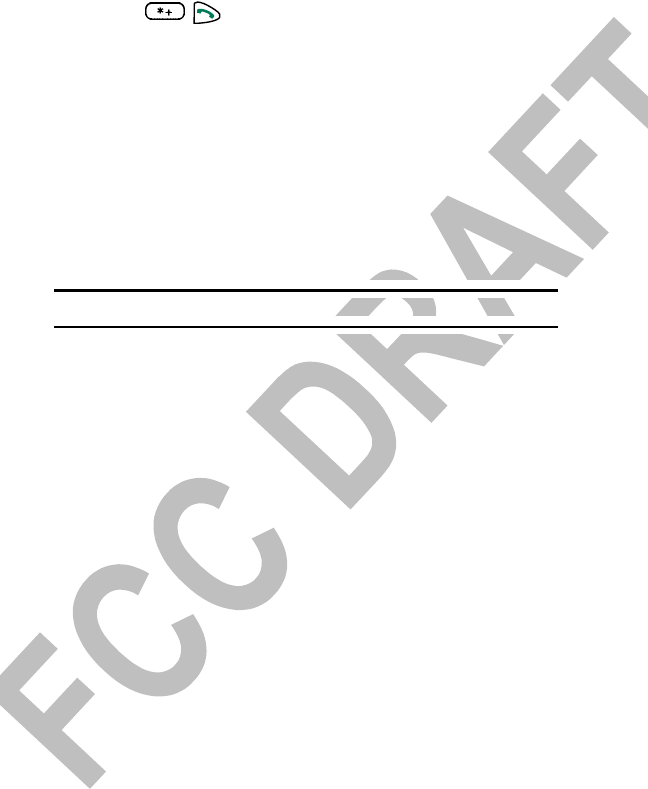
Section 2: Understanding Your PCS Phone
2G: Using the Internal Phone Book 63
Dialing PCS Services
You must be in digital mode to access PCS Services.
To dial a service:
1. Press .
Deleting Contacts
There may be a need for you to completely delete your entire
Contacts List. To do so:
1. Press Contacts, scroll to Delete, and press Select.
2. Scroll to Delete all, and press Select. A message will appear
on your display screen asking if you are sure you wish to
delete your Phone Book. If you are sure, press OK.
3. Enter your lock code and press OK.
Note: This action cannot be undone.

Section 2: Understanding Your PCS Phone
64 2G: Using the Internal Phone Book

Section 2: Understanding Your PCS Phone
2H: Personal Organizer 65
Section 2H
Personal Organizer and Tools
In This Section
䊳Adding an Event to Your Calendar
䊳Receiving Event Alerts
䊳Viewing Events and Event Options
䊳Deleting an Event
䊳Viewing Today’s Calendar Menu
䊳Using the Alarm Clock
䊳Playing Games
䊳Using the Calculator
䊳Using the Currency Converter
䊳Using the To-do List
䊳Using the Stopwatch
our PCS Phone is equipped with several personal information
management features that help you manage your busy
lifestyle. These features turn your phone into a time management
planner that helps you keep up with your contacts, schedules,
and commitments. It takes productivity to a whole new level.
Y
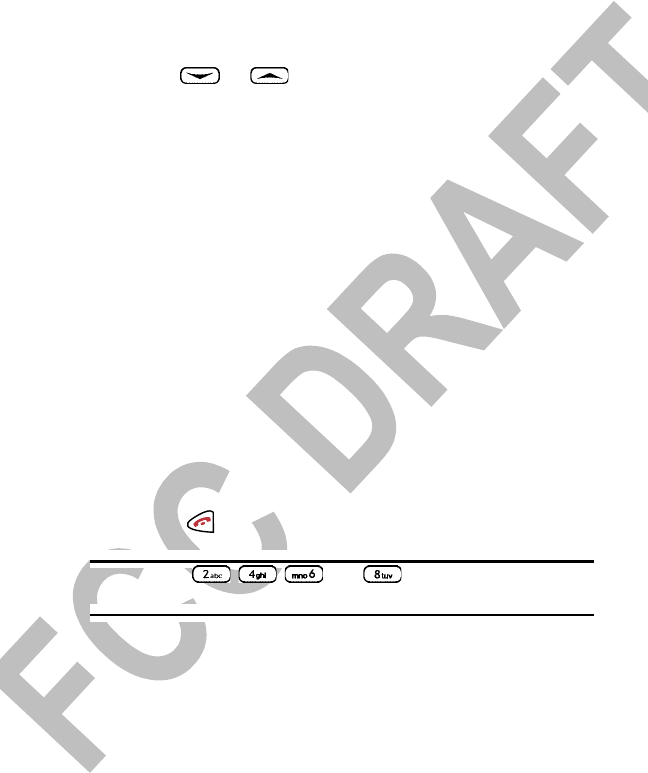
Section 2: Understanding Your PCS Phone
66 2H: Personal Organizer
Adding an Event to Your Calendar
Your Calendar helps organize your time and allows you to set
an alarm to remind you of important events.
To add an event:
1. Press Menu, scroll to Organizer, and press Select.
2. Scroll to Calendar and press Select.
3. Press or to highlight the date in which you wish
to schedule an event and press Options.
4. Scroll to Make a note and press Select.
5. Scroll to Meeting, Call, Birthday, Memo or Reminder, and press
Select.
6. Enter your memo or reminder note, press Options, then
press OK.
Depending on the type of event you selected, the Alarm type
menu may be displayed.
To set an alarm for the event:
7. Scroll to the type of alarm notification you wish to assign to
this note and press Select.
8. Scroll through the Alarm menu, highlight the option for
when you want to be notified, and press Select.
9. Use the keypad to designate a notification time and press
OK.
10. Press to return to the Standby mode.
Tip: Press the and keys to scroll up, down,
right, or left within the calendar.
Receiving Event Alerts
There are several ways your PCS Phone alerts you of scheduled
events:
䊳By playing an alert tone.
䊳By illuminating the backlight.
䊳By flashing a message on your phone’s display screen.

Section 2: Understanding Your PCS Phone
2H: Personal Organizer 67
Event Alert Options
Whether your phone is turned on or off, if you have an event
alarm scheduled, your phone alerts you and displays the left or
right selection keys. Choose one of the following options:
䊳Press View to display the event’s time, date, description,
alarm, and repeating status.
䊳Press Exit to clear the alarm and return to the standby mode.
Viewing Events and Event Options
To view your scheduled events:
1. From the Organizer menu, scroll to Calendar, and press
Select.
2. Scroll to the day you wish to view and press Options.
3. Scroll to View day and press Select.
4. Press Options to modify this note or to return to the
standby mode.
Deleting an Event
To delete an event:
1. From the Organizer menu, scroll to Calendar, and press
Select.
2. Scroll to the day you wish to edit and press Options.
3. Scroll to View day and press Select.
4. Select the event you wish to delete and press Options.
5. Scroll to Delete and press Select. A message asking you if you
want to delete this note will appear on your display screen.
6. Press OK.
Deleting Events Automatically
To delete events scheduled before a specific time and date:
1. From the Calendar menu, press Options.
2. Select View day, highlight the note you wish to delete, then
press Options.

Section 2: Understanding Your PCS Phone
68 2H: Personal Organizer
3. Scroll to Settings and press Select.
4. Scroll to Auto-delete and press Select.
5. Scroll to the option you prefer and press Select.
Viewing Today’s Calendar Menu
When you view the Calendar, today’s date is automatically
highlighted. To view Calendar events for today:
1. From the Organizer menu, scroll to Calendar, and press
Select.
2. Press Options, scroll to View day, and press Select.
Using Your Phone’s Tools
In addition to features designed to help make you more
efficient and organized, your new PCS Phone also offers tools
for your entertainment and amusement.
Playing Games
To play a game on your PCS Phone:
1. Press Menu, scroll to Games, and press Select.
2. Scroll to Select game and press Select.
3. Scroll to your preferred game and press Select.
4. Scroll to Instructions (if this is your first time playing this
game) and press Select.
5. Press More to scroll through your instructions, and press
Back to review a previous screen.
From this point, you can begin a new game, change game
settings (tones), and review high scores to previous games you
have played.
Using the Alarm Clock
Your phone comes with a built-in alarm clock with multiple
alarm capabilities.
To set an alarm, follow these easy steps:
1. From the standby mode, press Menu, scroll to Organizer and
press Select.
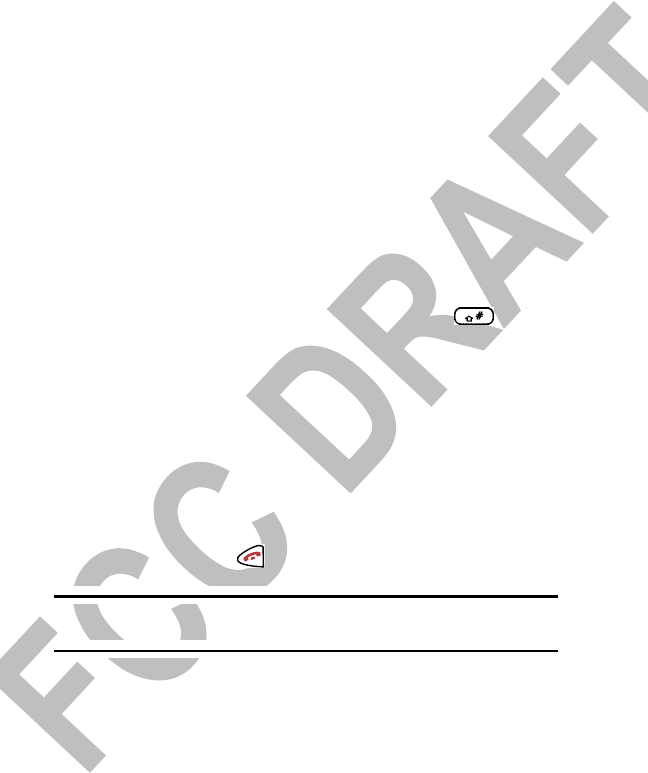
Section 2: Understanding Your PCS Phone
2H: Personal Organizer 69
2. Scroll to Alarm clock and press Select.
3. Enter a time for the alarm (in mm:hh format) and press OK.
4. Scroll to am or pm and press Select.
At the alarm time, the phone lights up, sounds an alert tone,
and displays an animated message.
Press Stop (to turn the alarm off) or Snooze (the alarm will
sound again in 10 minutes).
Using the Calculator
Your phone comes with a built-in calculator function. You can
use the calculator to add, subtract, multiply, divide, square, find
the square root, and convert currency.
To use the calculator, follow these easy steps:
1. From the standby mode, press Menu, scroll to Organizer, and
press Select.
2. Scroll to Calculator and press Select.
3. Enter the first number in the calculation (press for a
decimal point).
4. Press Options, scroll to Add, Subtract, Multiply, Divide, Square,
Square root, or Change sign (to a negative or positive) and press
Select.
5. Enter the second number in the calculation.
6. Press Options, scroll to Equals, and press Select. The total is
displayed.
5. To start a new calculation, press and hold Clear for two
seconds or press to return to standby mode.
Note: This calculator has a limited accuracy and rounding errors may
occur, especially in long divisions.
Using the Currency Converter
To convert currency using the calculator in your phone:
1. From the standby mode, press Menu, scroll to Organizer, and
press Select.
2. Scroll to Calculator and press Select.

Section 2: Understanding Your PCS Phone
70 2H: Personal Organizer
3. Press Options, scroll to Exchange rate, and press Select.
4. Scroll to Foreign units converted to home units or Home units
converted to foreign units and press Select.
5. Enter the exchange rate for the selected set of units and
press OK.
6. Enter the number (currency) you wish to convert (press
for a decimal point) and press Options.
7. Scroll to To home or To foreign and press Select. The currency
is converted according to the saved exchange rate.
Using the To-do List
You can use the to-do list to save a list of tasks in your phone to
recall for later use.
1. From the standby mode, press Menu, scroll to Organizer, and
press Select.
2. Scroll to To-do list and press Select.
3. Press Options, scroll to Add, and press Select.
4. Enter a subject for your task, press Options, scroll to Save,
and press Select.
5. Select High (1), Medium (2), or Low (3) as the priority level and
press Select.
Using the Stopwatch
You can use the Stopwatch in your phone to time an event in
hours, minutes, and seconds. The event time can be saved,
viewed, or deleted.
1. From the standby mode, press Menu, scroll to Organizer, and
press Select.
2. Scroll to Stopwatch and press Select.
3. Scroll to Split timing or Lap timing and press Select.
䊳Split timing allows you to measure the total time for an
event, yet capture the elapsed time at various intervals.
Press Split to display the split time while the timer
continues to display lapsed time or Stop to stop the timer
and view th total elapsed time.

Section 2: Understanding Your PCS Phone
2H: Personal Organizer 71
䊳Lap timing allows you to measure the amount of time it takes
to complete a cycle or lap. Press Stop to stop the timer and
view the elapsed time or Lap to display the lap time (the
timer restarts from zero).

Section 2: Understanding Your PCS Phone
72 2H: Personal Organizer

Section 2: Understanding Your PCS Phone
2I: Using Your Phone’s Voice Services 73
Section 2I
Using Your Phone’s
Voice Services
In This Section
䊳Using Voice-Activated Dialing
䊳Assigning a Voice Tag to a Phone Number
䊳Making a Call Using a Voice Command
䊳Changing a Voice Tag
䊳Deleting a Voice Tag
䊳Voice Memos
䊳Recording a Voice Memo
䊳Playing a Voice Memo
䊳Deleting a Recorded Voice Memo
his section explains the features associated with your phone’s
Voice Services. The easy-to-follow instructions explain how
to use voice-activated dialing and how to record and manage
voice memos.
T
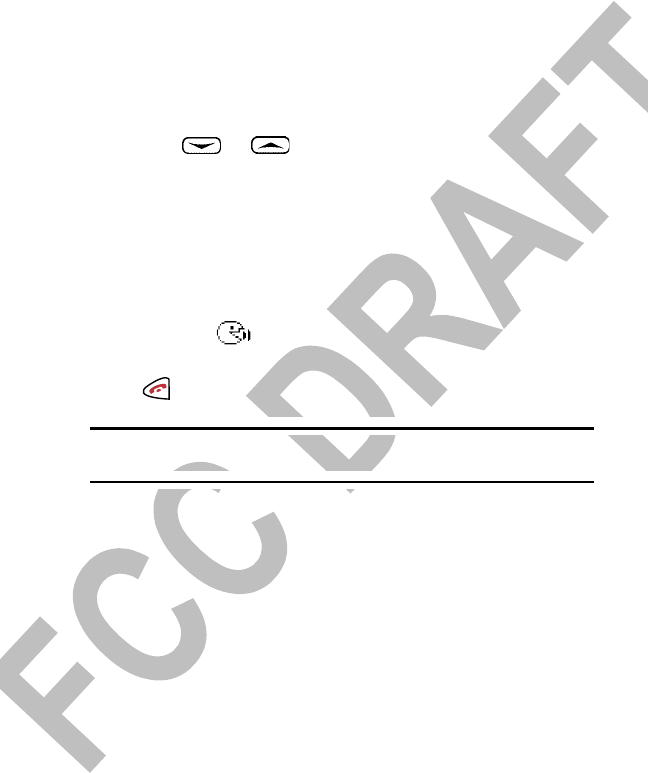
Section 2: Understanding Your PCS Phone
74 2I: Using Your Phone’s Voice Services
Using Voice-Activated Dialing
In addition to PCS Voice CommandSM (see page xx), you can use
a Voice tag to automatically dial a phone number in your
Internal Phone Book. Your phone can store up to [xx] Voice
tags.
To use voice-activated dialing, you must first assign a voice tag
to the number you wish to call.
Assigning a Voice Tag to a Phone Number
To assign a voice tag to a phone number:
1. Press or to display your current list of Contacts.
2. Scroll to the entry to which you wish to assign a voice tag
and press Details. The number associated to this entry is
displayed.
3. Press Options, scroll to Add voice tag, and press Select.
4. Press Start, then speak the command clearly as though you
were speaking normally into the phone. The voice tag
indicator ( ) is displayed on your screen.
5. Press Options to assign other features to this entry, or press
to return to the standby mode.
Note: Record voice tags in a quiet environment and without the aid of an
accessory (for example, a headset or hands-free car kit).
Making a Call Using a Voice Command
To use a Voice tag to call a phone number:
1. From standby mode, press and hold Contacts for two
seconds.
2. After the tone is heard and Please speak now is displayed,
clearly speak the voice tag that you previously recorded.
Once the voice tag is recognized, the phone book entry is
displayed on the screen and the voice tag is played through the
earpiece. After three seconds, the number is automatically
dialed.

Section 2: Understanding Your PCS Phone
2I: Using Your Phone’s Voice Services 75
Warning: Never attempt to use voice-activated dialing to place
emergency (911) calls. During an emergency, the tone of your voice may
be affected and unrecognizable by your phone.
Changing a Voice Tag
To change the voice tag of a contact:
1. Press Contacts, scroll to Voice tags, and press Select.
2. Scroll to an existing entry and press Options.
3. Scroll to Change and press Select.
4. Press Start and speak into the microphone.
Note: When you are finished speaking your voice tag, do not press Quit or
your message will be deleted.
Deleting a Voice Tag
To delete a voice tag:
1. Press Contacts, scroll to Voice tags, and press Select.
2. Scroll to an existing entry and press Options.
3. Scroll to Delete and press Select.
4. Press OK to confirm your choice.
Recording Voice Memos
You can use the voice recorder to record audio memos and
store them in your phone.
Recording a Memo
1. From the standby mode, press Menu, scroll to Organizer, and
press Select.
2. Scroll to Voice recorder and press Select.
3. Scroll to Record and press Select.
After a tone, the phone begins recording.
4. When you are finished recording, press Stop.

76
5. Enter a title for the voice recording and press OK.
Note: Your phone can store a total of 60 seconds of memos.
Voice Memo Options
To play the voice memos you have recorded:
1. From the standby mode, press Menu, scroll to Organizer, and
press Select.
2. Scroll to Voice recorder and press Select.
3. Scroll to Recordings list and press Select.
4. Scroll to the desired memo, then press Options.
5. Scroll to the desired option and press Select:
䊳Playback plays the selected memo through the earpiece.
䊳Delete erases the selected voice memo.
䊳Edit title edits the title of the voice memo or renames the
voice memo.
䊳Add alarm/Alarm adds, edits, or removes a reminder alarm for
the voice memo.
Deleting a Voice Memo
To delete a voice memo:
1. Press Menu, scroll to Organizer, and press Select.
2. Scroll to Voice recorder and press Select.
3. Scroll to Recordings list and press Select.
4. Scroll to the recording you wish to delete and press Options.
5. Scroll to Delete and press OK.
Note: When you delete your final memo, a message indicating that all your
recordings are deleted appears on your display screen.

Section 3
Using PCS
Service Features


Section 3: Using PCS Service Features
3A: The Basics 79
Section 3A
PCS Service Features:
The Basics
In This Section
䊳Using Voicemail
䊳Setting Up Your Voicemail
䊳Retrieving Your Voicemail Messages
䊳Using Caller ID
䊳Responding to Call Waiting
䊳Making a Three-Way Call
䊳Using Call Forwarding
ow that you’ve mastered your phone’s fundamentals, it’s time
to explore the calling features that enhance your PCS Service.
N
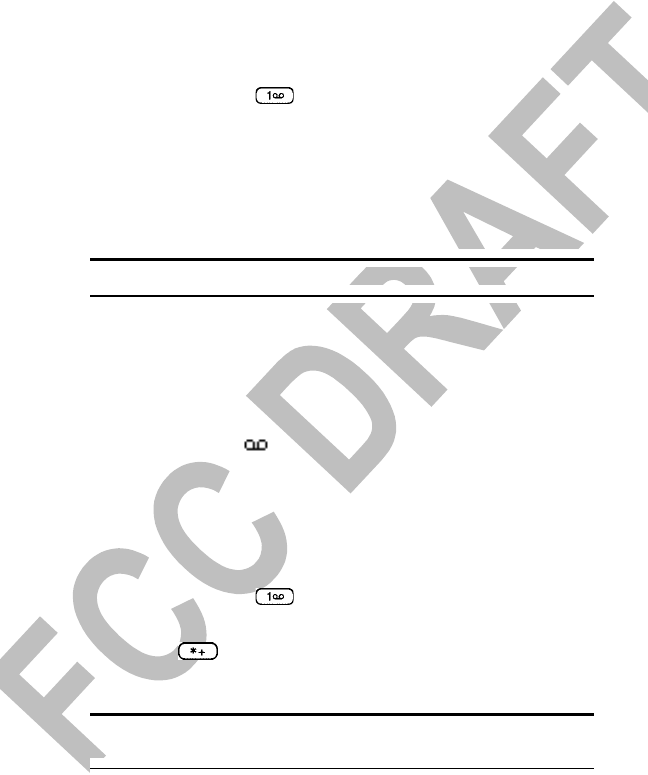
Section 3: Using PCS Service Features
80 3A: The Basics
Using Voicemail
Setting Up Your Voicemail
All unanswered calls to your PCS Phone are automatically
transferred to voicemail, even if your phone is in use or turned
off. Therefore, you will want to set up your PCS Voicemail and
personal greeting as soon as your PCS Phone is activated.
To set up voicemail:
1. Press and hold .
2. Follow the system prompts to create your pass code, record
your greeting, record your name announcement, and
choose whether to activate One-Touch Message Access (a
feature that lets you press one key to access messages and
bypasses the need for you to enter your pass code).
Note: The voicemail setup process may vary in certain Affiliate areas.
Voicemail Notification
There are several ways your PCS Phone alerts you:
䊳By displaying a message on the screen.
䊳By sounding the assigned ringer type.
䊳By displaying at the top of your screen.
New Voicemail Message Alerts
When you receive a new voicemail message, your phone alerts
you and prompts you to call your voicemail.
To call your voicemail:
1. Press and hold .
2. As soon as you hear your own greeting message, press and
hold . You will be prompted to enter your pass code,
then follow the prompts.
Tip: You can also press Listen when you receive notification of new
voicemail messages.
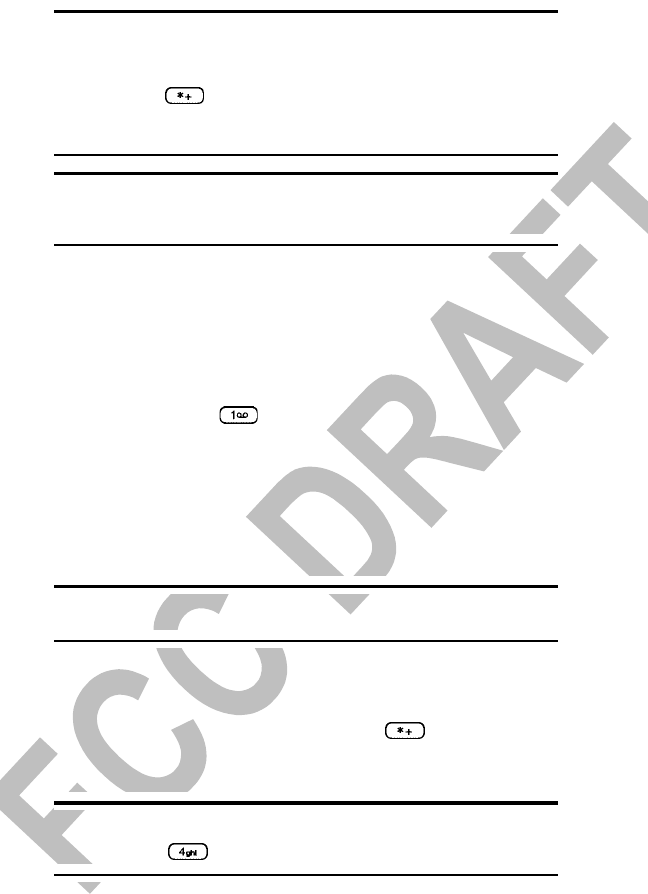
Section 3: Using PCS Service Features
3A: The Basics 81
Important: When you are roaming off the enhanced Sprint Nationwide
PCS Network, you may not receive notification of new voicemail
messages. It is recommended that you periodically check your voicemail
by dialing 1 + area code + your PCS Phone Number. When your voicemail
answers, press and enter your pass code. You will be charged
roaming rates when accessing voicemail while roaming off the enhanced
Sprint Nationwide PCS Network.
Note: Your phone accepts messages even when it is turned off. However,
you are only notified of new messages when your phone is turned on and
you are in a PCS Service Area.
Retrieving Your Voicemail Messages
You can review your messages directly from your PCS Phone or
from any other touch-tone phone. To dial from your PCS Phone,
you can either speed dial your voicemail or use the menu keys.
Using One-Touch Message Access:
䊳Press and hold . Follow the system prompts.
Using the Menu Keys on Your PCS Phone to Access Your Messages:
1. Press Menu, scroll to Messaging, and press Select.
2. Scroll to Voicemail and press Select.
3. Scroll to Call voicemail and press Select.
Note: You are charged for airtime minutes when you are accessing your
voicemail from your PCS Phone.
Using a Phone Other Than Your PCS Phone to Access Messages:
1. Dial your PCS Phone Number.
2. When your voicemail answers, press .
3. Enter your pass code.
Tip: When you call into voicemail you first hear the header information
(date, time, and sender information) for the message. To skip directly to the
message, press during the header.
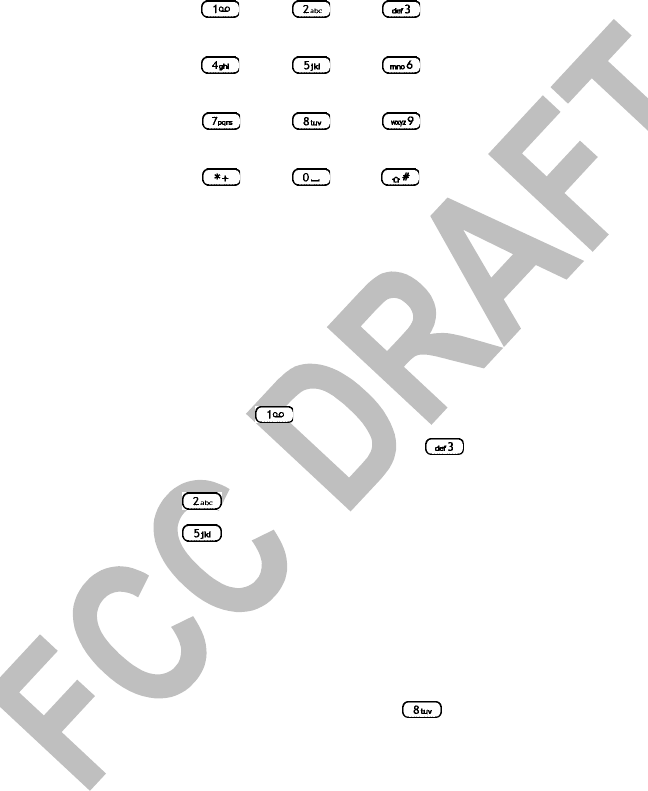
Section 3: Using PCS Service Features
82 3A: The Basics
Voicemail Button Guide
Here’s a quick guide to your keypad functions while listening to
voicemail messages. For further details and menu options, see
“Voicemail Menu Key” on page xx.
Date/Time Send Reply Advance
Replay Forward
Erase Call Back/Reply Save
Cancel Help Skip
Voicemail Options
Your PCS Phone offers several options for organizing and
accessing your voicemail.
Setting Up Group Distribution Lists
Create up to 20 separate group lists, each with up to
20 customers.
1. Press and hold to access your voicemail.
2. Following the system prompts, press to change your
Personal Options.
3. Press for Administrative Options.
4. Press for Group Distribution Lists.
5. Follow the voice prompts to create, edit, rename or delete
group lists.
PCS Callback
Return a call after listening to a message without disconnecting
from voicemail.
1. After listening to a message, press .
2. Enter the phone number.
3. Once the call is complete, you’re returned to the voicemail
main menu.

Section 3: Using PCS Service Features
3A: The Basics 83
Voicemail-to-Voicemail Message
Record and send a voice message to other PCS Voicemail users.
1. From the main voicemail menu, press to send a
message.
2. Follow the voice prompts to enter the phone number.
3. Follow the voice prompts to record and send your voice
message.
Voicemail-to-Voicemail Message Reply
Reply to a voice message received from any other
PCS Voicemail user.
1. After listening to a voice message, press .
2. Follow the voice prompts to record and send your reply.
Voicemail-to-Voicemail Message Forwarding
Forward a voice message, except those marked “Private,” to
other PCS Voicemail users.
1. After listening to a message, press .
2. Follow the voice prompts to enter the phone number.
3. Follow the voice prompts to record your introduction and
forward the voice message.
Voicemail-to-Voicemail Receipt Request
Receive confirmation that your voice message has been listened
to when you send, forward or reply to other PCS users.
1. After you have recorded a message, press to indicate
you are satisfied with the message you recorded.
2. Press to mark receipt requested.
3. Press to send your voicemail message.
Continue Recording
䊳Before pressing to indicate you are satisfied with the
message you recorded, press to continue recording.

Section 3: Using PCS Service Features
84 3A: The Basics
Extended Absence Greeting
When your phone is turned off or you are off the enhanced
Sprint Nationwide PCS Network for an extended period, this
greeting can be played instead of your normal personal greeting.
1. From the main voicemail menu, press for
Personal Options.
2. Press for Greetings.
3. Press to record an Extended Absence Greeting.
Clearing the Voice Message Indicator
Your phone may temporarily continue to display the message
icon after you have checked your voice and text messages.
To clear the icon from the display screen:
1. Press Menu, scroll to Messaging, and press Select.
2. Scroll to Voice messages and press Select.
3. Scroll to Clear new voicemail icon and press OK.

Section 3: Using PCS Service Features
3A: The Basics 85
Voicemail Menu Key
Listen
Envelope Information
Send a Reply Message
Advance 8 Seconds
Rewind to Start
Forward Message
Erase Message
Callback/Place Call
Save Message
Send a Message
Personal Options
Notification Options
Phone Notification
Numeric Paging to a PCS Phone
Return to Personal Options Menu
Administrative Options
Skip Passcode
Autoplay
Message Date & Time On/Off
Change Passcode
Group Distribution List
Return to Personal Options Menu
Greetings
Personal Greetings
Recorded Name
Extended Absence Greeting
Return to Personal Options Menu
Place a Call
Exit Voicemail Menu
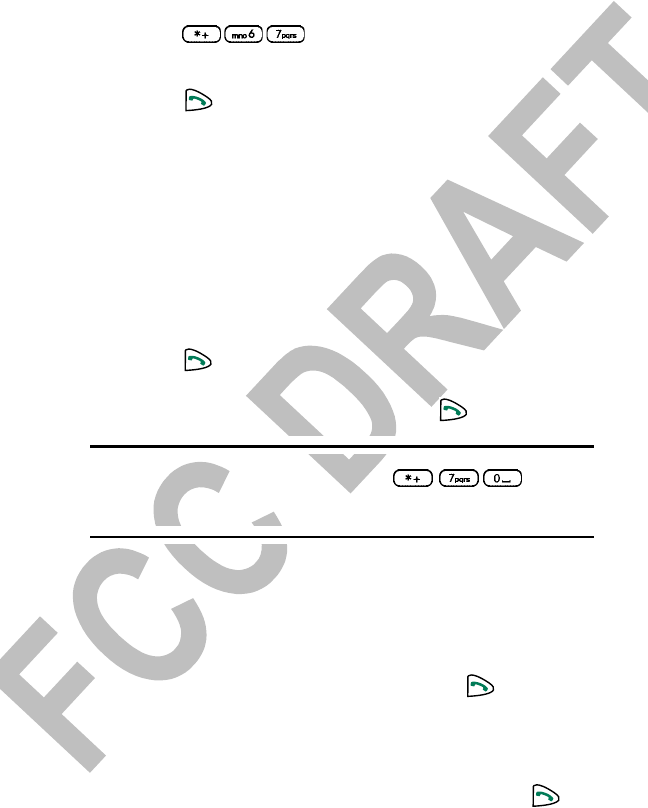
Section 3: Using PCS Service Features
86 3A: The Basics
Using Caller ID
Caller ID lets people know who’s calling by displaying the
number of the person calling.
To block your phone number from being displayed for a
specific outgoing call:
1. Press .
2. Enter the number you want to call.
3. Press .
To permanently block your number, call PCS Customer
Service Solutions.
Responding to Call Waiting
When you’re on a call, Call Waiting alerts you to incoming calls
by sounding two beeps. Your phone’s screen informs you that
another call is coming in and displays the caller’s phone
number (if it is available and you are in digital mode).
To respond to an incoming call while you’re on a call:
䊳Press . This puts the first caller on hold and answers the
second call.
䊳To switch back to the first caller, press again.
Tip: For those calls where you don’t want to be interrupted, you can
temporarily disable Call Waiting by pressing before
placing your call. Call Waiting is automatically reactivated once you end
the call.
Making a Three-Way Call
With Three-Way Calling, you can talk to two people at the same
time. When using this feature, the normal airtime rates will be
charged for each of the two calls.
1. Enter a number you wish to call and press .
2. Once you have established the connection, press Options,
scroll to Three-way call, and press Select. This puts the first
caller on hold so you can dial the second number.
3. Dial the second number you wish to call and press .
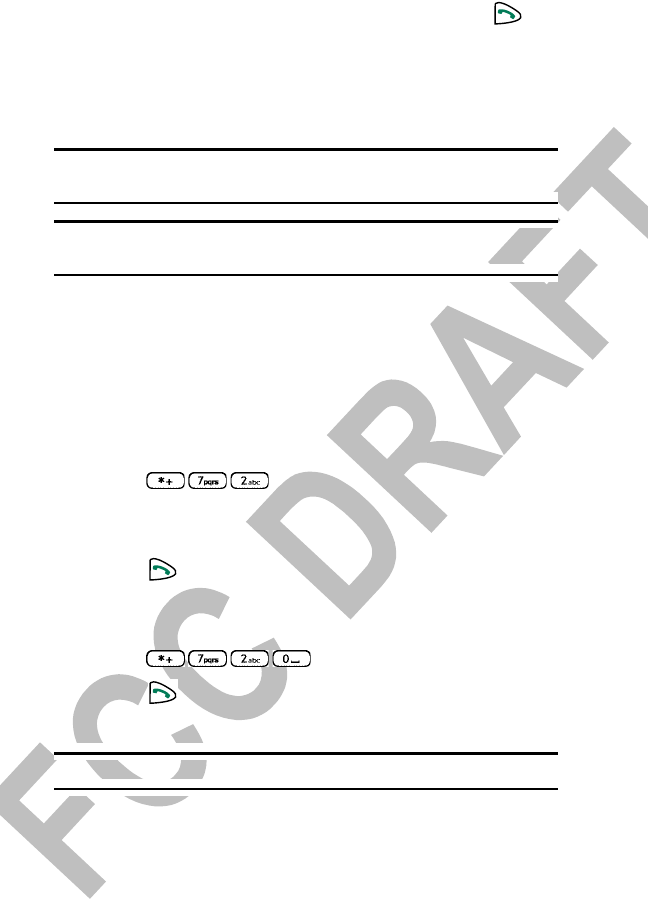
Section 3: Using PCS Service Features
3A: The Basics 87
4. When you’re connected to the second party, press
again to begin your three-way call.
If one of the people you called hangs up during your call, you
and the remaining caller stay connected. If you initiated the call
and are the first to hang up, all three callers are disconnected.
Tip: You can also begin a Three-Way Call by displaying a phone number
stored in your Contacts list, Call logs, or Messaging.
Note: Call Waiting and Three-Way Calling are not available while roaming
off the enhanced Sprint Nationwide PCS Network.
Using Call Forwarding
Call Forwarding lets you forward all your incoming calls to
another phone number – even when your phone is turned off.
You can continue to make calls from your phone when Call
Forwarding is activated.
To Activate Call Forwarding
1. Press .
2. Enter the area code and phone number to which your
future calls should be forwarded.
3. Press . You will see a message and hear a tone to
confirm the activation of Call Forwarding.
To Deactivate Call Forwarding
1. Press .
2. Press . You will see a message and hear a tone to
confirm the deactivation.
Note: You are charged a higher rate for calls you have forwarded.

Section 3: Using PCS Service Features
88 3A: The Basics

Section 3: Using PCS Service Features
3B: PCS Vision 89
Section 3B
Extras
In This Section
䊳Games
䊳Ringing Tones
CS VisionSM brings you clarity you can see and hear with
always-on, advanced multimedia services. These features,
including games and ringing tones, are easy to learn and use and
the rich, colorful graphic experience is visually comparable to
your home or office computer. Clearly, it’s a whole new way to
look at wireless.
P

Section 3: Using PCS Service Features
90 3B: PCS Vision
Games
You can play a variety of entertaining and graphically-rich
games on your PCS Phone.
Customizing Game Settings
To customize the settings for your games:
1. Press Menu, scroll to Games, and press Select.
2. Scroll to Settings and press Select.
3. Scroll through Game sounds, Game lights, and Shakes, and
activate or deactivate these features.
Playing Games
To play a game on your PCS Phone:
1. Press Menu, scroll to Games, and press Select.
2. Scroll to Select a game and press Select.
3. Scroll to a game and press Select.
4. Select the game you wish to play and press Select.
5. Follow the onscreen instructions to play the game. When
you are finished, press Exit or press .
6. A prompt will display: “Really terminate this application?”
Press Yes to exit or No to cancel.
Each game comes with instructions, score history, and other
options.

Section 3: Using PCS Service Features
3B: PCS Vision 91
Ringers
Purchasing Ringing Tones
You can purchase ringers by going to www.sprintpcs.com and
following these easy steps:
1. If you have purchased a ringing tone before, proceed to
Step 2. If you have not previously purchased a ringing tone,
you will be prompted to enter your account password and
create your purchasing profile.
2. After purchasing the ringing tone, your phone notifies you
that a new ringing tone has been received
3. Press Options.
4. Select Playback hear the ringing tone, Save to save the
ringing tone to one of the 10 available memory locations, or
Discard to discard the ringing tone.
Note: Your personal vault saves items for up to 90 days. Once an item
has been downloaded to your phone, you may keep the file for as long as
you like.

Section 3: Using PCS Service Features
92 3B: PCS Vision

Section 3: Using PCS Service Features
3C: PCS Voice Command 93
Section 3C
PCS Voice CommandSM
In This Section
䊳Getting Started with PCS Voice CommandSM
䊳Creating Your Own Address Book
䊳Making a Call with PCS Voice Command
䊳Accessing Information Using PCS Voice Command
ith Sprint, the first wireless provider to offer innovative
PCS Voice Command technology, reaching your friends,
family, and co-workers has never been easier – especially when
you’re on the go. You can even listen to Web-based information
such as news, stock quotes, weather, sports, and much more.
Your voice does it all with PCS Voice Command.
W
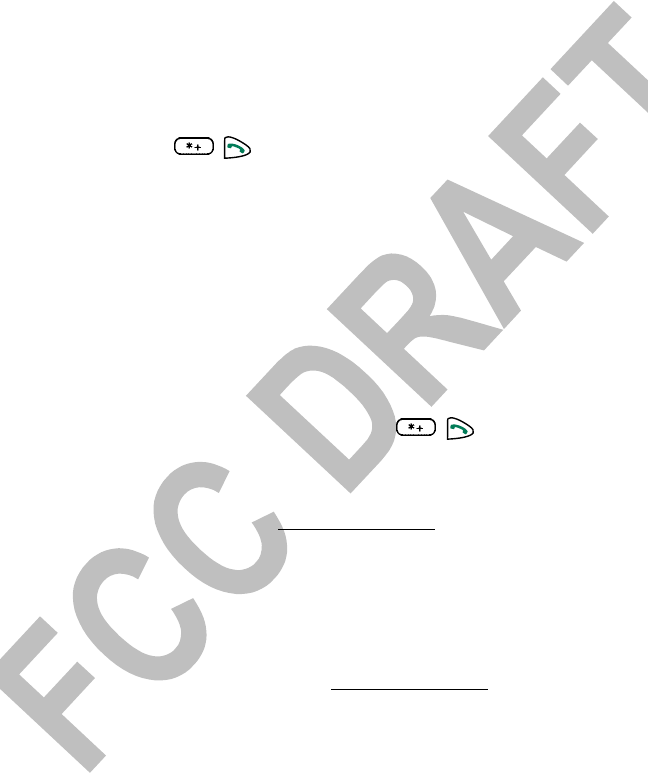
Section 3: Using PCS Service Features
94 3C: PCS Voice Command
Getting Started With PCS Voice Command
With PCS Voice Command:
䊳You can store all your contacts’ phone numbers, so you can
simply say the name of the person you want to call.
䊳There’s no need to punch in a lot of numbers, memorize
voicemail passwords, or try to dial while you’re driving.
䊳You can call anyone in your address book – even if you
don’t remember their phone number.
It’s Easy to Get Started
Just dial from your PCS Phone to activate the service
and listen to brief instructions directly from your phone. There
is a monthly charge for PCS Voice Command.
Creating Your Own Address Book
You can program up to 500 contacts into your personal address
book, with each contact having up to five phone numbers.
That’s 2,500 phone numbers – and with the advanced
technology of PCS Voice Command – you can have instant access
to all of them.
There are four ways to update your address book:
䊳Use Voice Recordings: Simply dial and say, “Add
name.” You will then be asked to say the name and number
you want to add to your personal address book. Your address
book can store up to 20 voice recorded names at once.
䊳On the Web: Go to www.talk.sprintpcs.com and receive a fully
functional Web-based address book to create and update
your contacts.
䊳Use an Existing Address Book: Automatically merge address
books from desktop software applications with Sprint SyncSM
Services for no additional charge. Simply click on the “Click
to synchronize” button within your PCS Voice Command
personal address book at www.talk.sprintpcs.com.
䊳Call Directory Assistance: If you don’t have a computer or
Internet access handy, you can have PCS Directory
Assistance look up phone numbers for you and
automatically add them to your address book. Just say “Call

Section 3: Using PCS Service Features
3C: PCS Voice Command 95
operator” and we’ll add two names and numbers to your
address book for our standard directory assistance charge.
Making a Call With PCS Voice Command
1. Once you’ve signed up for PCS Voice Command and created
your address book, all you do is press . You’ll
hear a tone followed by the prompt “Ready.”
2. After the “Ready” prompt, simply say, in a natural voice,
“Call” and the name of the person or the number you’d like
to call. For example, you can say, “Call Jane Smith at work,”
“Call John Baker on the mobile phone,” “Call 555-1234,” or
“Call Bob Miller.”
3. Your request will be repeated and you will be asked to
verify. Say “Yes” to call the number or person. Say “No” if
you wish to cancel.
4. The number will automatically be dialed. Keep in mind that
PCS Voice Command recognizes not only your voice, but
any voice, so that others can experience the same
convenience if they use your phone.
For more helpful hints on PCS Voice Command, including a list
of recognized commands and an interactive tutorial, visit
www.talk.sprintpcs.com.
Accessing Information Using
PCS Voice Command
1. Press .
2. Say “Call the Web.” (To access, listen to and respond to
email, once email has been set up, say “Call My Email.”)
3. Choose from a listing of information categories like news,
weather, sports, and more.
Note: PCS Voice Command is not available while roaming off the
enhanced Sprint Nationwide PCS Network.

96

Section 4
Safety Guidelines and Warranty Information 97
Section 4
Safety Guidelines and
Warranty Information

98

Section 4: Safety Guidelines and Warranty Information
4A: Safety 99
Section 4A
Safety
In This Section
䊳Getting the Most Out of Your Reception
䊳Maintaining Safe Use of and Access to Your Phone
䊳Caring for the Battery
䊳Acknowledging Special Precautions and the FCC Notice
䊳Consumer Information on Wireless Phones
䊳Owner’s Record
䊳User Guide Proprietary Notice
䊳Accessibility Information
art of getting the most out of your PCS Phone is learning how
the phone works and how to care for it. This section outlines
performance and safety guidelines that help you understand the
basic features of your phone’s operation.
P

Section 4: Safety Guidelines and Warranty Information
100 4A: Safety
Getting the Most Out of Your Reception
Keeping Tabs on Signal Strength
The quality of each call you make or receive depends on the
signal strength in your area. Your phone informs you of the
current signal strength by displaying a number of bars next to
the signal strength icon. The more bars displayed, the stronger
the signal. If you’re inside a building, being near a window may
give you better reception.
Understanding the Power Save Feature
If your phone is unable to find a signal after 15 minutes of
searching, a Power Save feature is automatically activated. If your
phone is active, it periodically rechecks service availability or
you can check it yourself by pressing any key. Anytime the
Power Save feature is activated, a message displays on the screen.
When a signal is found, your phone returns to standby mode.
Understanding How Your Phone Operates
Your phone is basically a radio transmitter and receiver. When
it’s turned on, it receives and transmits radiofrequency (RF)
signals. When you use your phone, the system handling your
call controls the power level. This power can range from
0.00001watts to 0.347 watts, depending on which band your
phone operates.
Knowing Radiofrequency Safety
The design of your PCS Phone complies with updated NCRP
standards described below.
In 1991-92, the Institute of Electrical and Electronics Engineers
(IEEE) and the American National Standards Institute (ANSI)
joined in updating ANSI’s 1982 standard for safety levels with
respect to human exposure to RF signals. More than 120
scientists, engineers and physicians from universities,
government health agencies and industries developed this
updated standard after reviewing the available body of research.
In 1993, the Federal Communications Commission (FCC)
adopted this updated standard in a regulation. In August 1996,
the FCC adopted hybrid standard consisting of the existing
ANSI/IEEE standard and the guidelines published by the

Section 4: Safety Guidelines and Warranty Information
4A: Safety 101
National Council of Radiation Protection and Measurements
(NCRP).
Maintaining Your Phone’s Peak Performance
There are several simple guidelines to operating your phone
properly and maintaining safe, satisfactory service.
䊳Hold the phone with the antenna raised, fully-extended, and
over your shoulder.
䊳Try not to hold, bend, or twist the phone’s antenna.
䊳Don’t use the phone if the antenna is damaged.
䊳Speak directly into the mouthpiece.
䊳For optimal performance, use your phone between a
temperature range of 59ºF to 77ºF (15ºC to 25ºC).
䊳Avoid exposing your phone and accessories to rain or liquid
spills. If your phone does get wet, immediately turn the
power off and remove the battery. If it’s inoperable, return
it to a Sprint Store or call PCS Customer Service SolutionsSM
for service.
Note: For the best care of your phone, only Sprint authorized personnel
should service your phone and accessories. Faulty service may void
the warranty.
Maintaining Safe Use of and Access to
Your Phone
FAILURE TO FOLLOW THE INSTRUCTIONS OUTLINED MAY
LEAD TO SERIOUS PERSONAL INJURY AND POSSIBLE
PROPERTY DAMAGE
Using Your Phone While Driving
Talking on your phone while driving (or operating the phone
without a hands-free device) is prohibited in some jurisdictions.
Laws vary as to specific restrictions. Remember that safety
always comes first.
When using your phone in the car:
䊳Get to know your phone and its features, such as speed dial
and redial.
䊳When available, use a hands-free device.

Section 4: Safety Guidelines and Warranty Information
102 4A: Safety
䊳Position your phone within easy reach.
䊳Let the person you are speaking to know you are driving; if
necessary, suspend the call in heavy traffic or hazardous
weather conditions.
䊳Do not take notes or look up phone numbers while driving.
䊳Dial sensibly and assess the traffic; if possible, place calls
when stationary or before pulling into traffic.
䊳Do not engage in stressful or emotional conversations that
may divert your attention from the road.
䊳Dial 911 to report serious emergencies. It’s free from your
wireless phone.
䊳Use your phone to help others in emergencies.
䊳Call roadside assistance or a special non-emergency wireless
number when necessary.
Tip: Purchase an optional hands-free car kit at your local Sprint Store.
You may also call the PCS Accessory Hotline at 1-800-974-2221 or by
dialing on your PCS Phone.
Following Safety Guidelines
To operate your phone safely and efficiently, always follow
any special regulations in a given area. Turn your phone off in
areas where use is forbidden or when it may cause interference
or danger.
Using Your Phone Near Other Electronic Devices
Most modern electronic equipment is shielded from
radiofrequency (RF) signals. However, RF signals from wireless
phones may affect inadequately shielded electronic equipment.
RF signals may affect improperly installed or inadequately
shielded electronic operating systems and/or entertainment
systems in motor vehicles. Check with the manufacturer or
their representative to determine if these systems are
adequately shielded from external RF signals. Also check with
the manufacturer regarding any equipment that has been added
to your vehicle.
Consult the manufacturer of any personal medical devices, such
as pacemakers and hearing aids, to determine if they are
adequately shielded from external RF signals.

Section 4: Safety Guidelines and Warranty Information
4A: Safety 103
PERSONS WITH A PACEMAKER:
䊳Should always keep the phone at least 20 cm from their
pacemaker when the phone is switched On.
䊳Should not carry the phone in a breast pocket.
䊳Should use the ear opposite the pacemaker to minimize the
potential for interference.
䊳Should switch off the phone immediately if there is any
reason to suspect that interference is taking place.
Note: Always turn off the phone in health care facilities and request
permission before using the phone near medical equipment.
Turning Off Your Phone Before Flying
Turn off your phone before boarding any aircraft. To prevent
possible interference with aircraft systems, the U.S. Federal
Aviation Administration (FAA) regulations require you to have
permission from a crew member to use your phone while the
plane is on the ground. To prevent any risk of interference,
FCC regulations prohibit using your phone while the plane is in
the air.
Turning Off Your Phone in Dangerous Areas
To avoid interfering with blasting operations, turn off your
phone when in a blasting area or in other areas with signs
indicating that two-way radios should be turned off.
Construction crews often use remote-control RF devices to
set off explosives.
Turn off your phone when you’re in any area that has a
potentially explosive atmosphere. Although it’s rare, your
phone or its accessories could generate sparks. Sparks could
cause an explosion or a fire resulting in bodily injury or even
death. These areas are often, but not always, clearly marked.
They include:
䊳Fueling areas such as gas stations.
䊳Below deck on boats.
䊳Fuel or chemical transfer or storage facilities.
䊳Areas where the air contains chemicals or particles such as
grain, just or metal powders.

Section 4: Safety Guidelines and Warranty Information
104 4A: Safety
䊳Any other area where you would normally be advised to
turn off your vehicle’s engine.
Note: Never transport or store flammable gas, liquid or explosives in the
compartment of your vehicle that contains your phone or accessories.
Restricting Children’s Access to your Phone
Your PCS Phone is not a toy. Children should not be allowed to
play with it because they could hurt themselves and others,
damage the phone or make calls that increase your phone bill.
Caring for the Battery
Protecting Your Battery
The guidelines listed below help you get the most out of your
battery’s performance.
䊳Use only Sprint-approved batteries and desktop chargers.
These chargers are designed to maximize battery life. Using
other batteries or chargers voids your warranty and may
cause damage.
䊳In order to avoid damage, charge the battery only in
temperatures that range from -22ºF to 140ºF (-30º C to
60ºC).
䊳Don’t use the battery charger in direct sunlight or in high
humidity areas, such as the bathroom.
䊳Never dispose of the battery by incineration.
䊳Keep the metal contacts on top of the battery clean.
䊳Don’t attempt to disassemble or short-circuit the battery.
䊳The battery may need recharging if it has not been used for
a long period of time.
䊳It’s best to replace the battery when it no longer provides
acceptable performance. It can be recharged hundreds of
times before it needs replacing.
䊳Don’t store the battery in high temperature areas for long
periods of time. It’s best to store the battery in temperatures
that range from 32ºF to 77ºF (0ºC to 25ºC).

Section 4: Safety Guidelines and Warranty Information
4A: Safety 105
Disposal of Lithium Ion (LiIon) Batteries
For safe disposal options of your LiIon batteries, contact your
nearest Sprint-authorized service center.
Special Note: Be sure to dispose of your battery properly. In
some areas, the disposal of batteries in household or business
trash may be prohibited.
Note: For safety, do not handle a damaged or leaking LiIon battery.
Acknowledging Special Precautions and the
FCC Notice
FCC Notice
The phone may cause TV or radio interference if used in close
proximity to receiving equipment. The FCC can require you to
stop using the phone if such interference cannot be eliminated.
Vehicles using liquefied petroleum gas (such as propane or
butane) must comply with the National Fire Protection
Standard (NFPA-58). For a copy of this standard, contact the
National Fire Protection Association, One Batterymarch Park,
Quincy, MA 02269, Attn: Publication Sales Division.
Cautions
Any changes or modifications to your phone not expressly
approved in this document could void your warranty for this
equipment, and void your authority to operate this equipment.
Only use approved batteries, antennas and chargers. The use of
any unauthorized accessories may be dangerous and void the
phone warranty if said accessories cause damage or a defect to
the phone.
Although your phone is quite sturdy, it is a complex piece of
equipment and can be broken. Avoid dropping, hitting,
bending or sitting on it.

Section 4: Safety Guidelines and Warranty Information
106 4A: Safety
Certification Information (SAR)
THIS MODEL PHONE MEETS THE GOVERNMENT’S
REQUIREMENTS FOR EXPOSURE TO RADIO WAVES.
Your wireless phone is a radio transmitter and receiver. It is
designed and manufactured not to exceed the emission limits
for exposure to radio frequency (RF) energy set by the Federal
Communications Commission of the U.S. Government. These
limits are part of comprehensive guidelines and establish
permitted levels of RF energy for the general population. The
guidelines are based on standards that were developed by
independent scientific organizations through periodic and
thorough evaluation of scientific studies. The standards include
a substantial safety margin designed to assure the safety of all
persons, regardless of age and health.
The exposure standard for wireless mobile phones employs a
unit of measurement known as the Specific Absorption Rate, or
SAR. The SAR limit set by the FCC is 1.6W/kg.* Tests for SAR are
conducted using standard operating positions accepted by the
FCC with the phone transmitting at its highest certified power
level in all tested frequency bands. Although the SAR is
determined at the highest certified power level, the actual SAR
level of the phone while operating can be well below the
maximum value. This is because the phone is designed to
operate at multiple power levels so as to use only the power
required to reach the network. In general, the closer you are to
a wireless base station antenna, the lower the power output.
Before a phone model is available for sale to the public, it must
be tested and certified to the FCC that it does not exceed the
limit established by the government-adopted requirement for
safe exposure. The tests are performed in positions and
locations (for example, at the ear and worn on the body) as
required by the FCC for each model. The highest SAR value for
this model phone as reported to the FCC when tested for use at
the ear is 1.15 W/kg, and when worn on the body, as described
in this user guide, is 0.99 W/kg. (Body-worn measurements
differ among phone models, depending upon available
enhancements and FCC requirements).
While there may be differences between the SAR levels of
various phones and at various positions, they all meet the
government requirement.

Section 4: Safety Guidelines and Warranty Information
4A: Safety 107
The FCC has granted an Equipment Authorization for this
model phone with all reported SAR levels evaluated as in
compliance with the FCC RF exposure guidelines. SAR
information on this model phone is on file with the FCC and
can be found under the Display Grant section of
http://www.fcc.gov/oet/fccid after searching on FCC ID
QMNRH-3.
For body worn operation, this phone has been tested and meets
the FCC RF exposure guidelines for use with an accessory that
contains no metal and that positions the handset a minimum of
7/8 inch (2.2 cm) from the body. Use of other accessories may
not ensure compliance with FCC RF exposure guidelines. If you
do not use a body-worn accessory and are not holding the
phone at the ear, position the handset a minimum of 7/8 inch
(2.2 cm) from your body when the phone is switched on.
*In the United States and Canada, the SAR limit for mobile
phones used by the public is 1.6 watts/kilogram (W/kg)
averaged over one gram of tissue. The standard incorporates a
substantial margin of safety to give additional protection for the
public and to account for any variations in measurements. SAR
values may vary depending on national reporting requirements
and the network band. For SAR information in other regions
please look under product information at www.nokia.com/us.
Consumer Information on Wireless Phones
(The following information comes from a consumer
information Web site jointly sponsored by the U.S. Food and
Drug Administration (FDA) and the Federal Communications
Commission (FCC), entitled “Cell Phone Facts: Consumer
Information on Wireless Phones.” The information reproduced
herein is dated April 3, 2002. For further updates, please visit
the Web site: http://www.fda.gov/cellphones/.)
1. What is radiofrequency energy (RF)?
Radiofrequency (RF) energy is another name for radio waves. It
is one form of electromagnetic energy that makes up the
electromagnetic spectrum. Some of the other forms of energy
in the electromagnetic spectrum are gamma rays, x-rays and
light. Electromagnetic energy (or electromagnetic radiation)
consists of waves of electric and magnetic energy moving

Section 4: Safety Guidelines and Warranty Information
108 4A: Safety
together (radiating) through space. The area where these waves
are found is called an electromagnetic field.
Radio waves are created due to the movement of electrical
charges in antennas. As they are created, these waves radiate
away from the antenna. All electromagnetic waves travel at the
speed of light. The major differences between the different
types of waves are the distances covered by one cycle of the
wave and the number of waves that pass a certain point during
a set time period. The wavelength is the distance covered by
one cycle of a wave. The frequency is the number of waves
passing a given point in one second. For any electromagnetic
wave, the wavelength multiplied by the frequency equals the
speed of light. The frequency of an RF signal is usually
expressed in units called hertz (Hz). One Hz equals one wave
per second. One kilohertz (kHz) equals one thousand waves
per second, one megahertz (MHz) equals one million waves per
second, and one gigahertz (GHz) equals one billion waves per
second.
RF energy includes waves with frequencies ranging from about
3000 waves per second (3 kHz) to 300 billion waves per second
(300 GHz). Microwaves are a subset of radio waves that have
frequencies ranging from around 300 million waves per second
(300 MHz) to three billion waves per second (3 GHz).
2. How is radiofrequency energy used?
Probably the most important use of RF energy is for telecommu-
nications. Radio and TV broadcasting, wireless phones, pagers,
cordless phones, police and fire department radios, point-to-
point links and satellite communications all rely on RF energy.
Other uses of RF energy include microwave ovens, radar,
industrial heaters and sealers, and medical treatments. RF
energy, especially at microwave frequencies, can heat water.
Since most food has a high water content, microwaves can
cook food quickly. Radar relies on RF energy to track cars and
airplanes as well as for military applications. Industrial heaters
and sealers use RF energy to mold plastic materials, glue wood
products, seal leather items such as shoes and pocketbooks,
and process food. Medical uses of RF energy include pacemaker
monitoring and programming.

Section 4: Safety Guidelines and Warranty Information
4A: Safety 109
3. How is radiofrequency radiation measured?
RF waves and RF fields have both electrical and magnetic
components. It is often convenient to express the strength of
the RF field in terms of each component. For example, the unit
"volts per meter" (V/m) is used to measure the electric field
strength, and the unit "amperes per meter" (A/m) is used to
express the magnetic field strength. Another common way to
characterize an RF field is by means of the power density.
Power density is defined as power per unit area. For example,
power density can be expressed in terms of milliwatts (one
thousandth of a watt) per square centimeter (mW/cm2 or
microwatts (one millionth of a watt) per square centimeter
(µW/cm2).
The quantity used to measure how much RF energy is actually
absorbed by the body is called the Specific Absorption Rate or
SAR. The SAR is a measure of the rate of absorption of RF
energy. It is usually expressed in units of watts per kilogram
(W/kg) or milliwatts per gram (mW/g).
4. What biological effects can be caused by RF energy?
The biological effects of radiofrequency energy should not be
confused with the effects from other types of electromagnetic
energy.
Very high levels of electromagnetic energy, such as is found in
X-rays and gamma rays can ionize biological tissues. Ionization
is a process where electrons are stripped away from their
normal locations in atoms and molecules. It can permanently
damage biological tissues including DNA, the genetic material.
Ionization only occurs with very high levels of electromagnetic
energy such as X-rays and gamma rays. Often the term radiation
is used when discussing ionizing radiation (such as that
associated with nuclear power plants).
The energy levels associated with radiofrequency energy,
including both radio waves and microwaves, are not great
enough to cause the ionization of atoms and molecules.
Therefore, RF energy is a type of non-ionizing radiation. Other
types of non-ionizing radiation include visible light, infrared
radiation (heat) and other forms of electromagnetic radiation
with relatively low frequencies.

Section 4: Safety Guidelines and Warranty Information
110 4A: Safety
Large amounts of RF energy can heat tissue. This can damage
tissues and increase body temperatures. Two areas of the body,
the eyes and the testes, are particularly vulnerable to RF heating
because there is relatively little blood flow in them to carry
away excess heat.
The amount of RF radiation routinely encountered by the
general public is too low to produce significant heating or
increased body temperature. Still, some people have questions
about the possible health effects of low levels of RF energy. It is
generally agreed that further research is needed to determine
what effects actually occur and whether they are dangerous to
people. In the meantime, standards-setting organizations and
government agencies are continuing to monitor the latest
scientific findings to determine whether changes in safety limits
are needed to protect human health.
FDA, EPA and other US government agencies responsible for
public health and safety have worked together and in
connection with WHO to monitor developments and identify
research needs related to RF biological effects.
5. What levels of RF energy are considered safe?
Various organizations and countries have developed standards
for exposure to radiofrequency energy. These standards
recommend safe levels of exposure for both the general public
and for workers. In the United States, the FCC has used safety
guidelines for RF environmental exposure since 1985.
The FCC guidelines for human exposure to RF electromagnetic
fields are derived from the recommendations of two expert
organizations, the National Council on Radiation Protection and
Measurements (NCRP) and the Institute of Electrical and
Electronics Engineers (IEEE). In both cases, the
recommendations were developed by scientific and
engineering experts drawn from industry, government, and
academia after extensive reviews of the scientific literature
related to the biological effects of RF energy.
Many countries in Europe and elsewhere use exposure
guidelines developed by the International Commission on Non-
Ionizing Radiation Protection (ICNIRP). The ICNIRP safety
limits are generally similar to those of the NCRP and IEEE, with
a few exceptions. For example, ICNIRP recommends different
exposure levels in the lower and upper frequency ranges and

Section 4: Safety Guidelines and Warranty Information
4A: Safety 111
for localized exposure from certain products such as hand-held
wireless telephones. Currently, the World Health Organization
is working to provide a framework for international
harmonization of RF safety standards.
The NCRP, IEEE, and ICNIRP all have identified a whole-body
Specific Absorption Rate (SAR) value of 4 watts per kilogram
(4 W/kg) as a threshold level of exposure at which harmful
biological effects may occur. Exposure guidelines in terms of
field strength, power density and localized SAR were then
derived from this threshold value. In addition, the NCRP, IEEE,
and ICNIRP guidelines vary depending on the frequency of the
RF exposure. This is due to the finding that whole-body human
absorption of RF energy varies with the frequency of the RF
signal. The most restrictive limits on whole-body exposure are
in the frequency range of 30-300 MHz where the human body
absorbs RF energy most efficiently. For products that only
expose part of the body, such as wireless phones, exposure
limits in terms of SAR only are specified.
The exposure limits used by the FCC are expressed in terms of
SAR, electric and magnetic field strength, and power density for
transmitters operating at frequencies from 300 kHz to 100 GHz.
The specific values can be found in two FCC bulletins, OET
Bulletins 56 and 65:
http://www.fcc.gov/oet/info/documents/bulletins/#56;
http://www.fcc.gov/oet/info/documents/bulletins/#65
6. Why has the FCC adopted guidelines for RF exposure?
The FCC authorizes and licenses products, transmitters, and
facilities that generate RF and microwave radiation. It has
jurisdiction over all transmitting services in the U.S. except those
specifically operated by the Federal Government. While the FCC
does not have the expertise to determine radiation exposure
guidelines on its own, it does have the expertise and authority to
recognize and adopt technically sound standards promulgated by
other expert agencies and organizations, and has done so. (Our
joint efforts with the FDA in developing this website is illustrative
of the kind of inter-agency efforts and consultation we engage in
regarding this health and safety issue.)
Under the National Environmental Policy Act of 1969 (NEPA),
the FCC has certain responsibilities to consider whether its
actions will significantly affect the quality of the human

Section 4: Safety Guidelines and Warranty Information
112 4A: Safety
environment. Therefore, FCC approval and licensing of
transmitters and facilities must be evaluated for significant
impact on the environment. Human exposure to RF radiation
emitted by FCC-regulated transmitters is one of several factors
that must be considered in such environmental evaluations. In
1996, the FCC revised its guidelines for RF exposure as a result
of a multi-year proceeding and as required by the
Telecommunications Act of 1996.
Radio and television broadcast stations, satellite-earth stations,
experimental radio stations and certain wireless
communication facilities are required to undergo routine
evaluation for RF compliance when they submit an application
to the FCC for construction or modification of a transmitting
facility or renewal of a license. Failure to comply with the FCC’s
RF exposure guidelines could lead to the preparation of a
formal Environmental Assessment, possible Environmental
Impact Statement and eventual rejection of an application.
Technical guidelines for evaluating compliance with the FCC RF
safety requirements can be found in the FCC’s OET Bulletin 65.
http://www.fcc.gov/oet/info/documents/bulletins/#65
Low-powered, intermittent, or inaccessible RF transmitters and
facilities are normally excluded from the requirement for routine
evaluation for RF exposure. These exclusions are based on
standard calculations and measurement data indicating that a
transmitting station or equipment operating under the conditions
prescribed is unlikely to cause exposures in excess of the
guidelines under normal conditions of use. Such exclusions are
not exclusions from compliance, but, rather, exclusions from
routine evaluation. The FCC’s policies on RF exposure and
categorical exclusion can be found in Section 1.1307(b) of the
FCC’s Rules and Regulations [(47 CFR 1.1307(b)].
7. How can I obtain the Specific Absorption Rate (SAR) value for
my wireless phone?
The FCC requires that wireless phones sold in the United States
demonstrate compliance with human exposure limits adopted
by the FCC in 1996. The relative amount of RF energy absorbed
in the head of a wireless telephone-user is given by the Specific
Absorption Rate (SAR), as explained above. The FCC requires
wireless phones to comply with a safety limit of 1.6 watts per
kilogram (1.6 W/kg) in terms of SAR.

Section 4: Safety Guidelines and Warranty Information
4A: Safety 113
Information on SAR for a specific phone model can be obtained
for many recently manufactured phones using the FCC
identification (ID) number for that model. The FCC ID number
is usually printed somewhere on the case of the phone.
Sometimes it may be necessary to remove the battery pack to
find the number. Once you have the ID number, go to the
following Web address: www.fcc.gov/oet/fccid. On this page, you
will see instructions for entering the FCC ID number. Type the
FCC ID number exactly as requested (the Grantee Code is the
first three characters, the Equipment Product Code is the rest of
the FCC ID number). Then click on "Start Search." The "Grant of
Equipment Authorization" for your telephone should appear.
Read through the grant for the section on "SAR Compliance,"
"Certification of Compliance with FCC Rules for RF Exposure"
or similar language. This section should contain the value(s) for
typical or maximum SAR for your phone.
Phones and other products authorized since June 2, 2000,
should have the maximum SAR levels noted directly on the
"Grant of Equipment Authorization." For phones and products
authorized between about mid-1998 and June 2000, detailed
information on SAR levels is typically found in the exhibits
associated with the grant. Once a grant is accessed, the exhibits
can be viewed by clicking on "View Exhibit." Grants authorized
prior to 1998 are not part of the electronic database but, rather,
have been documented in the form of paper records.
The FCC database does not list phones by model number.
However, consumers may find SAR information from other
sources as well. Some wireless phone manufacturers make
SAR information available on their own Web sites. In addition,
some non-government Web sites provide SARs for specific
models of wireless phones. However, the FCC has not reviewed
these sites and makes no guarantees of their accuracy. Finally,
phones certified by the Cellular Telecommunications and
Internet Association (CTIA) are required to provide SAR
information to consumers in the instructional materials that
come with the phones.
8. Do hands-free kits for wireless phones reduce risks from
exposure to RF emissions?
Since there are no known risks from exposure to RF emissions
from wireless phones, there is no reason to believe that hands-
free kits reduce risks. Hands-free kits can be used with wireless

Section 4: Safety Guidelines and Warranty Information
114 4A: Safety
phones for convenience and comfort. These systems reduce
the absorption of RF energy in the head because the phone,
which is the source of the RF emissions, will not be placed
against the head. On the other hand, if the phone is mounted
against the waist or other part of the body during use, then that
part of the body will absorb more RF energy. Wireless phones
marketed in the U.S. are required to meet safety requirements
regardless of whether they are used against the head or against
the body. Either configuration should result in compliance with
the safety limit.
9. Do wireless phone accessories that claim to shield the head
from RF radiation work?
Since there are no known risks from exposure to RF emissions
from wireless phones, there is no reason to believe that
accessories that claim to shield the head from those emissions
reduce risks. Some products that claim to shield the user from
RF absorption use special phone cases, while others involve
nothing more than a metallic accessory attached to the phone.
Studies have shown that these products generally do not work
as advertised. Unlike "hand-free" kits, these so-called "shields"
may interfere with proper operation of the phone. The phone
may be forced to boost its power to compensate, leading to an
increase in RF absorption. In February 2002, the Federal trade
Commission (FTC) charged two companies that sold devices
that claimed to protect wireless phone users from radiation
with making false and unsubstantiated claims. According to
FTC, these defendants lacked a reasonable basis to substantiate
their claim.
10. What are wireless telephone base stations?
Fixed antennas used for wireless telecommunications are
referred to as cellular base stations, cell stations, PCS ("Personal
Communications Service") stations or telephone transmission
towers. These base stations consist of antennas and electronic
equipment. Because the antennas
need to be high in the air, they are often located on towers,
poles, water tanks, or rooftops. Typical heights for freestanding
base station towers are 50-200 feet.
Some base stations use antennas that look like poles, 10 to 15
feet in length, that are referred to as "omni-directional"
antennas. These types of antennas are usually found in rural

Section 4: Safety Guidelines and Warranty Information
4A: Safety 115
areas. In urban and suburban areas, wireless providers now
more commonly use panel or sector antennas for their base
stations. These antennas consist of rectangular panels, about 1
by 4 feet in dimension. The antennas are usually arranged in
three groups of three antennas each. One antenna in each
group is used to transmit signals to wireless phones, and the
other two antennas in each group are used to receive signals
from wireless phones.
At any base station site, the amount of RF energy produced
depends on the number of radio channels (transmitters) per
antenna and the power of each transmitter. Typically, 21
channels per antenna sector are available. For a typical cell site
using sector antennas, each of the three transmitting antennas
could be connected to up to 21 transmitters for a total of 63
transmitters. However, it is unlikely that all of the transmitters
would be transmitting at the same time. When omni-directional
antennas are used, a cellular base station could theoretically use
up to 96 transmitters, but this would be very unusual, and,
once again, it is unlikely that all transmitters would be in
operation simultaneously. Base stations used for PCS
communications generally require fewer transmitters than
those used for cellular radio transmissions, since PCS carriers
usually have a higher density of base station antenna sites.
11. Are wireless telephone base stations safe?
The electromagnetic RF signals transmitted from base station
antennas stations travel toward the horizon in relatively narrow
paths. For example, the radiation pattern for an antenna array
mounted on a tower can be likened to a thin pancake centered
around the antenna system. The individual pattern for a single
array of sector antennas is wedge-shaped, like a piece of pie. As
with all forms of electromagnetic energy, the power decreases
rapidly as one moves away from the antenna. Therefore, RF
exposure on the ground is much less than exposure very close
to the antenna and in the path of the transmitted radio signal. In
fact, ground-level exposure from such antennas is typically
thousands of times less than the exposure levels recommended
as safe by expert organizations. So exposure to nearby residents
would be well within safety margins.
Cellular and PCS base stations in the United States are required
to comply with limits for exposure recommended by expert
organizations and endorsed by government agencies

Section 4: Safety Guidelines and Warranty Information
116 4A: Safety
responsible for health and safety. Measurements made near
cellular and PCS base station antennas mounted on towers have
confirmed that ground-level exposures are typically thousands
of times less than the exposure limits adopted by the FCC. In
fact, in order to be exposed to levels at or near the FCC limits
for cellular or PCS frequencies an individual would essentially
have to remain in the main transmitted radio signal (at the
height of the antenna) and within a few feet from the antenna.
This is, of course, very unlikely to occur.
When cellular and PCS antennas are mounted on rooftops, RF
levels on that roof or on others near by would probably be
greater than those typically encountered on the ground.
However, exposure levels approaching or exceeding safety
guidelines should be encountered only very close to or directly
in front of the antennas. In addition, for sector-type antennas,
typically used for such rooftop base stations, RF levels to the
side and in back of these antennas are insignificant. General
guidelines on antenna installations and circumstances that
might give rise to a concern about an facility’s conformance
with FCC regulations can be found in A Local Government
Official’s Guide to Transmitting Antenna RF Emission Safety:
Rules, Procedures, and Practical Guidance. This Guide can be
accessed at: http://www.fcc.gov/oet/rfsafety.
12. Who regulates exposure to radiation from microwave ovens,
television sets and computer monitors?
The Food and Drug Administration is responsible for protecting
the public from harmful radiation emissions from these
consumer products.
13. Does the FCC routinely monitor radiofrequency radiation from
antennas?
The FCC does not have the resources or the personnel to
routinely monitor the emissions for all the thousands of
transmitters that are subject to FCC jurisdiction. However, the
FCC does have measurement instrumentation for evaluating RF
levels in areas that may be accessible to the public or to
workers. If there is evidence for potential non-compliance with
FCC exposure guidelines for a FCC-regulated facility, staff from
the FCC’s Office of Engineering and Technology or the FCC
Enforcement Bureau can conduct and investigation, and, if
appropriate, perform actual measurements. Circumstances that

Section 4: Safety Guidelines and Warranty Information
4A: Safety 117
could give rise to a concern about an facility’s conformance
with FCC regulations can be found in A Local Government
Official’s Guide to Transmitting Antenna RF Emission Safety:
Rules, Procedures, and Practical Guidance. This Guide can be
accessed at: http://www.fcc.gov/oet/rfsafety. Potential exposure
problems should be brought to the FCC’s attention by
contacting the FCC RF Safety Program at: 202-418-2464 or by
e-mail: rfsafety@fcc.gov.
14. Does the FCC maintain a database that includes information on
the location and technical parameters of all the transmitting
towers it regulates?
Each of the FCC Bureaus maintains its own licensing database
system for the service(s) it regulates (e.g., television, cellular
service, satellite earth stations.) The FCC issues two types of
licenses: site specific and market based. In the case of site
specific licensed facilities, technical operating information is
collected from the licensee as part of the licensing process.
However, in the case of market based licensing (e.g., PCS,
cellular), the licensee is granted the authority to operate a radio
communications system in a geographic area using as many
facilities as are required, and the licensee is not required to
provide the FCC with specific location and operating
parameters of these facilities.
Information on site specific licensed facilities can be found in
the "General Menu Reports" (GenMen) at
http://gullfoss2.fcc.gov/cgi-bin/ws.exe/genmen/index.hts.
The various FCC Bureaus also publish on at least a weekly basis,
bulk extracts of their licensing databases. Each licensing
database has its own unique file structure. These extracts
consist of multiple, very large files. The FCC’s Office of
Engineering and Technology (OET) maintains an index to these
databases at http://www.fcc.gov/oet/info/database/fadb.html. Entry
points into the various databases include frequency, state/
county, latitude/longitude, call-sign and licensee name. For
further information on the Commission’s existing databases,
you can contact Donald Campbell at dcampbel@fcc.gov or
202-418-2405.

Section 4: Safety Guidelines and Warranty Information
118 4A: Safety
15. Can local and state governmental bodies establish limits for RF
exposure?
Although some local and state governments have enacted rules
and regulations about human exposure to RF energy in the past,
the Telecommunications Act of 1996 requires the Federal
Government to control human exposure to RF emissions. In
particular, Section 704 of the Act states that, "No State or local
government or instrumentality thereof may regulate the
placement, construction, and modification of personal wireless
service facilities on the basis of the environmental effects of
radio frequency emissions to the extent that such facilities
comply with the Commission’s regulations concerning such
emissions." Further information on federal authority and FCC
policy is available in a fact sheet from the FCC’s Wireless
Telecommunications Bureau at www.fcc.gov/wtb.
16. Do wireless phones pose a health hazard?
The available scientific evidence does not show that any health
problems are associated with using wireless phones. There is
no proof, however, that wireless phones are absolutely safe.
Wireless phones emit low levels of radiofrequency energy (RF)
in the microwave range while being used. They also emit very
low levels of RF when in the stand-by mode. Whereas high
levels of RF can produce health effects (by heating tissue),
exposure to low level RF that does not produce heating effects
causes no known adverse health effects. Many studies of low
level RF exposures have not found any biological effects. Some
studies have suggested that some biological effects may occur,
but such findings have not been confirmed by additional
research. In some cases, other researchers have had difficulty in
reproducing those studies, or in determining the reasons for
inconsistent results.
17. What is FDA’s role concerning the safety of wireless phones?
Under the law, FDA does not review the safety of radiation-
emitting consumer products such as wireless phones before
they can be sold, as it does with new drugs or medical devices.
However, the agency has authority to take action if wireless
phones are shown to emit radiofrequency energy (RF) at a level
that is hazardous to the user. In such a case, FDA could require
the manufacturers of wireless phones to notify users of the

Section 4: Safety Guidelines and Warranty Information
4A: Safety 119
health hazard and to repair, replace or recall the phones so that
the hazard no longer exists.
Although the existing scientific data do not justify FDA
regulatory actions, FDA has urged the wireless phone industry
to take a number of steps, including the following:
䊳Support needed research into possible biological effects of
RF of the type emitted by wireless phones;
䊳Design wireless phones in a way that minimizes any RF
exposure to the user that is not necessary for device
function; and
䊳Cooperate in providing users of wireless phones with the
best possible information on possible effects of wireless
phone use on human health
FDA belongs to an interagency working group of the federal
agencies that have responsibility for different aspects of RF
safety to ensure coordinated efforts at the federal level. The
following agencies belong to this working group:
䊳National Institute for Occupational Safety and Health
䊳Environmental Protection Agency
䊳Federal Communications Commission
䊳Occupational Safety and Health Administration
䊳National Telecommunications and Information
Administration
The National Institutes of Health participates in some
interagency working group activities, as well.
FDA shares regulatory responsibilities for wireless phones with
the Federal Communications Commission (FCC). All phones
that are sold in the United States must comply with FCC safety
guidelines that limit RF exposure. FCC relies on FDA and other
health agencies for safety questions about wireless phones.
FCC also regulates the base stations that the wireless phone
networks rely upon. While these base stations operate at higher
power than do the wireless phones themselves, the RF
exposures that people get from these base stations are typically
thousands of times lower than those they can get from wireless
phones. Base stations are thus not the primary subject of the
safety questions discussed in this document.

Section 4: Safety Guidelines and Warranty Information
120 4A: Safety
18. What kinds of phones are the subject of this update?
The term “wireless phone” refers here to hand-held wireless
phones with built-in antennas, often called “cell,” “mobile,” or
“PCS” phones. These types of wireless phones can expose the
user to measurable radiofrequency energy (RF) because of the
short distance between the phone and the user’s head. These
RF exposures are limited by Federal Communications
Commission safety guidelines that were developed with the
advice of FDA and other federal health and safety agencies.
When the phone is located at greater distances from the user,
the exposure to RF is drastically lower because a person's RF
exposure decreases rapidly with increasing distance from the
source. The so-called "cordless phones," which have a base unit
connected to the telephone wiring in a house, typically operate
at far lower power levels, and thus produce RF exposures well
within the FCC's compliance limits.
19. What are the results of the research done already?
The research done thus far has produced conflicting results,
and many studies have suffered from flaws in their research
methods. Animal experiments investigating the effects of
radiofrequency energy (RF) exposures characteristic of wireless
phones have yielded conflicting results that often cannot be
repeated in other laboratories. A few animal studies, however,
have suggested that low levels of RF could accelerate the
development of cancer in laboratory animals. However, many
of the studies that showed increased tumor development used
animals that had been genetically engineered or treated with
cancer-causing chemicals so as to be pre-disposed to develop
cancer in the absence of RF exposure. Other studies exposed
the animals to RF for up to 22 hours per day. These conditions
are not similar to the conditions under which people use
wireless phones, so we don’t know with certainty what the
results of such studies mean for human health.
Three large epidemiology studies have been published since
December 2000. Between them, the studies investigated any
possible association between the use of wireless phones and
primary brain cancer, glioma, meningioma, or acoustic
neuroma, tumors of the brain or salivary gland, leukemia, or
other cancers. None of the studies demonstrated the existence
of any harmful health effects from wireless phone RF
exposures. However, none of the studies can answer questions

Section 4: Safety Guidelines and Warranty Information
4A: Safety 121
about long-term exposures, since the average period of phone
use in these studies was around three years.
20. What research is needed to decide whether RF exposure from
wireless phones poses a health risk?
A combination of laboratory studies and epidemiological studies
of people actually using wireless phones would provide some of
the data that are needed. Lifetime animal exposure studies could
be completed in a few years. However, very large numbers of
animals would be needed to provide reliable proof of a cancer
promoting effect if one exists. Epidemiological studies can
provide data that is directly applicable to human populations,
but 10 or more years’ follow-up may be needed to provide
answers about some health effects, such as cancer. This is
because the interval between the time of exposure to a cancer-
causing agent and the time tumors develop - if they do - may be
many, many years. The interpretation of epidemiological studies
is hampered by difficulties in measuring actual RF exposure
during day-to-day use of wireless phones. Many factors affect
this measurement, such as the angle at which the phone is held,
or which model of phone is used.
21. What is FDA doing to find out more about the possible health
effects of wireless phone RF?
FDA is working with the U.S. National Toxicology Program and
with groups of investigators around the world to ensure that
high priority animal studies are conducted to address important
questions about the effects of exposure to radiofrequency
energy (RF).
FDA has been a leading participant in the World Health
Organization International Electromagnetic Fields (EMF)
Project since its inception in 1996. An influential result of this
work has been the development of a detailed agenda of
research needs that has driven the establishment of new
research programs around the world. The Project has also
helped develop a series of public information documents on
EMF issues.
FDA and the Cellular Telecommunications & Internet
Association (CTIA) have a formal Cooperative Research and
Development Agreement (CRADA) to do research on wireless
phone safety. FDA provides the scientific oversight, obtaining
input from experts in government, industry, and academic

Section 4: Safety Guidelines and Warranty Information
122 4A: Safety
organizations. CTIA-funded research is conducted through
contracts to independent investigators. The initial research will
include both laboratory studies and studies of wireless phone
users. The CRADA will also include a broad assessment of
additional research needs in the context of the latest research
developments around the world.
22. What steps can I take to reduce my exposure to radiofrequency
energy from my wireless phone?
If there is a risk from these products--and at this point we do
not know that there is--it is probably very small. But if you are
concerned about avoiding even potential risks, you can take a
few simple steps to minimize your exposure to radiofrequency
energy (RF). Since time is a key factor in how much exposure a
person receives, reducing the amount of time spent using a
wireless phone will reduce RF exposure.
If you must conduct extended conversations by wireless phone
every day, you could place more distance between your body
and the source of the RF, since the exposure level drops off
dramatically with distance. For example, you could use a
headset and carry the wireless phone away from your body or
use a wireless phone connected to a remote antenna
Again, the scientific data do not demonstrate that wireless
phones are harmful. But if you are concerned about the RF
exposure from these products, you can use measures like those
described above to reduce your RF exposure from wireless
phone use.
23. What about children using wireless phones?
The scientific evidence does not show a danger to users of
wireless phones, including children and teenagers. If you want
to take steps to lower exposure to radiofrequency energy (RF),
the measures described above would apply to children and
teenagers using wireless phones. Reducing the time of wireless
phone use and increasing the distance between the user and
the RF source will reduce RF exposure.
Some groups sponsored by other national governments have
advised that children be discouraged from using wireless phones
at all. For example, the government in the United Kingdom
distributed leaflets containing such a recommendation in
December 2000. They noted that no evidence exists that using a

Section 4: Safety Guidelines and Warranty Information
4A: Safety 123
wireless phone causes brain tumors or other ill effects. Their
recommendation to limit wireless phone use by children was
strictly precautionary; it was not based on scientific evidence
that any health hazard exists.
24. What about wireless phone interference with medical
equipment?
Radiofrequency energy (RF) from wireless phones can interact
with some electronic devices. For this reason, FDA helped
develop a detailed test method to measure electromagnetic
interference (EMI) of implanted cardiac pacemakers and
defibrillators from wireless telephones. This test method is now
part of a standard sponsored by the Association for the
Advancement of Medical instrumentation (AAMI). The final
draft, a joint effort by FDA, medical device manufacturers, and
many other groups, was completed in late 2000. This standard
will allow manufacturers to ensure that cardiac pacemakers and
defibrillators are safe from wireless phone EMI.
FDA has tested hearing aids for interference from handheld
wireless phones and helped develop a voluntary standard
sponsored by the Institute of Electrical and Electronic
Engineers (IEEE). This standard specifies test methods and
performance requirements for hearing aids and wireless phones
so that no interference occurs when a person uses a
“compatible” phone and a “compatible” hearing aid at the same
time. This standard was approved by the IEEE in 2000.
FDA continues to monitor the use of wireless phones for
possible interactions with other medical devices. Should
harmful interference be found to occur, FDA will conduct
testing to assess the interference and work to resolve
the problem.
25. Which other federal agencies have responsibilities related to
potential RF health effects?
Certain agencies in the Federal Government have been involved
in monitoring, researching or regulating issues related to
human exposure to RF radiation. These agencies include the
Food and Drug Administration (FDA), the Environmental
Protection Agency (EPA), the Occupational Safety and Health
Administration (OSHA), the National Institute for Occupational
Safety and Health (NIOSH), the National Telecommunications

Section 4: Safety Guidelines and Warranty Information
124 4A: Safety
and Information Administration (NTIA) and the Department of
Defense (DOD).
By authority of the Radiation Control for Health and Safety Act of
1968, the Center for Devices and Radiological Health (CDRH) of
the FDA develops performance standards for the emission of
radiation from electronic products including X-ray equipment,
other medical devices, television sets, microwave ovens, laser
products and sunlamps. The CDRH established a product
performance standard for microwave ovens in 1971 limiting the
amount of RF leakage from ovens. However, the CDRH has not
adopted performance standards for other RF-emitting products.
The FDA is, however, the lead federal health agency in
monitoring the latest research developments and advising other
agencies with respect to the safety of RF-emitting products used
by the public, such as cellular and PCS phones.
The FDA’s microwave oven standard is an emission standard (as
opposed to an exposure standard) that allows specific levels of
microwave leakage (measured at five centimeters from the oven
surface). The standard also requires ovens to have two
independent interlock systems that prevent the oven from
generating microwaves the moment that the latch is released or
the door of the oven is opened. The FDA has stated that ovens
that meet its standards and are used according to the
manufacturer’s recommendations are safe for consumer and
industrial use. More information is available from:
www.fda.gov/cdrh.
The EPA has, in the past, considered developing federal
guidelines for public exposure to RF radiation. However, EPA
activities related to RF safety and health are presently limited to
advisory functions. For example, the EPA now chairs an Inter-
agency Radiofrequency Working Group, which coordinates RF
health-related activities among the various federal agencies with
health or regulatory responsibilities in this area.
OSHA is responsible for protecting workers from exposure to
hazardous chemical and physical agents. In 1971, OSHA issued
a protection guide for exposure of workers to RF radiation [29
CFR 1910.97]. However, this guide was later ruled to be only
advisory and not mandatory. Moreover, it was based on an
earlier RF exposure standard that has now been revised. At the
present time, OSHA uses the IEEE and/or FCC exposure
guidelines for enforcement purposes under OSHA’s "general

Section 4: Safety Guidelines and Warranty Information
4A: Safety 125
duty clause" (for more information see:
http://www.osha-slc.gov/SLTC/radiofrequencyradiation/index.html).
NIOSH is part of the U.S. Department of Health and Human
Services. It conducts research and investigations into issues
related to occupational exposure to chemical and physical
agents. NIOSH has, in the past, undertaken to develop RF
exposure guidelines for workers, but final guidelines were
never adopted by the agency. NIOSH conducts safety-related
RF studies through its Physical Agents Effects Branch in
Cincinnati,Ohio.
The NTIA is an agency of the U.S. Department of Commerce
and is responsible for authorizing Federal Government use of
the RF electromagnetic spectrum. Like the FCC, the NTIA also
has NEPA responsibilities and has considered adopting
guidelines for evaluating RF exposure from U.S. Government
transmitters such as radar and military facilities.
The Department of Defense (DOD) has conducted research on
the biological effects of RF energy for a number of years. This
research is now conducted primarily at the U.S. Air Force
Research Laboratory located at Brooks Air Force Base, Texas.
The DOD Web site for RF biological effects information is listed
with other sites in conjunction with a question on other
sources of information, below.
26. Who funds and carries out research on the biological effects of
RF energy?
Research into possible biological effects of RF energy is carried
out in laboratories in the United States and around the world. In
the U.S., most research has been funded by the Department of
Defense, due to the extensive military use of RF equipment
such as radar and high-powered radio transmitters. In addition,
some federal agencies responsible for health and safety, such as
the Environmental Protection Agency (EPA) and the U.S. Food
and Drug Administration (FDA), have sponsored and conducted
research in this area. At the present time, most of the non-
military research on biological effects of RF energy in the U.S. is
being funded by industry organizations. More research is being
carried out overseas, particularly in Europe.
In 1996, the World Health Organization (WHO) established the
International EMF Project to review the scientific literature and
work towards resolution of health concerns over the use of RF

Section 4: Safety Guidelines and Warranty Information
126 4A: Safety
technology. WHO maintains a Web site that provides extensive
information on this project and about RF biological effects and
research (www.who.ch/peh-emf).
FDA, EPA and other US government agencies responsible for
public health and safety have worked together and in
connection with WHO to monitor developments and identify
research needs related to RF biological effects.
Owner’s Record
The model number, regulatory number and serial number are
located on a nameplate inside the battery compartment. Record
the serial number in the space provided below. This will be
helpful if you need to contact us about your phone in the future.
Model: PCS Phone by Nokia (2285)
ESN (electronic serial No.): 011/011/10101
User Guide Proprietary Notice
CDMA Technology is licensed by QUALCOMM Incorporated
under one or more of the following patents:
4,901,307 5,109,390 5,267,262 5,416,797
5,506,865 5,544,196 5,657,420 5,101,501
5,267,261 5,414,796 5,504,773 5,535,239
5,600,754 5,778,338 5,228,054 5,337,338
5,710,784 5,056,109 5,568,483 5,659,569
5,490,165 5,511,073
T9 Text Input is licensed by Tegic Communications and is
covered by U.S. Pat. 5,818,437, U.S. Pat. 5,953,541, U.S. Pat.
6,011,554 and other patents pending. T9 text input software
Copyright © 1999-2003. Tegic Communications, Inc. All rights
reserved.
Manufactured or sold under one or more of the following US
patents:
D405445 5444816 5737323 5821891 5990740 6055264
6154455D406583 5491718 5754976 5854978 5991627
6072787 61670384558302 D414189 5596571 5758278
5859843 6005889 60761816205325 4901307 D405784

Section 4: Safety Guidelines and Warranty Information
4A: Safety 127
5642377 5790957 5887250 60091296078570 6253075
5056109 D423515 5699482 5793744 58872526025802
6084471 6292474 5101501 4969192 5701392 5796757
5889770 6029065 6088342 5109390 5440597 5708656
58024655929813 6047071 6148209 5265119 6078570
5491718 5859843
RE32580
Accessibility information
Nokia is committed to making mobile phones easy to use for all
individuals, including those with disabilities. For more
information, visit the Nokia World Wide Web site at
www.nokiaaccessibility.com.
Text Telephone (TTY) and Teletype Device for the Deaf (TDD) device
compatibility
Your Nokia phone is equipped with a universal 2.5mm
accessory jack that can be used to connect any “cellular ready”
or “cellular compatible” TTY/TDD device’s cable to your
phone.
Important: Once your TTY/TDD device is connected to your phone, you
must use the phone’s menu (Menu - Settings - Accessory - TTY) to enable
the TTY/TDD mode.

Section 4: Safety Guidelines and Warranty Information
128 4A: Safety

Section 4: Safety Guidelines and Warranty Information
4B: Manufacturer’s Warranty 129
Section 4B
Manufacturer’s Warranty
In This Section
䊳Nokia One-Year Limited Warranty
his section contains the manufacturer’s warranty for your
PCS Phone.
For information about the Terms and Conditions of your
PCS Service, please see the Start Here guide included with your
phone. For the most recent version of the Terms and Conditions,
please visit www.sprintpcs.com.
T

Section 4: Safety Guidelines and Warranty Information
130 4B: Manufacturer’s Warranty
Manufacturer’s Warranty
Nokia One-Year Limited Warranty
Nokia Inc. (“Nokia”) warrants that this cellular phone (“Product”) is free from
defects in material and workmanship that result in Product failure during normal
usage, according to the following terms and conditions:
1 The limited warranty for the Product extends for ONE (1) year beginning on the
date of the purchase of the Product. This 1-year period is extended by each
whole day that the Product is out of your possession for repair under this
warranty.
2 The limited warranty extends only to the original purchaser (“Consumer”) of the
Product and is not assignable or transferable to any subsequent purchaser/end-
user.
3 The limited warranty extends only to Consumers who purchase the Product in
the United States of America and in Puerto Rico.
4 During the limited warranty period, Nokia will repair, or replace, at Nokia’s sole
option, any defective parts, or any parts that will not properly operate for their
intended use with new or refurbished replacement items if such repair or
replacement is needed because of product malfunction or failure during
normal usage. No charge will be made to the Consumer for any such parts.
Nokia will also pay for the labor charges incurred by Nokia in repairing or
replacing the defective parts. The limited warranty does not cover defects in
appearance, cosmetic, decorative or structural items, including framing, and
any non-operative parts. Nokia’s limit of liability under the limited warranty
shall be the actual cash value of the Product at the time the Consumer returns
the Product for repair, determined by the price paid by the Consumer for the
Product less a reasonable amount for usage. Nokia shall not be liable for any
other losses or damages. These remedies are the Consumer’s exclusive remedies
for breach of warranty.
5 Upon request from Nokia, the Consumer must prove the date of the original
purchase of the Product by a dated bill of sale or dated itemized receipt.
6 The Consumer shall bear the cost of shipping the Product to Nokia in
Melbourne, Florida. Nokia shall bear the cost of shipping the Product back to
the Consumer after the completion of service under this limited warranty.
7 The Consumer shall have no coverage or benefits under this limited warranty
if any of the following conditions are applicable:
a) The Product has been subjected to abnormal use, abnormal conditions,
improper storage, exposure to moisture or dampness, unauthorized
modifications, unauthorized connections, unauthorized repair, misuse,

Section 4: Safety Guidelines and Warranty Information
4B: Manufacturer’s Warranty 131
neglect, abuse, accident, alteration, improper installation, or other acts
which are not the fault of Nokia, including damage caused by shipping.
b) The Product has been damaged from external causes such as collision
with an object, or from fire, flooding, sand, dirt, windstorm, lightning,
earthquake or damage from exposure to weather conditions, an Act of
God, or battery leakage, theft, blown fuse, or improper use of any electrical
source, damage caused by computer or internet viruses, bugs, worms,
Trojan Horses, cancelbots or damage caused by the connection to other
products not recommended for interconnection by Nokia.
c) Nokia was not advised in writing by the Consumer of the alleged defect or
malfunction of the Product within fourteen (14) days after the expiration
of the applicable limited warranty period.
d) The Product serial number plate or the accessory data code has been
removed, defaced or altered.
e) The defect or damage was caused by the defective function of the cellular
system or by inadequate signal reception by the external antenna, or
viruses or other software problems introduced into the Product.
8 Nokia does not warrant uninterrupted or error-free operation of the Product. If
a problem develops during the limited warranty period, the Consumer shall
take the following step-by-step procedure:
a) The Consumer shall return the Product to the place of purchase for repair
or replacement processing.
b) If “a” is not convenient because of distance (more than 50 miles) or for
other good cause, the Consumer shall ship the Product prepaid and
insured to:
Nokia Inc., Attn: Repair Department
795 West Nasa Blvd.
Melbourne, FL 32901
c) The Consumer shall include a return address, daytime phone number
and/or fax number, complete description of the problem, proof of
purchase and service agreement (if applicable). Expenses related to
removing the Product from an installation are not covered under this
limited warranty.
d) The Consumer will be billed for any parts or labor charges not covered by this
limited warranty. The Consumer will be responsible for any expenses related
to reinstallation of the Product.
e) Nokia will repair the Product under the limited warranty within 30 days
after receipt of the Product. If Nokia cannot perform repairs covered under
this limited warranty within 30 days, or after a reasonable number of

132
attempts to repair the same defect, Nokia at its option, will provide a
replacement Product or refund the purchase price of the Product less a
reasonable amount for usage. In some states the Consumer may have the
right to a loaner if the repair of the Product takes more than ten (10) days.
Please contact the Customer Service Center at Nokia at the telephone
number listed at the end of this warranty if you need a loaner and the
repair of the Product has taken or is estimated to take more than ten (10)
days.
f) If the Product is returned during the limited warranty period, but the
problem with the Product is not covered under the terms and conditions
of this limited warranty, the Consumer will be notified and given an
estimate of the charges the Consumer must pay to have the Product
repaired, with all shipping charges billed to the Consumer. If the estimate
is refused, the Product will be returned freight collect. If the Product is
returned after the expiration of the limited warranty period, Nokia’s
normal service policies shall apply and the Consumer will be responsible for
all shipping charges.
9 You (the Consumer) understand that the product may consist of refurbished
equipment that contains used components, some of which have been
reprocessed. The used components comply with Product performance and
reliability specifications.
10 ANY IMPLIED WARRANTY OF MERCHANTABILITY, OR FITNESS FOR A
PARTICULAR PURPOSE OR USE, SHALL BE LIMITED TO THE DURATION OF
THE FOREGOING LIMITED WRITTEN WARRANTY. OTHERWISE, THE
FOREGOING LIMITED WARRANTY IS THE CONSUMER’S SOLE AND
EXCLUSIVE REMEDY AND IS IN LIEU OF ALL OTHER WARRANTIES, EXPRESS
OR IMPLIED. NOKIA SHALL NOT BE LIABLE FOR SPECIAL, INCIDENTAL,
PUNITIVE OR CONSEQUENTIAL DAMAGES, INCLUDING BUT NOT LIMITED
TO LOSS OF ANTICIPATED BENEFITS OR PROFITS, LOSS OF SAVINGS OR
REVENUE, LOSS OF DATA, PUNITIVE DAMAGES, LOSS OF USE OF THE
PRODUCT OR ANY ASSOCIATED EQUIPMENT, COST OF CAPITAL, COST OF
ANY SUBSTITUTE EQUIPMENT OR FACILITIES, DOWNTIME, THE CLAIMS OF
ANY THIRD PARTIES, INCLUDING CUSTOMERS, AND INJURY TO PROPERTY,
RESULTING FROM THE PURCHASE OR USE OF THE PRODUCT OR ARISING
FROM BREACH OF THE WARRANTY, BREACH OF CONTRACT, NEGLIGENCE,
STRICT TORT, OR ANY OTHER LEGAL OR EQUITABLE THEORY, EVEN IF
NOKIA KNEW OF THE LIKELIHOOD OF SUCH DAMAGES. NOKIA SHALL NOT
BE LIABLE FOR DELAY IN RENDERING SERVICE UNDER THE LIMITED
WARRANTY, OR LOSS OF USE DURING THE PERIOD THAT THE PRODUCT IS
BEING REPAIRED.
11 Some states do not allow limitation of how long an implied warranty lasts, so

Section 4: Safety Guidelines and Warranty Information
4B: Manufacturer’s Warranty 133
the 1-year warranty limitation may not apply to you (the Consumer). Some
states do not allow the exclusion or limitation of incidental and consequential
damages, so certain of the above limitations or exclusions may not apply to you
(the Consumer). This limited warranty gives the Consumer specific legal rights
and the Consumer may also have other rights which vary from state to state.
12 Nokia neither assumes nor authorizes any authorized service center or any
other person or entity to assume for it any other obligation or liability beyond
that which is expressly provided for in this limited warranty including the
provider or seller of any extended warranty or service agreement.
13 This is the entire warranty between Nokia and the Consumer, and supersedes all
prior and contemporaneous agreements or understandings, oral or written,
relating to the Product, and no representation, promise or condition not
contained herein shall modify these terms.
14 This limited warranty allocates the risk of failure of the Product between the
Consumer and Nokia. The allocation is recognized by the Consumer and is
reflected in the purchase price.
15 Any action or lawsuit for breach of warranty must be commenced within
eighteen (18) months following purchase of the Product.
16 Questions concerning this limited warranty may be directed to:
Nokia Inc.
Attn: Customer Service
7725 Woodland Center Blvd., Ste. 150
Tampa, FL 33614
Telephone: 1-888-NOKIA-2U (1-888-665-4228)
Facsimile: (813) 287-6612
TTY/TDD Users Only: 1-800-24-NOKIA (1-800-246-6542)
17 The limited warranty period for Nokia supplied attachments and accessories is
specifically defined within their own warranty cards and packaging.

Section 4: Safety Guidelines and Warranty Information
134 4B: Manufacturer’s Warranty
The information in this user guide was written for the Nokia 2285 phone. Nokia operates a policy of
continuous development. Nokia reserves the right to make changes and improvements to any of the
products described in this document without prior notice.
This product contains commodities, technology or software exported from the United States in
accordance with the Export Administration regulations. Diversion contrary to U.S. law is prohibited.
Your phone may cause TV or radio interference (for example, when using a telephone in close proximity
to receiving equipment). The FCC or Industry Canada can require you to stop using your telephone if such
interference cannot be eliminated. If you require assistance, contact your local service facility. This device
complies with part 15 of the FCC rules. Operation is subject to the condition that this device does not
cause harmful interference.
Includes RSA BSAFE cryptographic or security protocol software from RSA Security.
Copyright © 2003 Sprint Spectrum L.P. All rights reserved. No reproduction in whole or in part without
prior written approval. Sprint, the diamond logo, and all other trademarks listed herein are registered
trademarks of Sprint Communications Company L.P., used under license. Nokia, Nokia 2285, and Pop-Port
are trademarks or registered trademarks of Nokia Corporation. All other product and company names
mentioned herein may be trademarks, service marks, or trade names of their respective owners.

Index 1
Numerics
1-Touch Dialing 18
A
adjusting
screen brightness 30
Alarm Clock 68
alert notification 28
Answering Calls 19
B
banner 30
Battery
Capacity 15
Charging 16
Disposal 105
Installing 15
Removing 15
brightness 30
C
Calculator 69
Call Forwarding 87
Call Guard 43
Call History
Erasing 55
Making a Call From 53
Options 52
Saving a Phone Number From
53
Viewing 52
Call Waiting 86
Caller ID 86
Consumer Information on
Wireless Phones 107
Customer Service Solutions 6
customizing
alert notifications 28
display banner 30
profiles 26
ringing tones 27
D
Dialing Options 20
Directory Assistance 6
display banner 30
Display Screen Symbols 12
Display Settings ??–29
E
enabling location info sharing 29
Entering Text
Selecting a Character Input
Mode 58
T9 Text Input 59
F
FCC Notice 105
G
Getting Started With PCS Service
4
I
Internal Phone Book
Calling a Number From 23
Editing Entries 62
Erasing 37
Finding Entries 61
Options 58
K
keypad
locking, unlocking 35
L
Location Settings ??–29
Locking Your Phone 34
M
Making Calls 18
Manufacturer’s Warranty 130
Menus
Diagram 48
Navigation 46
Structure 46
Viewing 48
Missed Call Notification 20
N
Navigating Menus 46
Nokia one-year limited warranty

Index 2
130
P
PCS Services
Call Forwarding 87
Call Waiting 86
Caller ID 86
Customer Service Solutions 6
Directory Assistance 6
Operator Services 6
PCS Vision 89–??
Games 90
Ringers 91
Security Features 38
PCS Voice Command 93–95
Phone Number
Displaying 17
Phone Numbers
Saving 21
With Pauses 22
profiles
selecting 26
R
Restricting Calls 35
ringing tones 27
choosing 27
customizing 27
ringing tones for messages 28
Roaming
Other Digital Networks 42
Roam Mode 43
S
screen brightness 30
Security Menu 34
selecting
profiles 26
silent mode 26
selecting ringing tones 28
Setting Up Your Voicemail 5
silencing your phone 26
silent mode 26
Speed Dialing 23
speed dialing 18
T
T9 Text Input 59
TDD 127
Three-Way Calling 86
TTY 127
TTY Use 31
Turning Your Phone On and Off 14
U
Unlocking Your Phone 4, 34
V
Voice-Activated Dialing 74
Voicemail
Clearing 84
Menu 85
Notification 80
Options 82
Retrieving 81
Setting Up 5, 80
volume adjustment 27